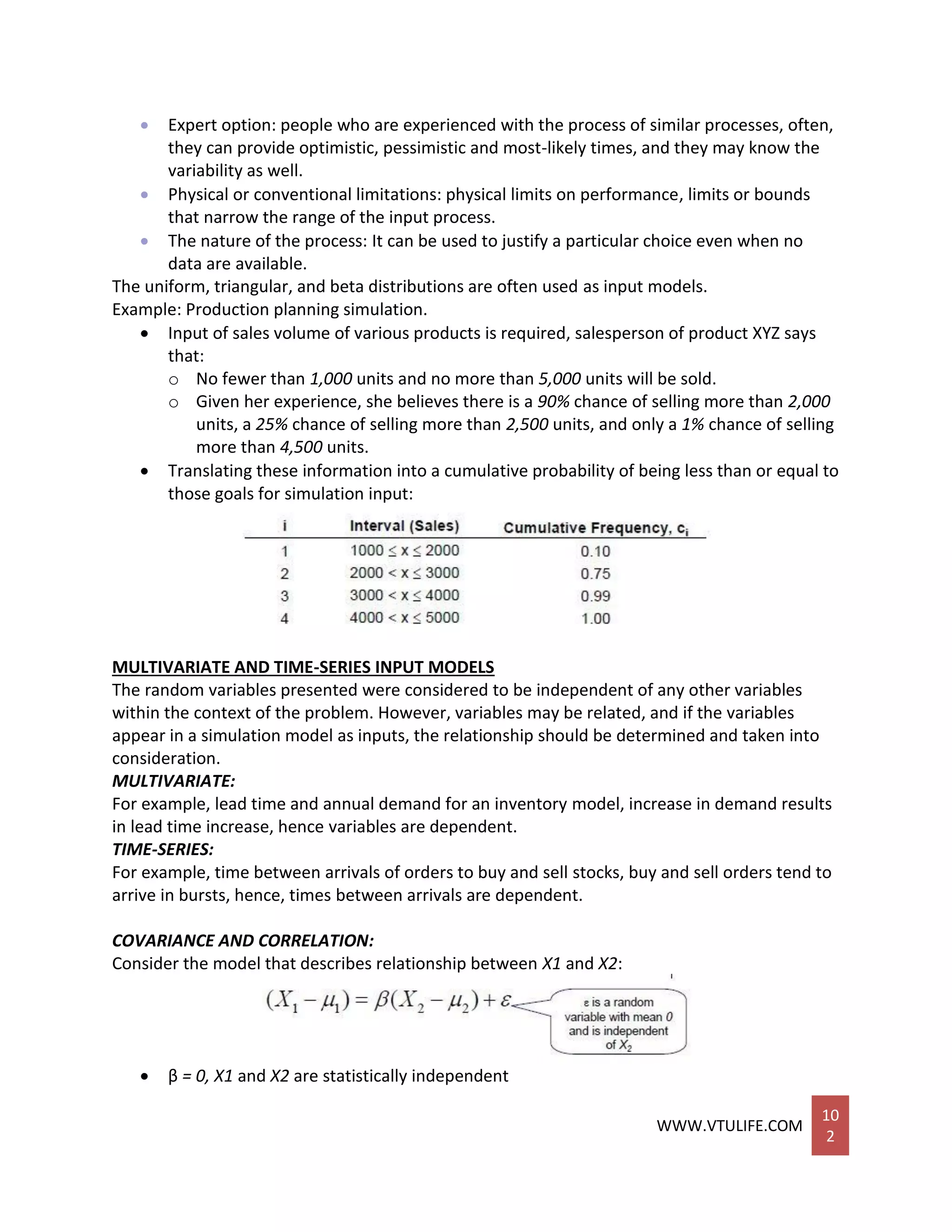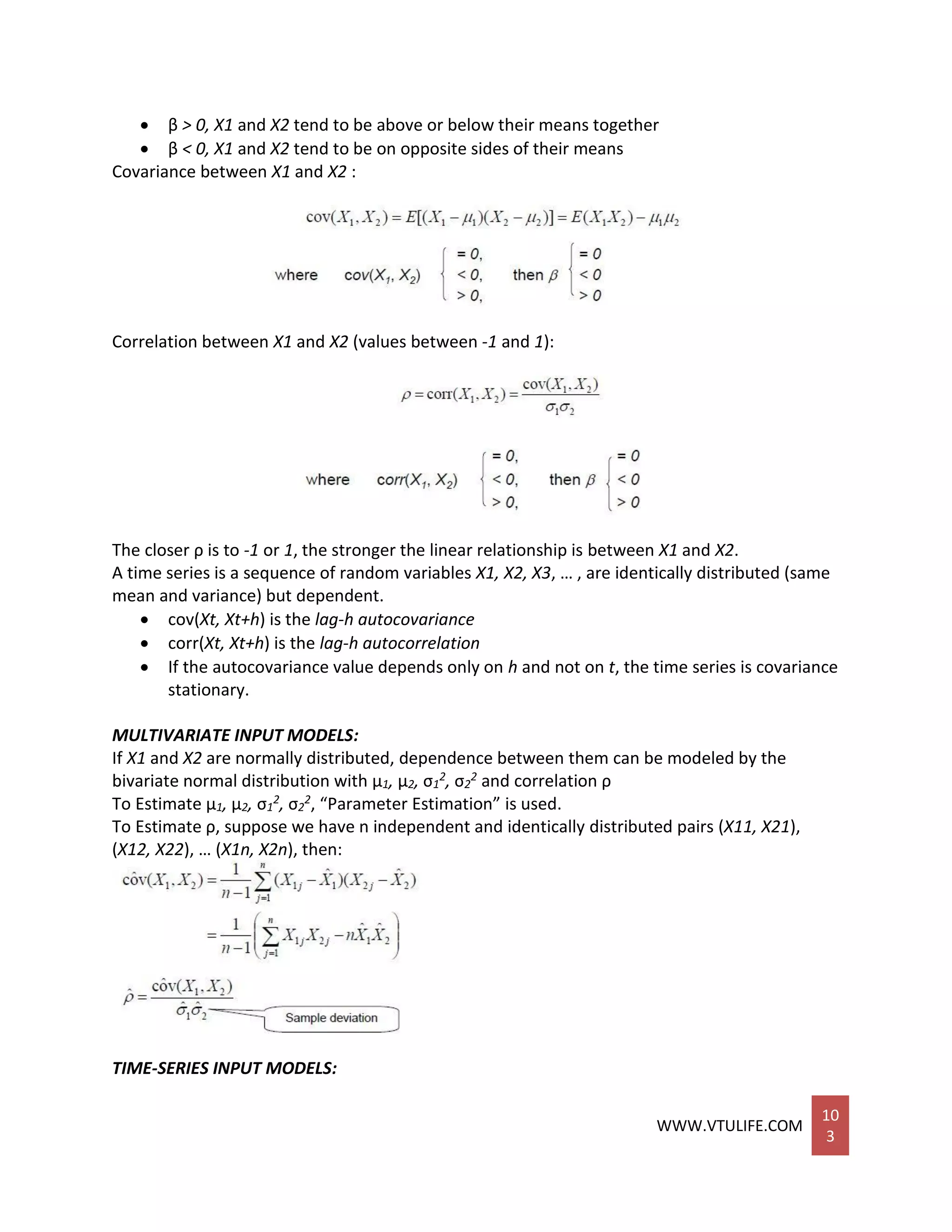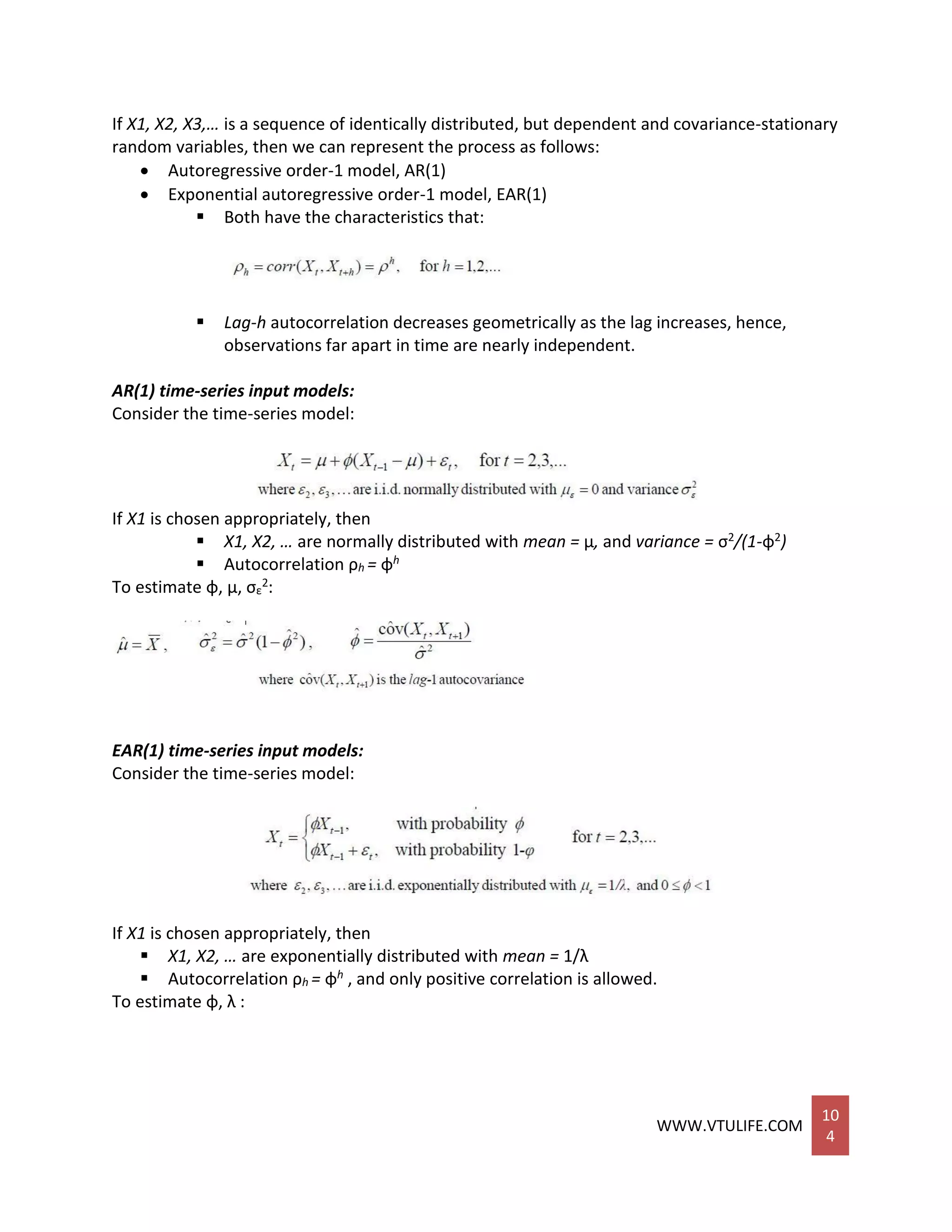This document provides an overview of system simulation and modelling. It discusses when simulation is an appropriate tool and areas it can be applied, including manufacturing, semiconductors, construction, the military, logistics and healthcare. Simulation allows experimenting with systems to study their behavior over time without disrupting operations. It enables testing new designs and policies. The document also covers system components like entities, attributes, and activities, and defines a system and its environment.
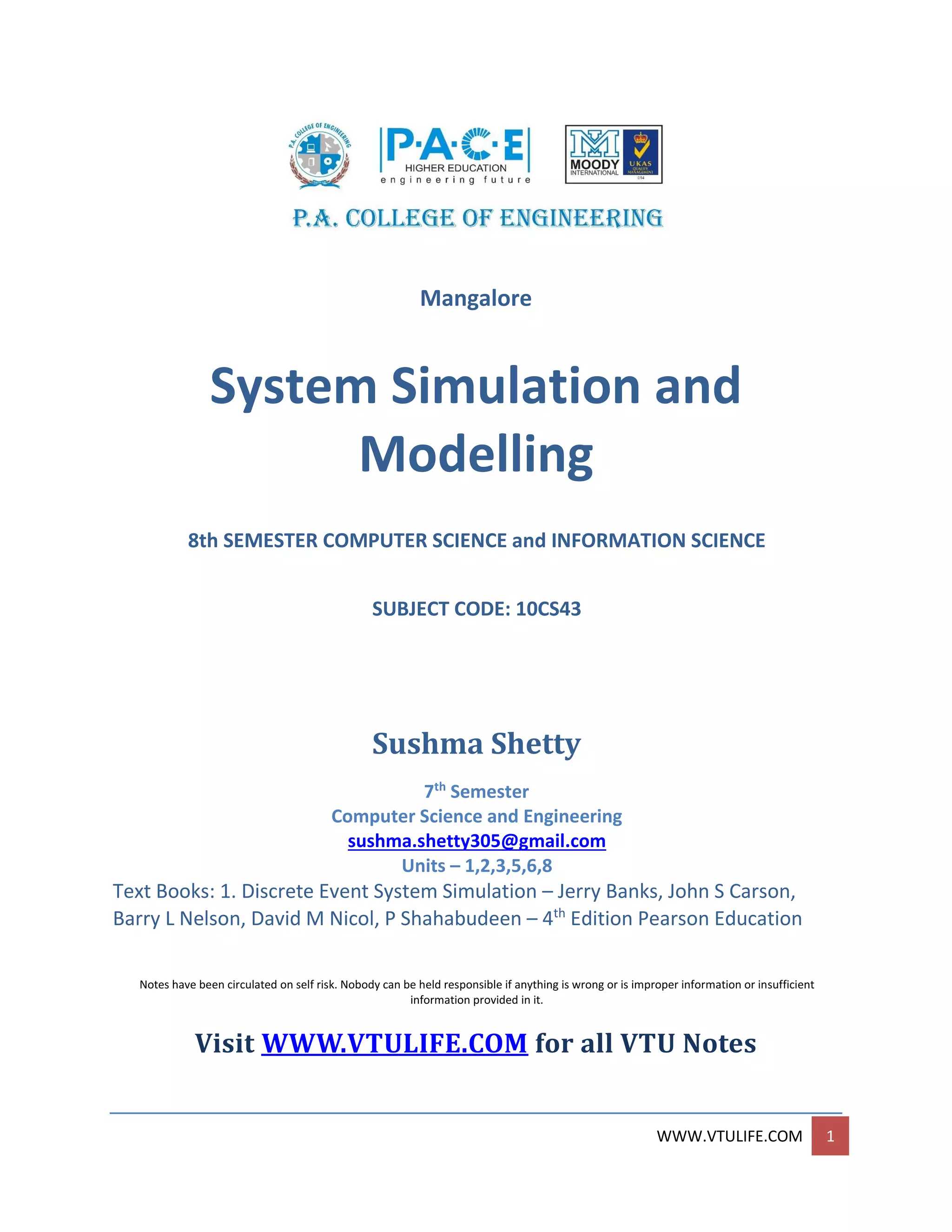
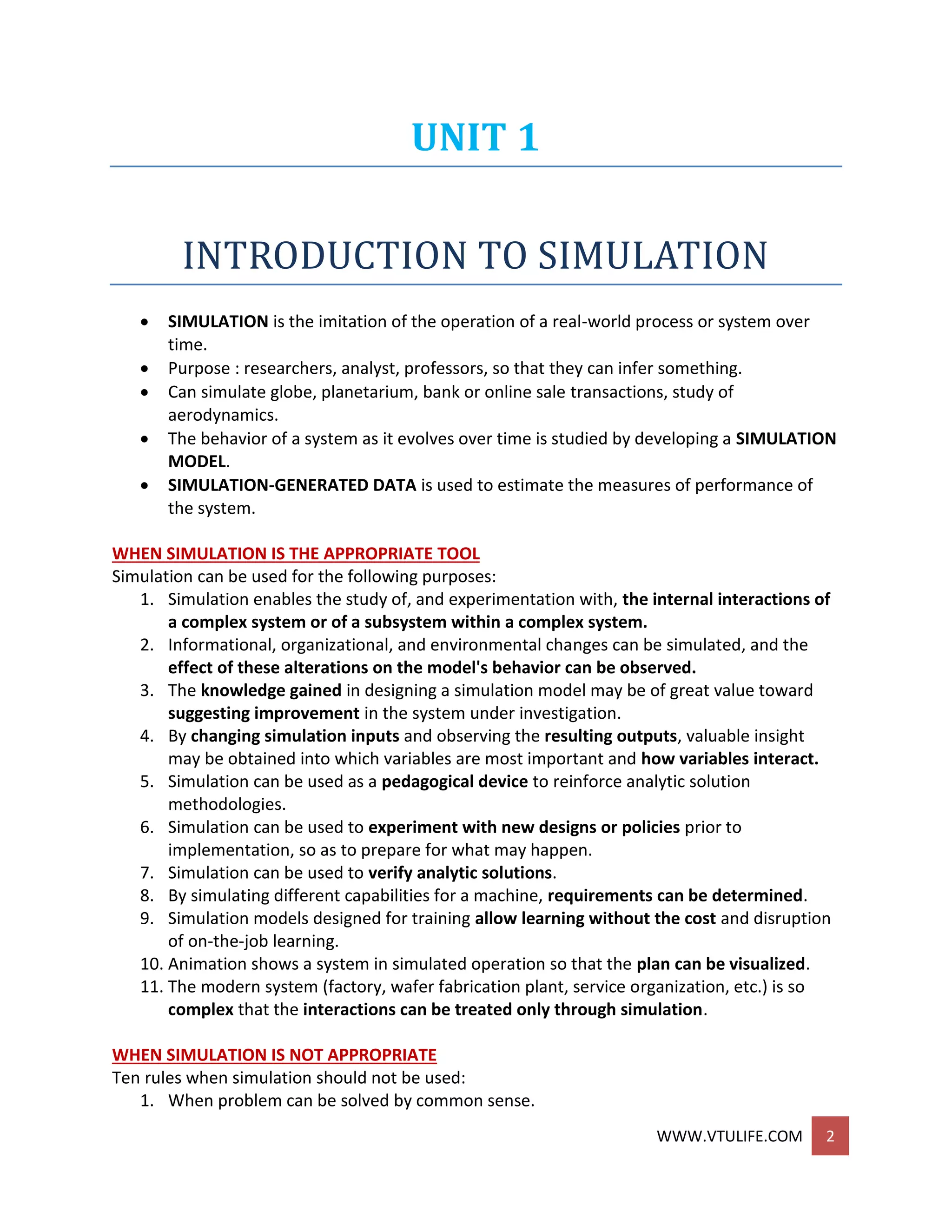
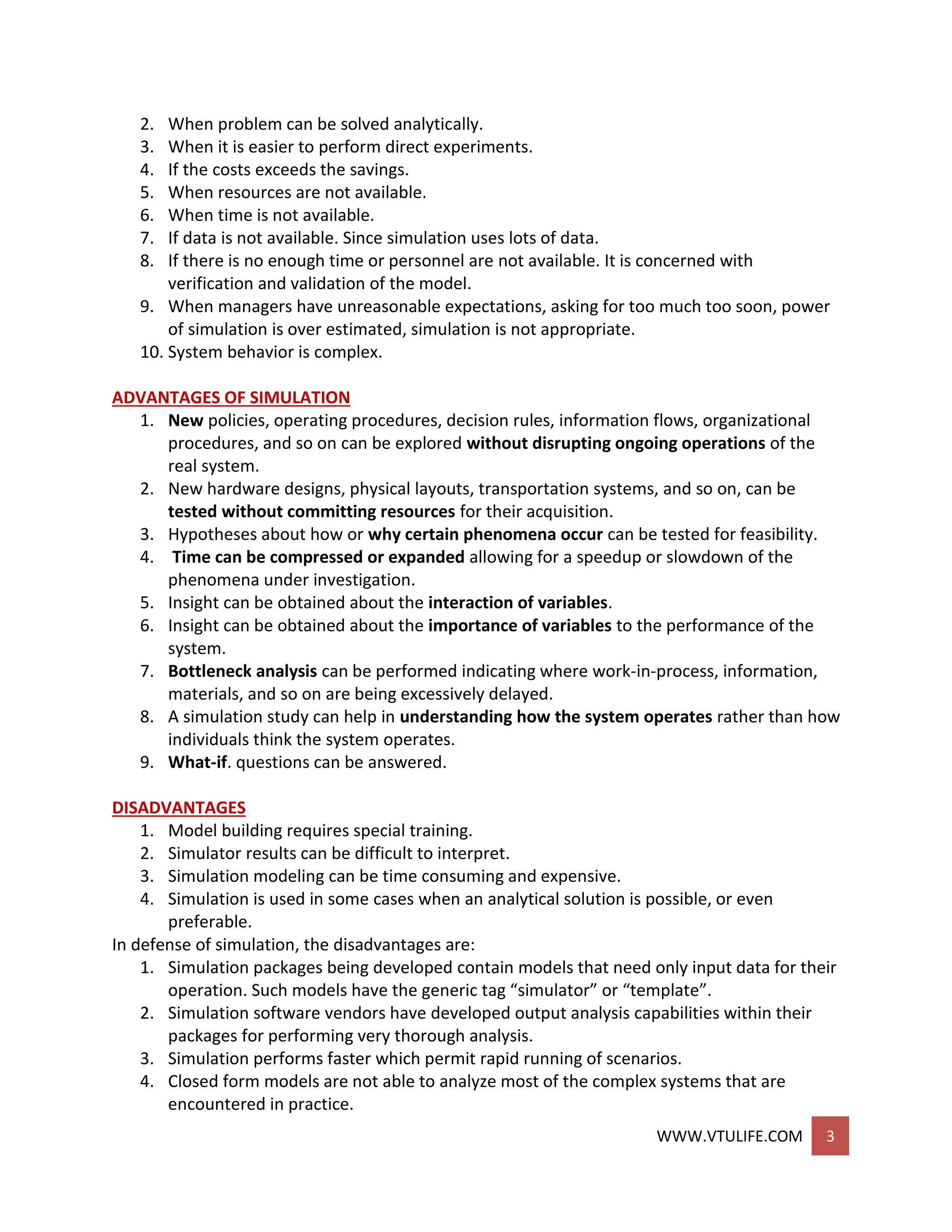
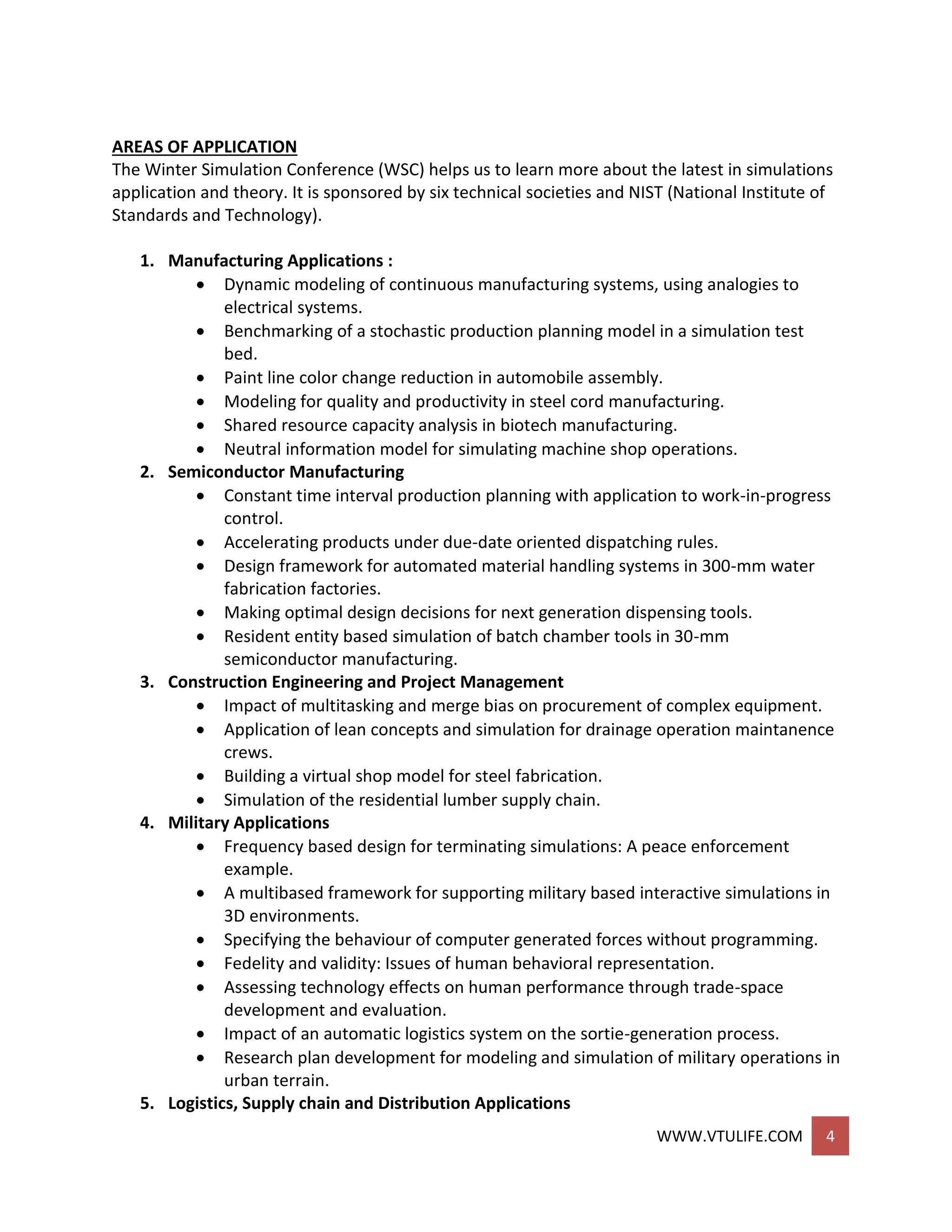
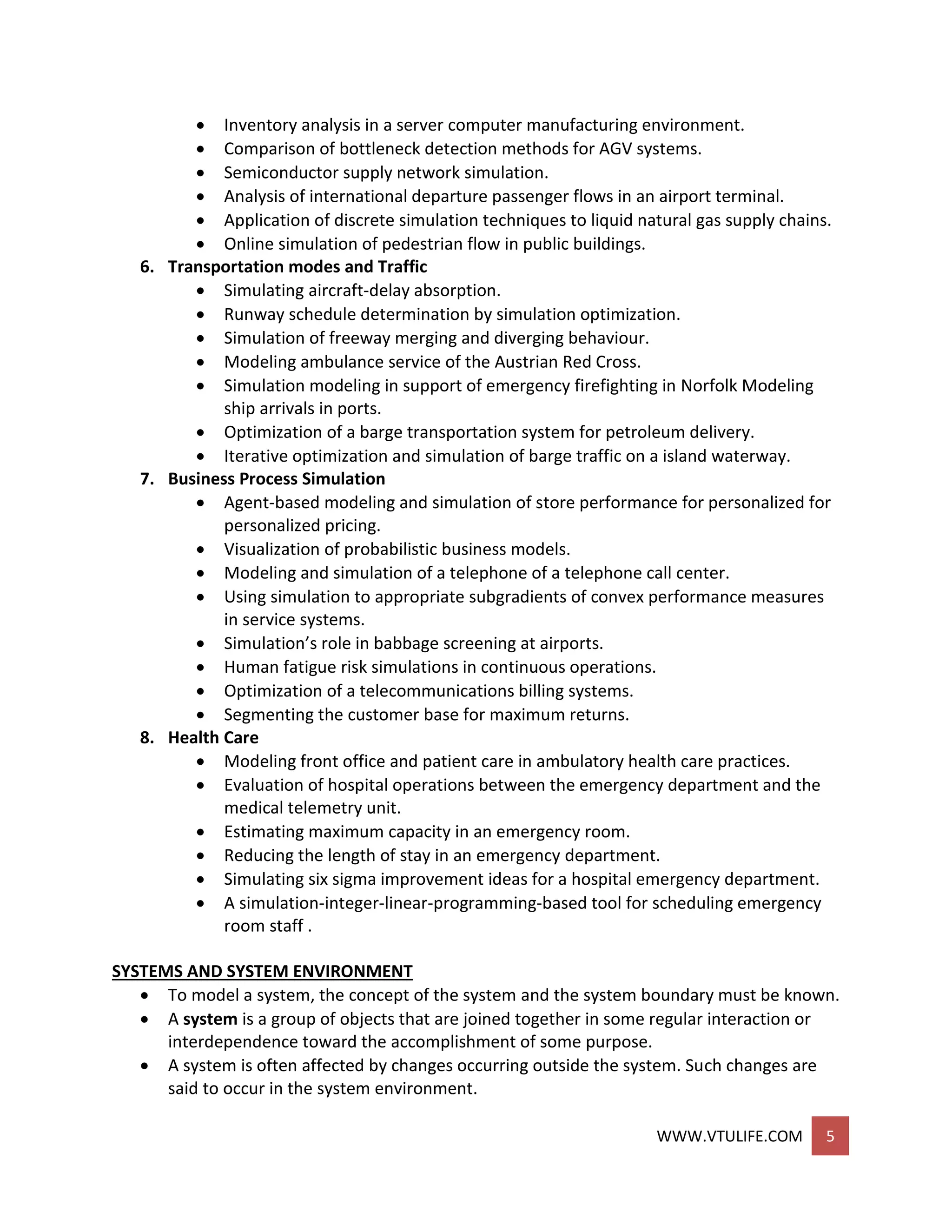
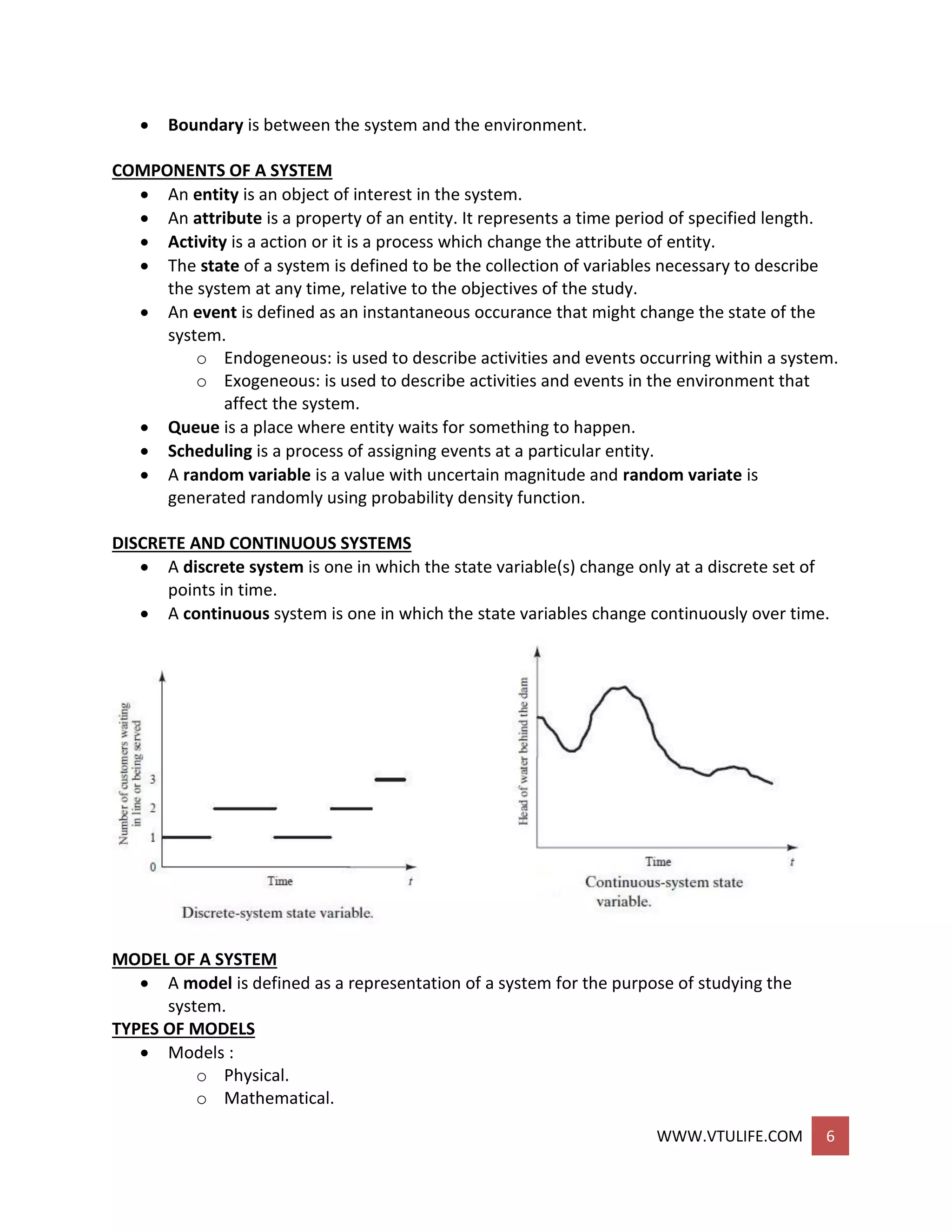
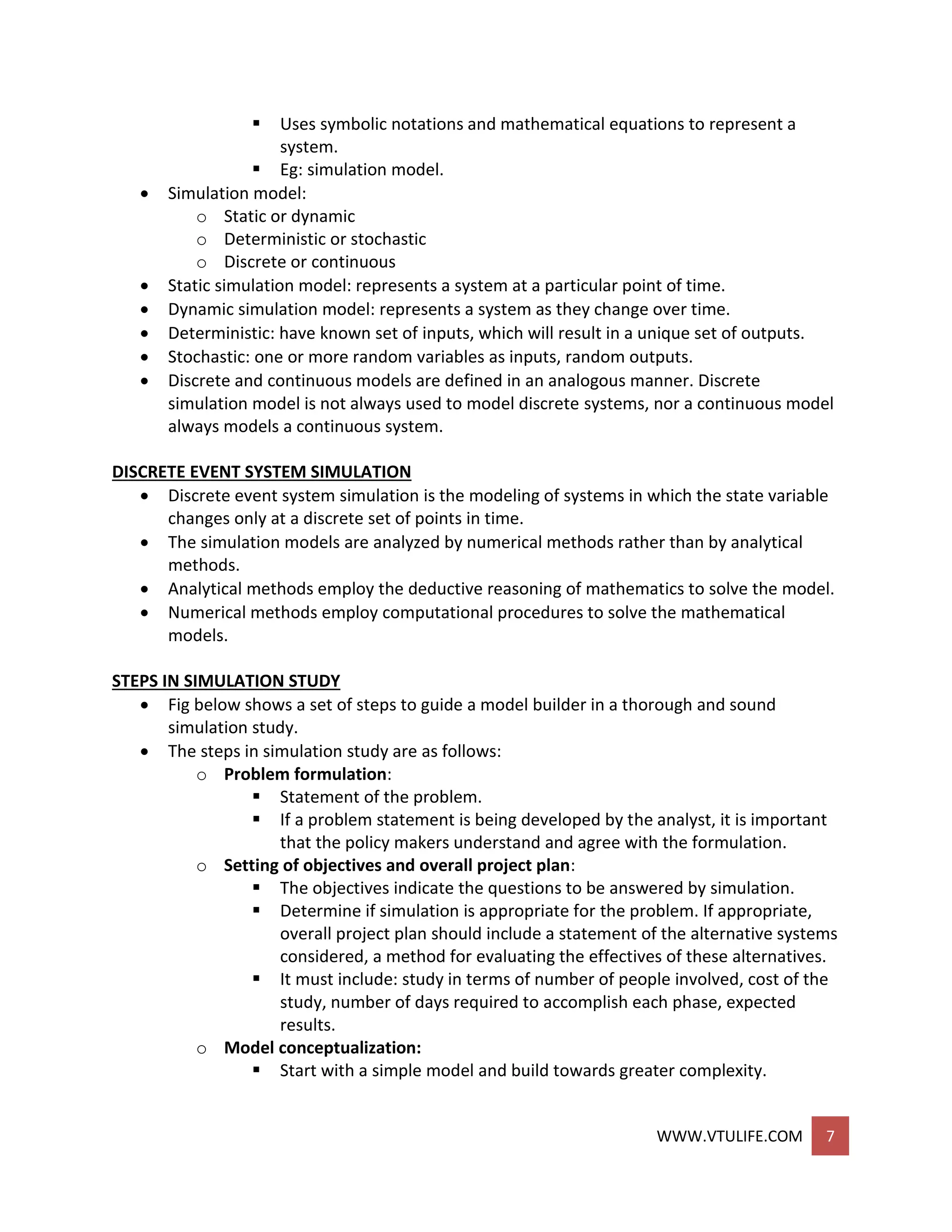

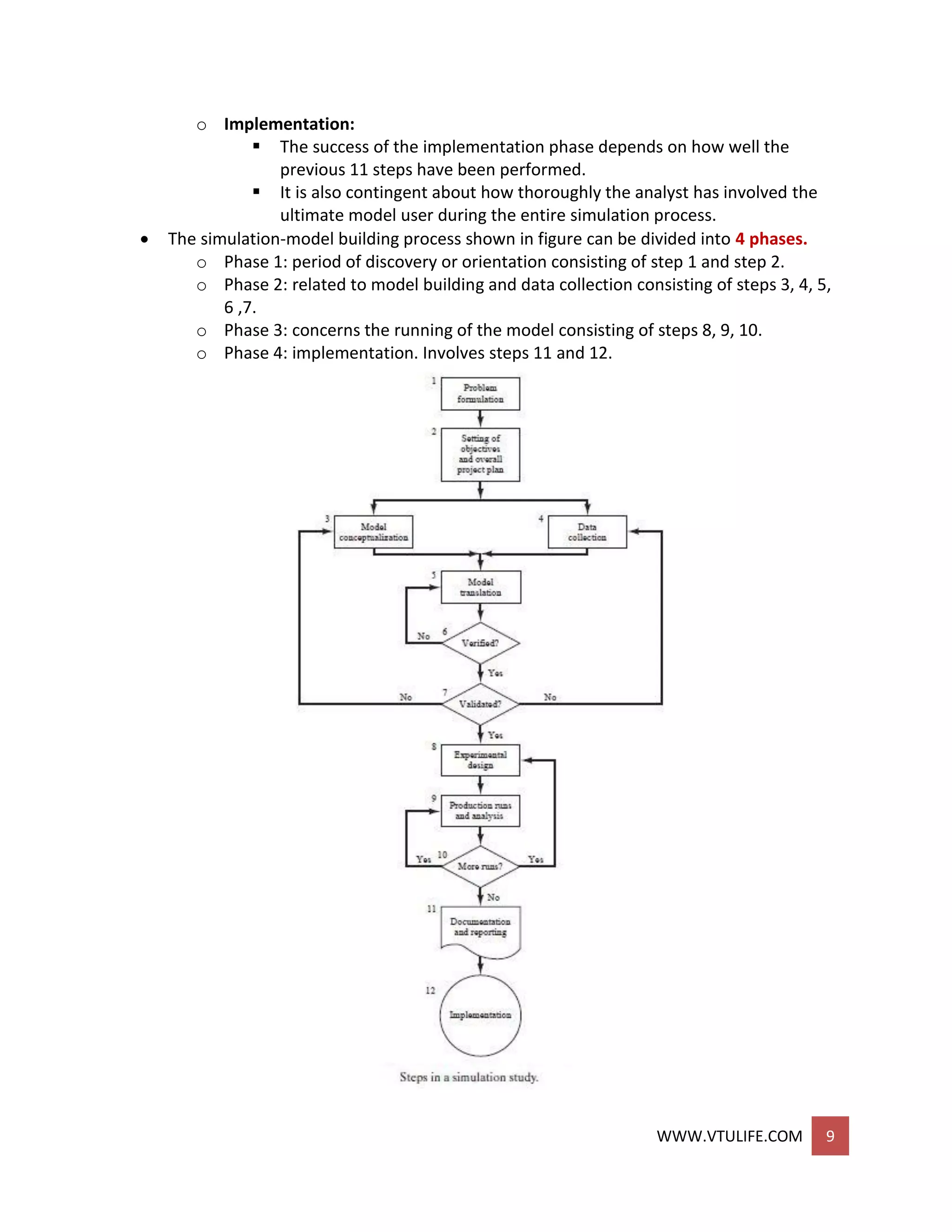
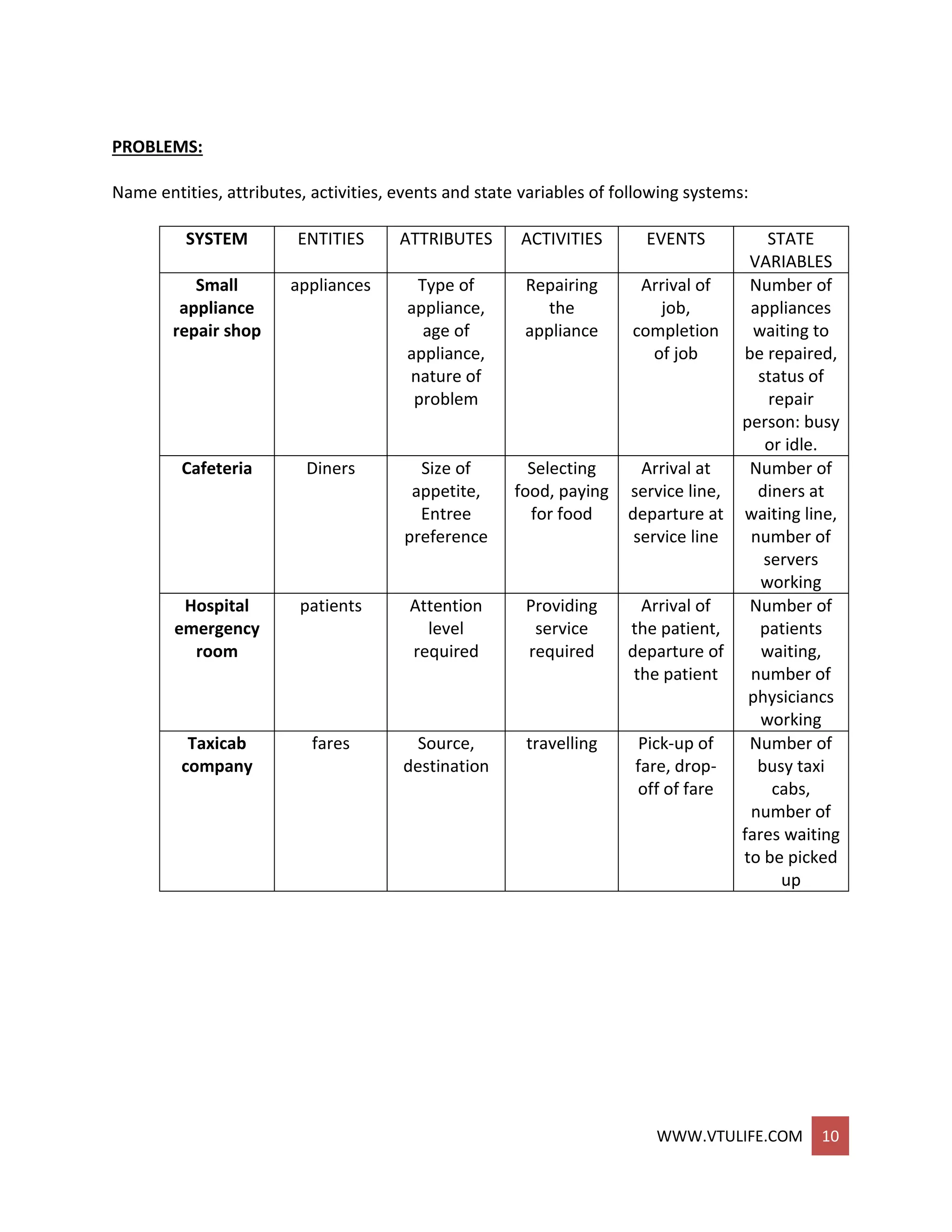
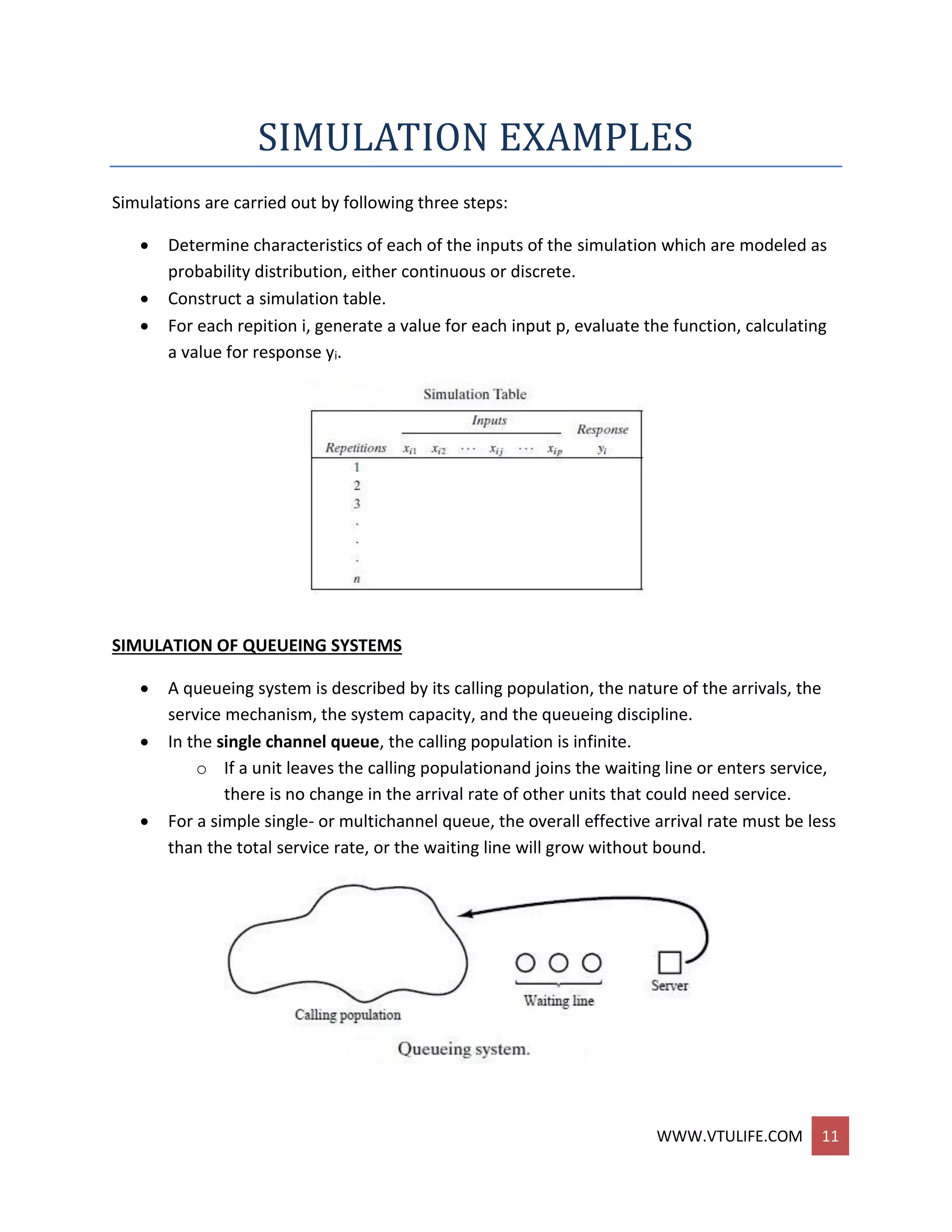
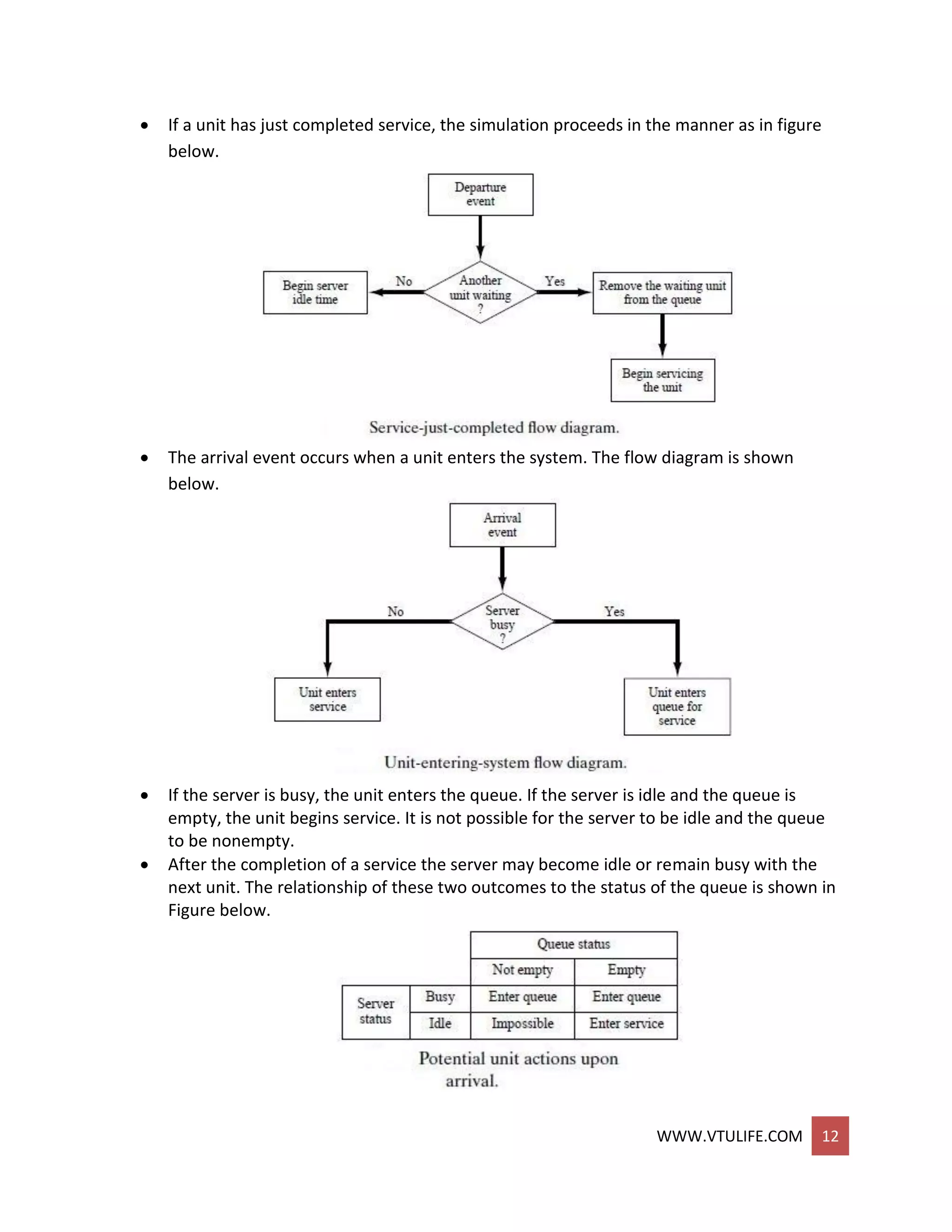
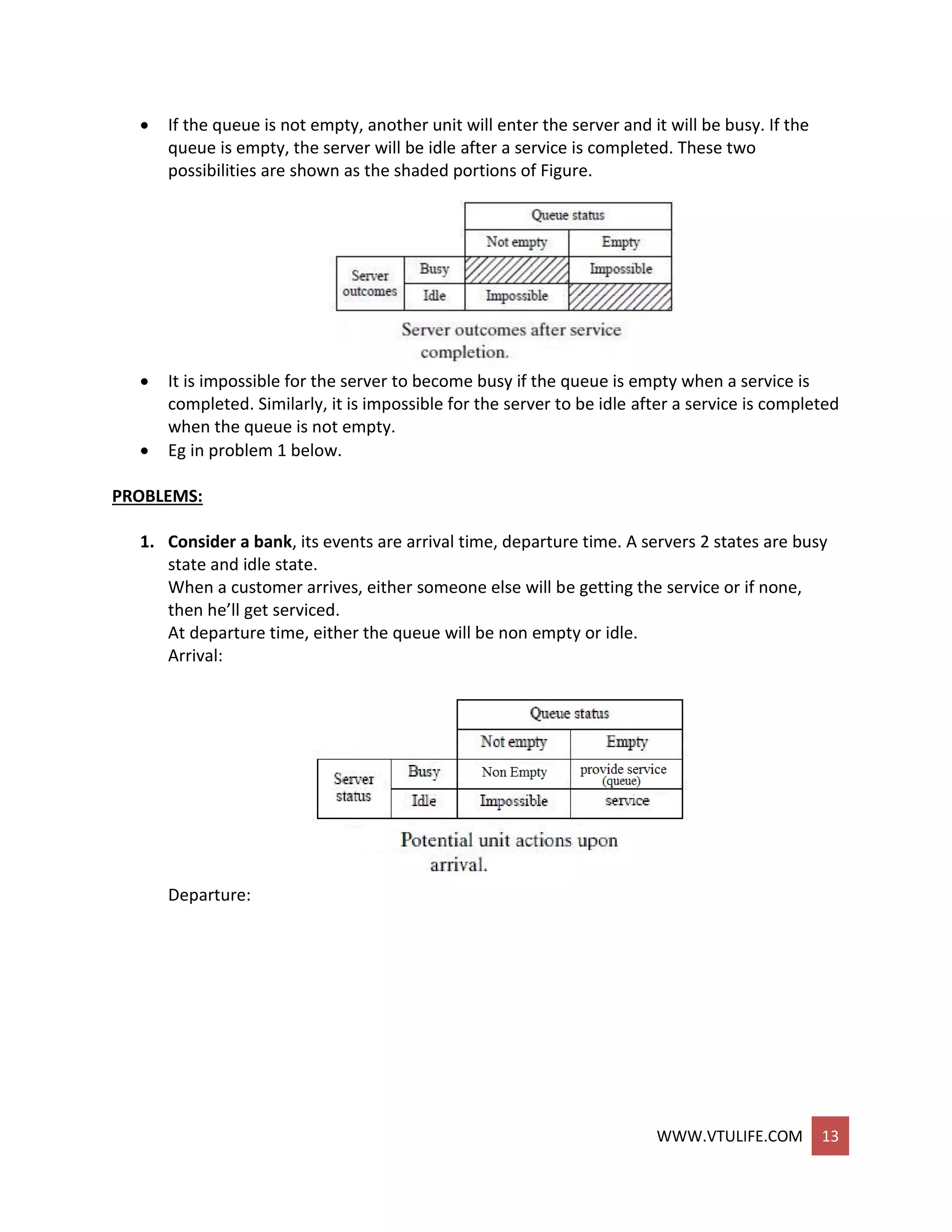
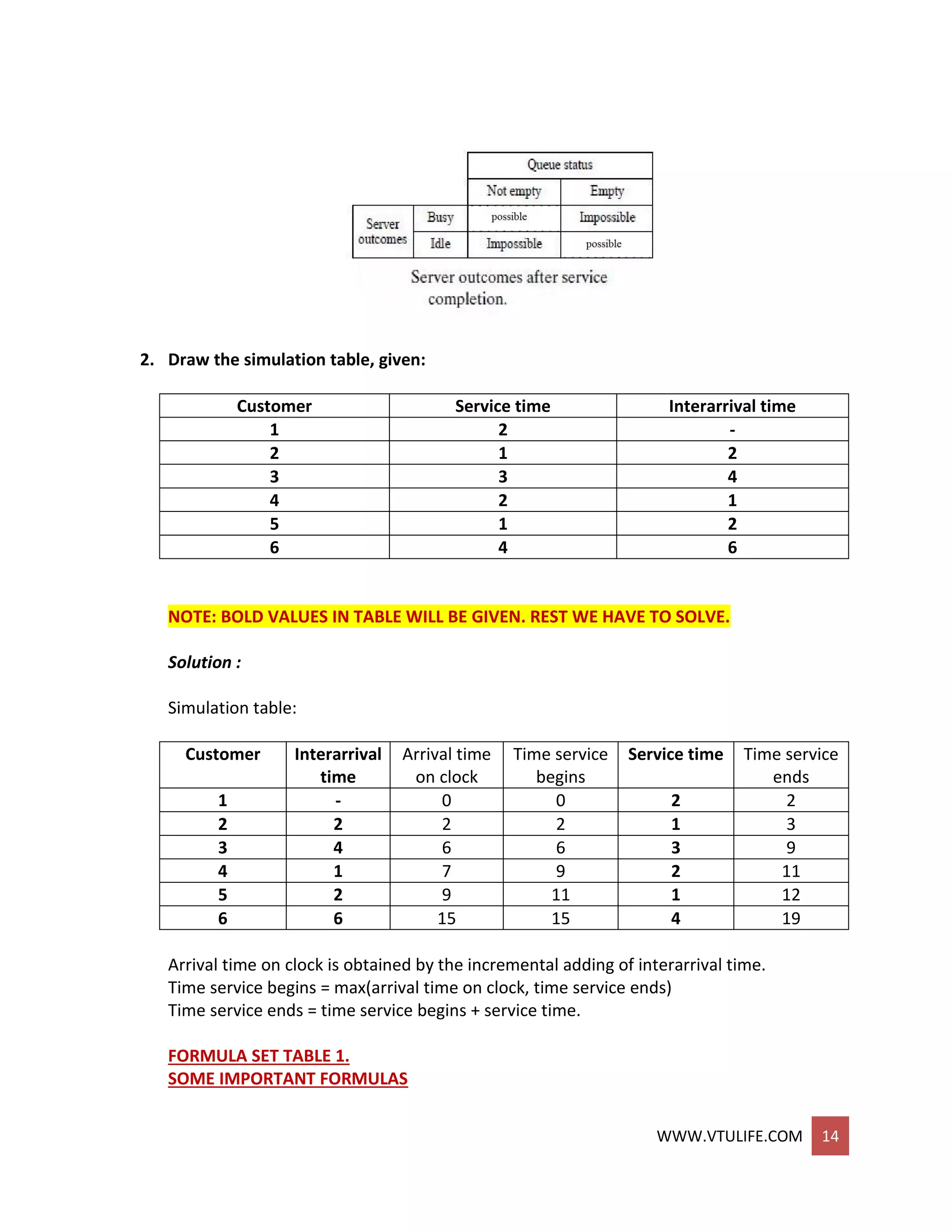
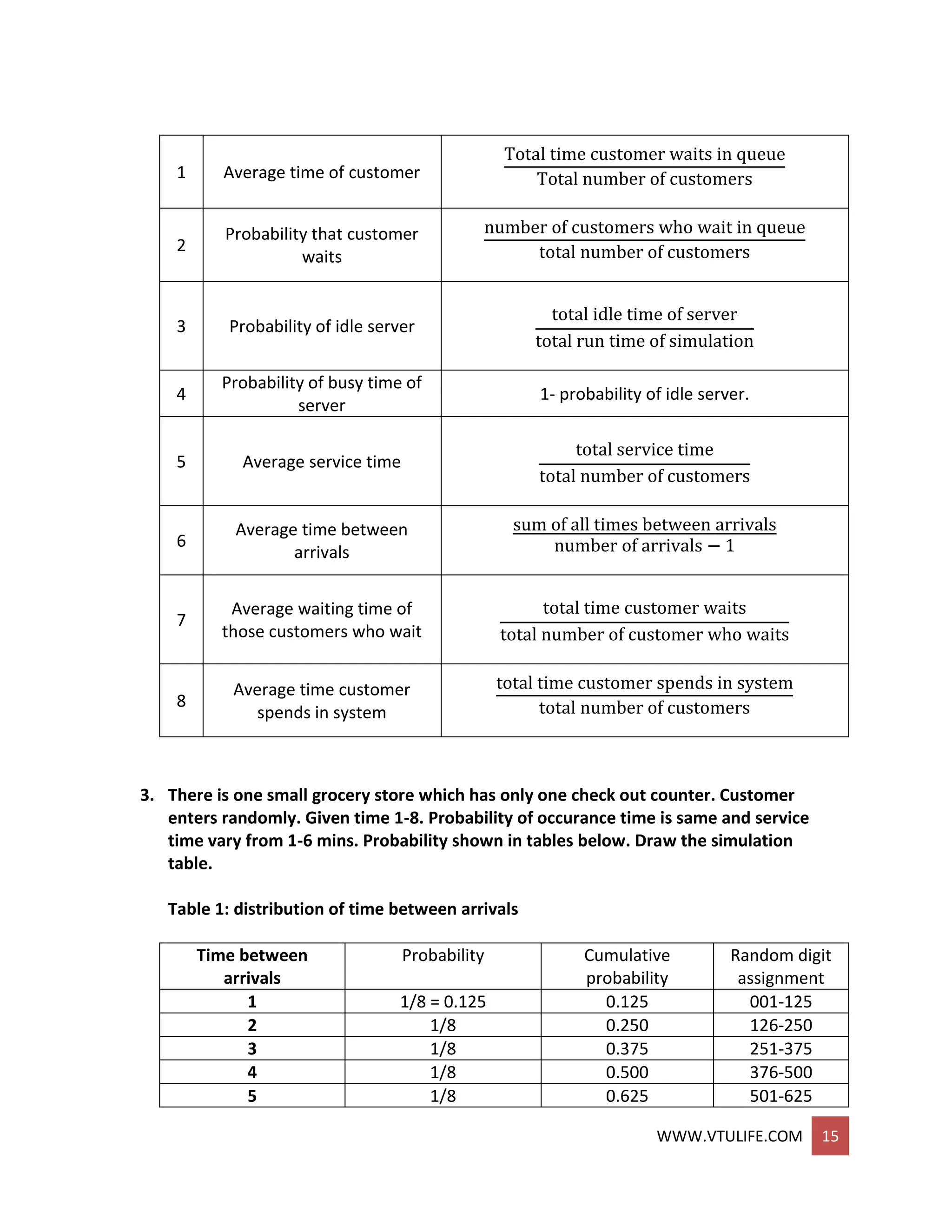
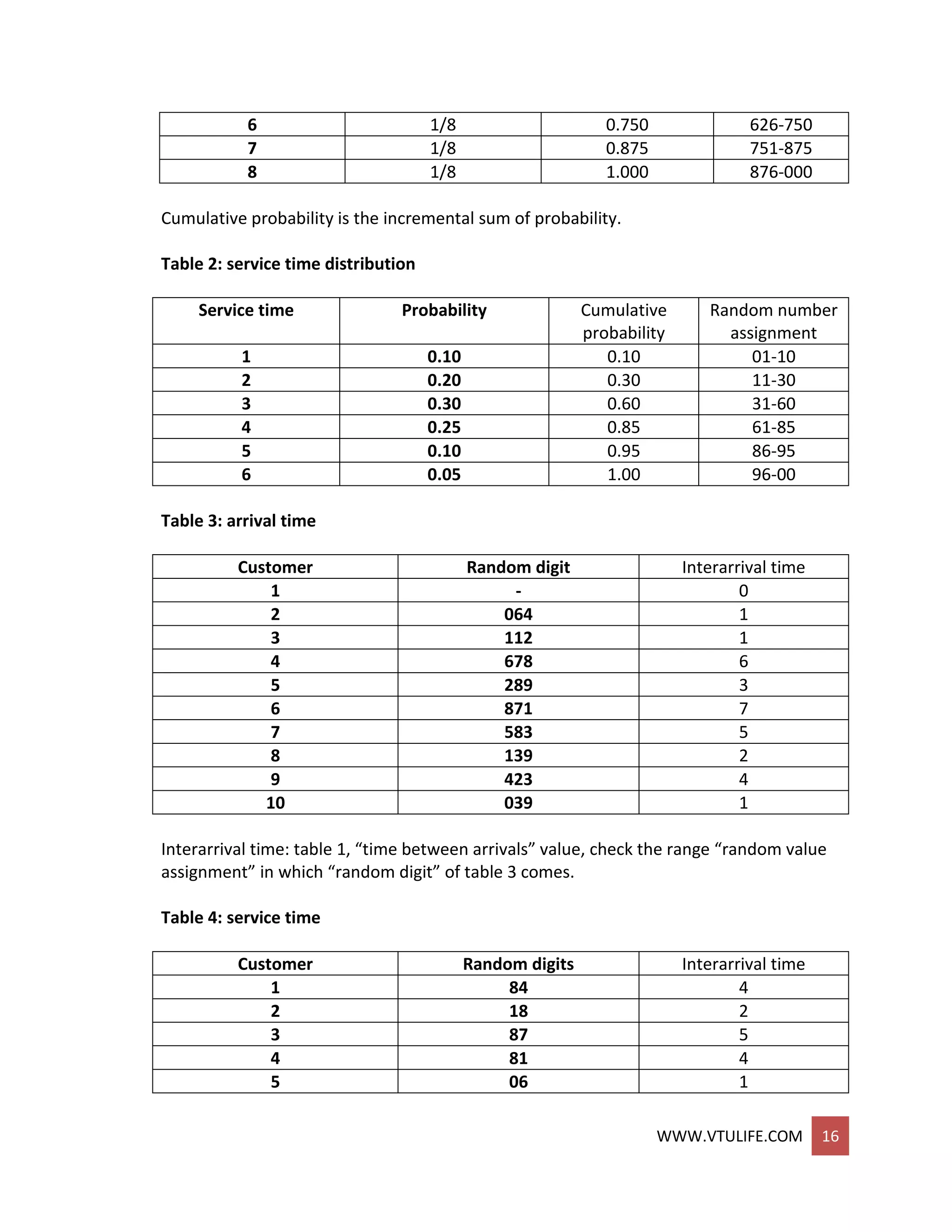
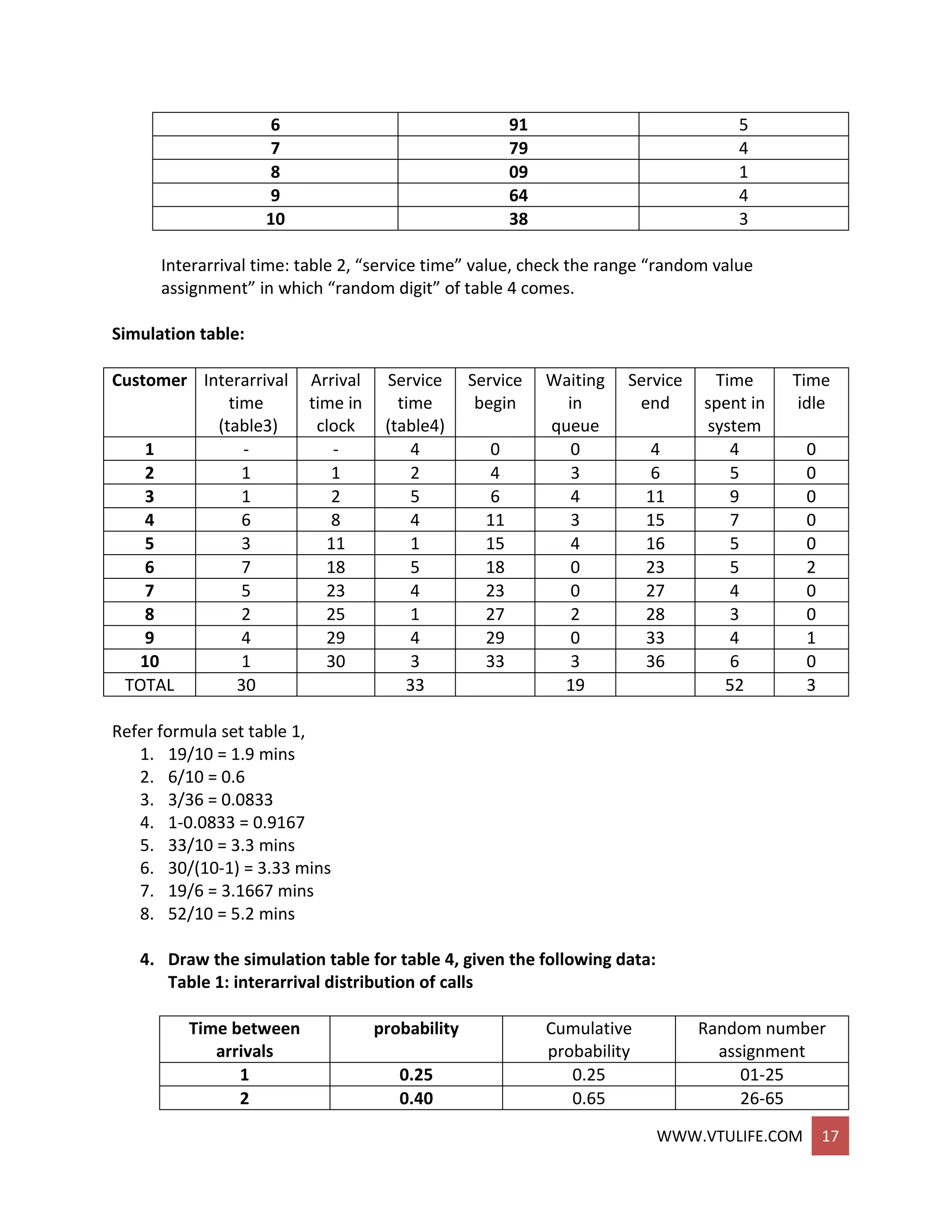
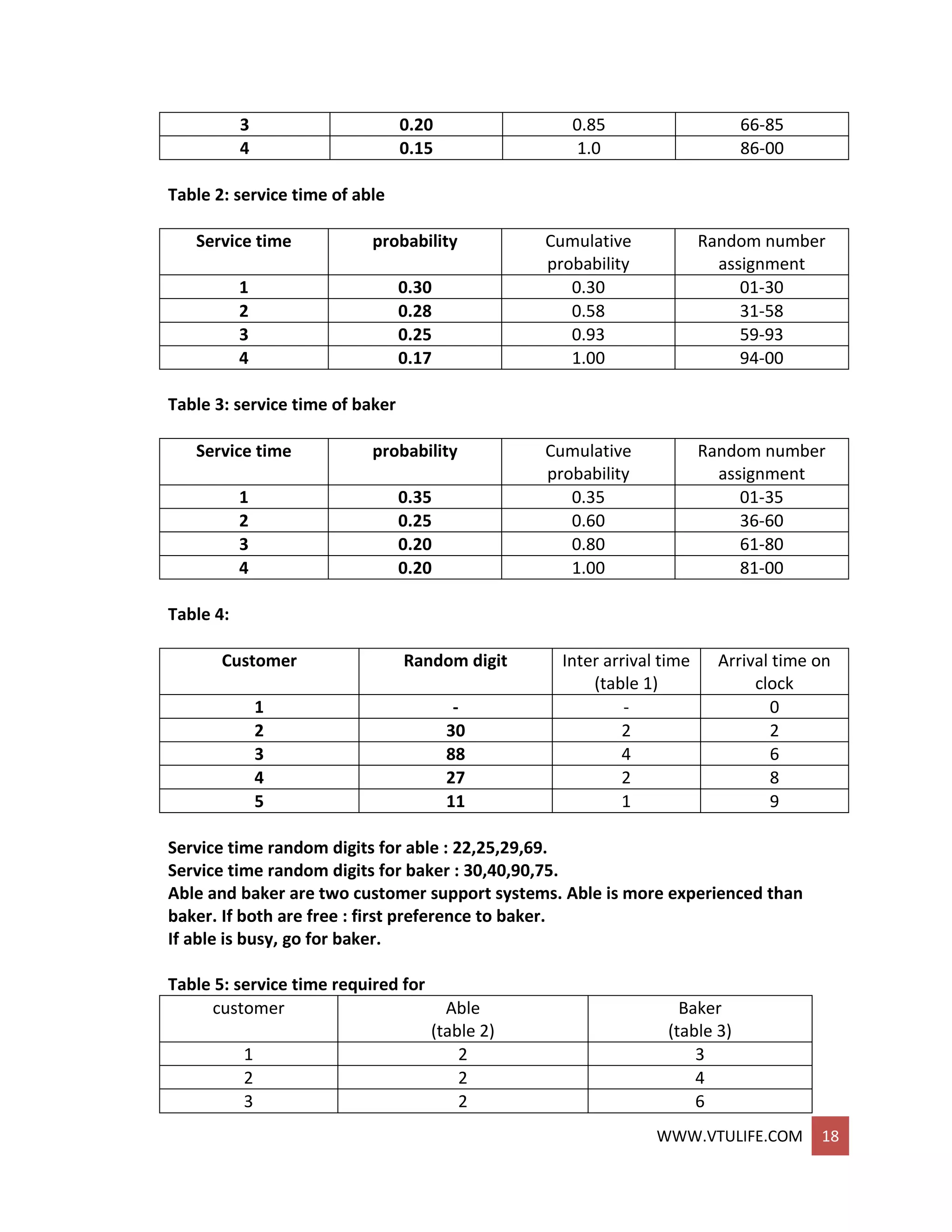

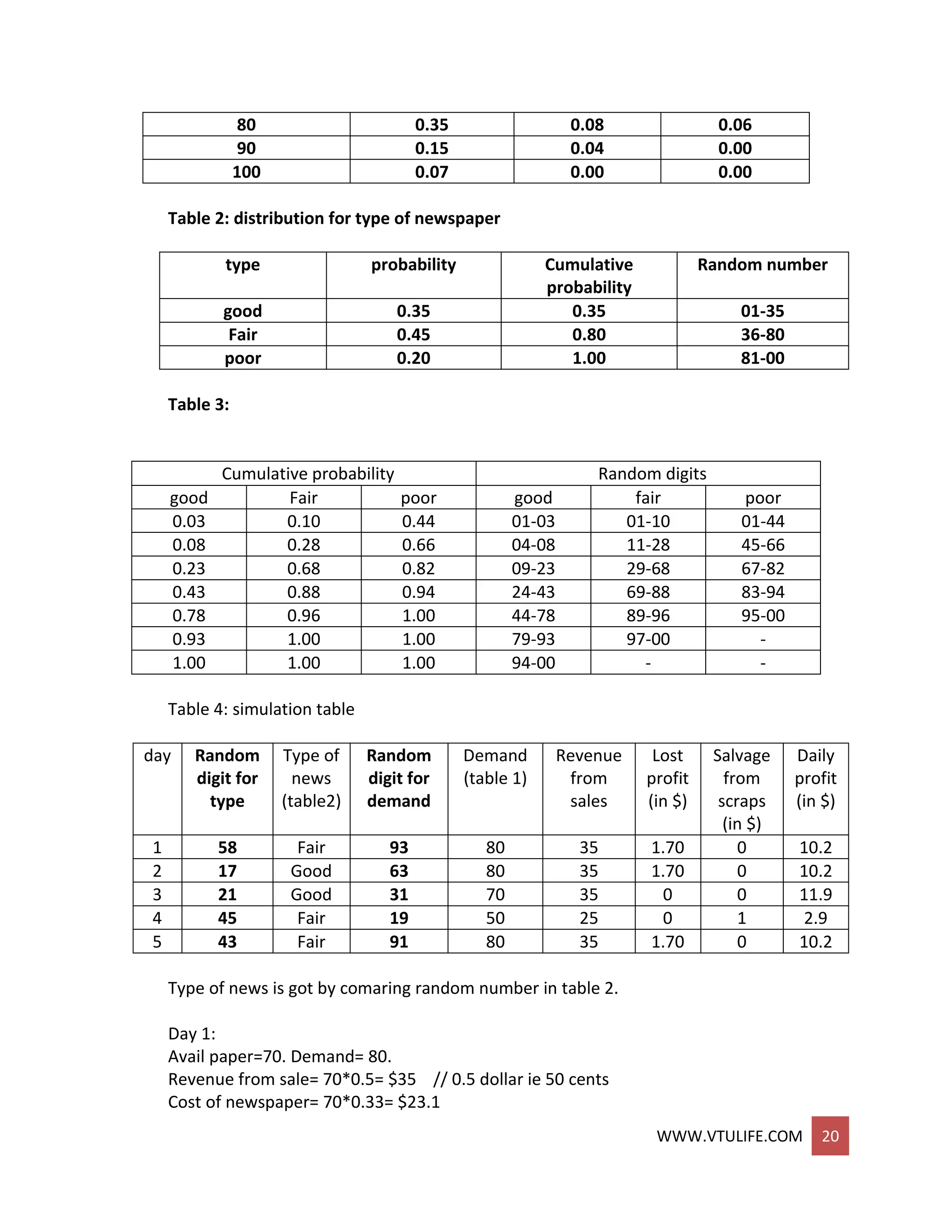
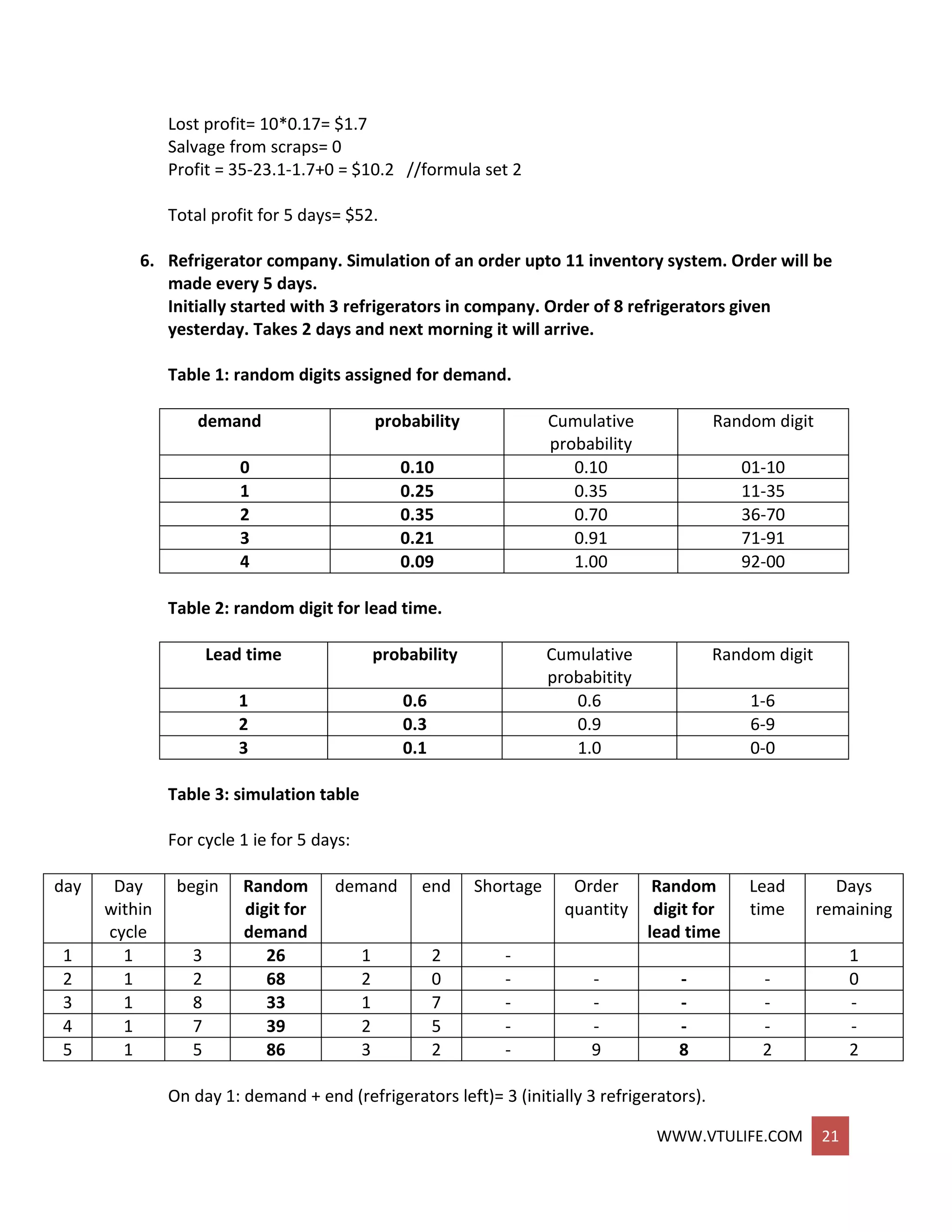
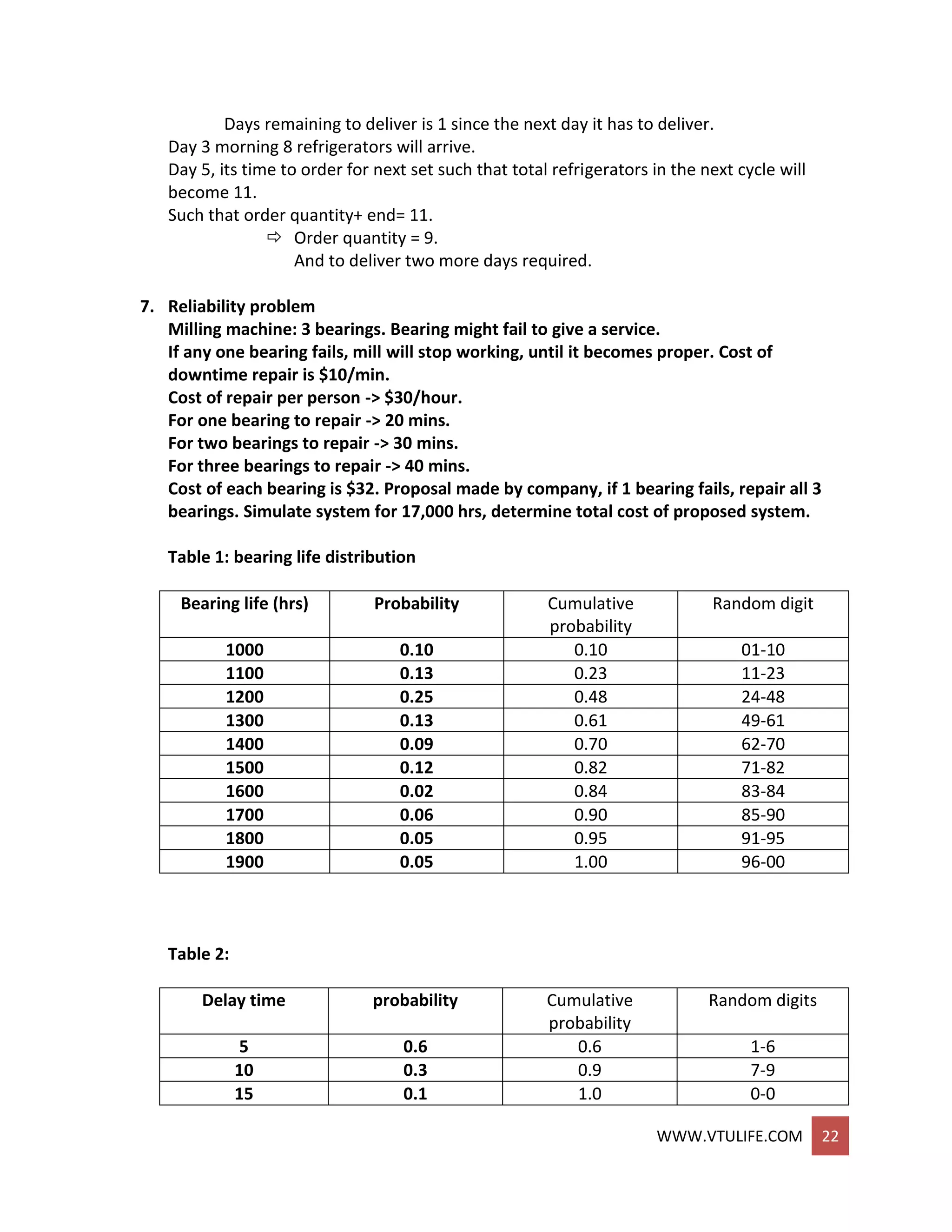
![WWW.VTULIFE.COM 23
Table 3: bearing replacement under current methods.
Bearing 1 Bearing 2 Bearing 3
RDa life RD delay RDb life RD delay RDc life RD delay
67 1400 7 10 71 1500 8 10 18 1100 6 5
57 1300 3 5 21 1100 3 5 17 1100 2 5
98 1900 1 5 79 1500 3 5 65 1400 2 5
76 1500 6 5 88 1700 1 5 3 1000 9 10
53 1300 4 5 93 1800 0 15 54 1300 8 10
69 1400 8 10 77 1500 6 5 17 1100 3 5
80 1500 5 5 8 1000 9 10 19 1100 6 5
93 1800 7 5 21 1100 8 10 9 1000 7 10
35 1200 0 10 13 1100 3 5 61 1300 1 5
02 1000 5 5 3 1000 2 5 84 1600 0 15
99 1900 9 10 14 1100 1 5 11 1100 5 5
65 1400 4 5 5 1000 0 15 25 1200 2 5
53 1300 7 10 29 1200 2 5 86 1700 8 10
87 1700 1 5 7 1000 4 5 65 1400 3 5
90 1700 2 5 20 1100 3 5 44 1200 4 5
total 22300 110 18700 110 18600 105
Number of bearings= 3 (bearings) * 15 (tuples) = 45.
Cost of bearings:
45 bearings * $32 / bearing = $1440
Cost of delay:
(110+110+105) * $10 / min = $3250
Cost of down time during repairs:
45 bearings * 20 min/ bearing * $30/60 min = $9000
Cost of repair person:
45 bearings * 20 min/ bearing * $30 / 60 min = $450
Total cost = $1440+ $3250+ $9000+ $450 = $14140
Total bearing 1+bearing 2+bearing 3 [life] = 22300+18700+18600 =
59600 hrs.
Total cost = $23720 // cross multiplication of
$14140 ---- 59600 hrs
? ---- 10000 hrs
New proposal:
Total bearing hours = 17000.
Delay to change = 110 hrs.
45 bearing * $32/bearing = $1440
Cost of delay = 110 * $10/min = $1100
45/3=15.](https://image.slidesharecdn.com/systemmodelingandsimulationfullnotesbysushmashettywww-190706073931/75/System-modeling-and-simulation-full-notes-by-sushma-shetty-www-vtulife-com-23-2048.jpg)

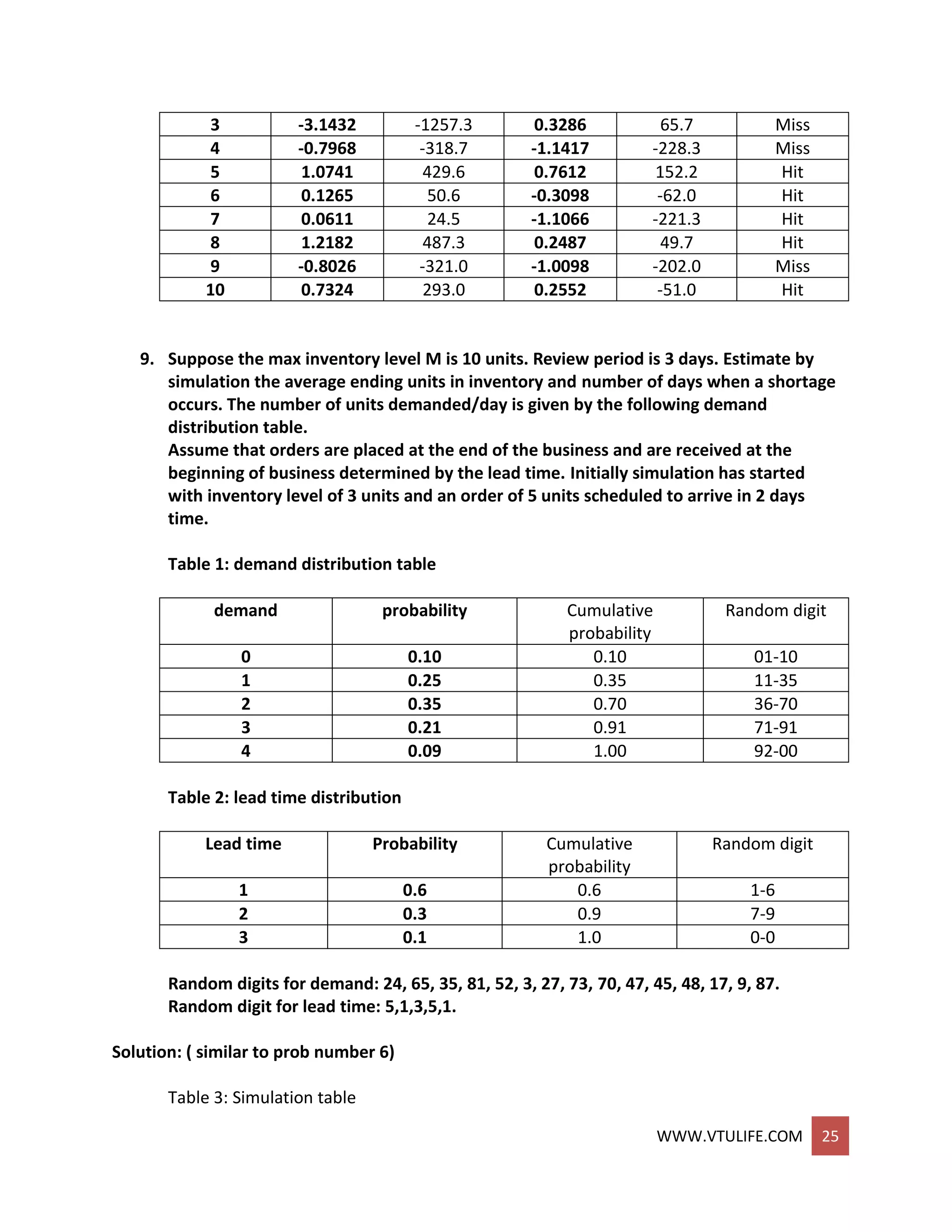

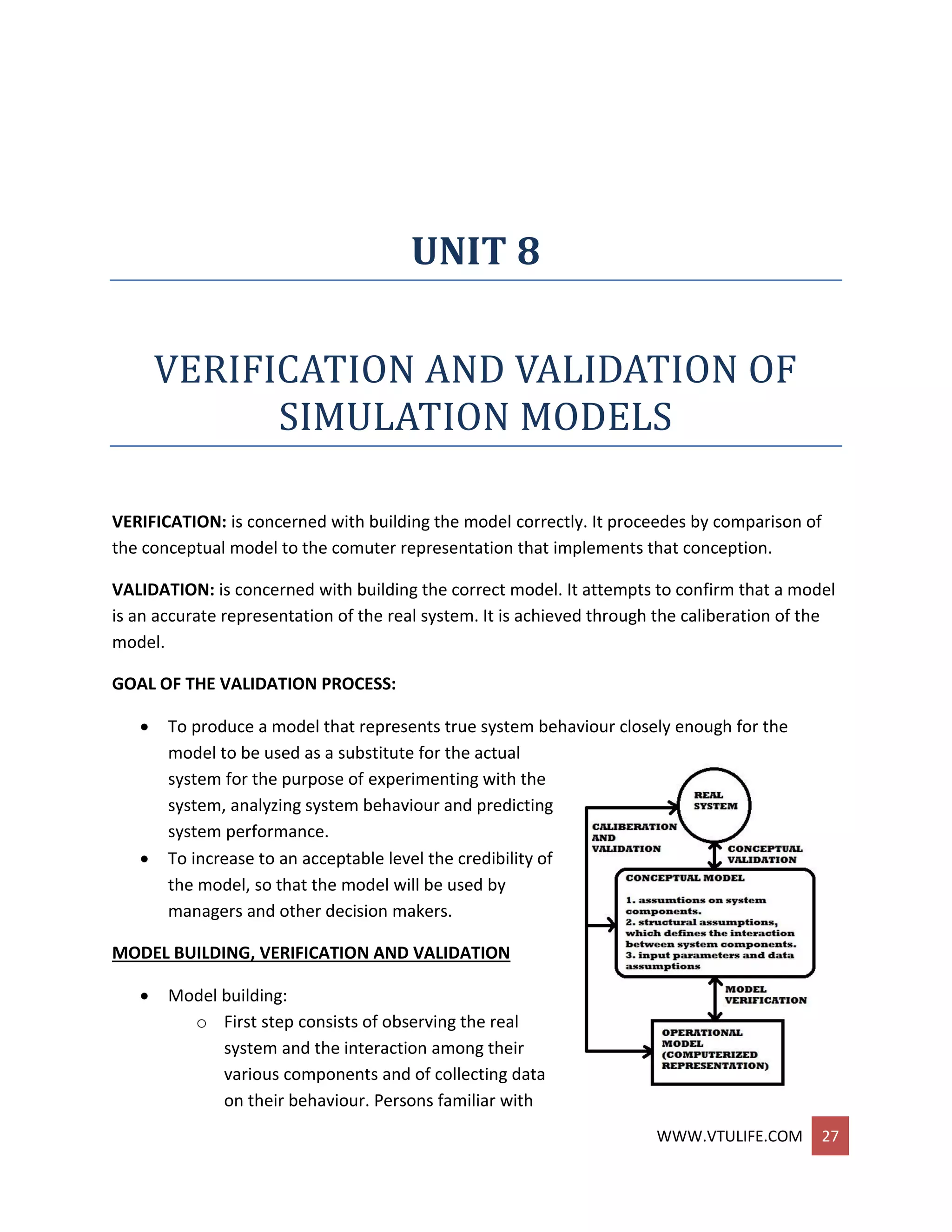
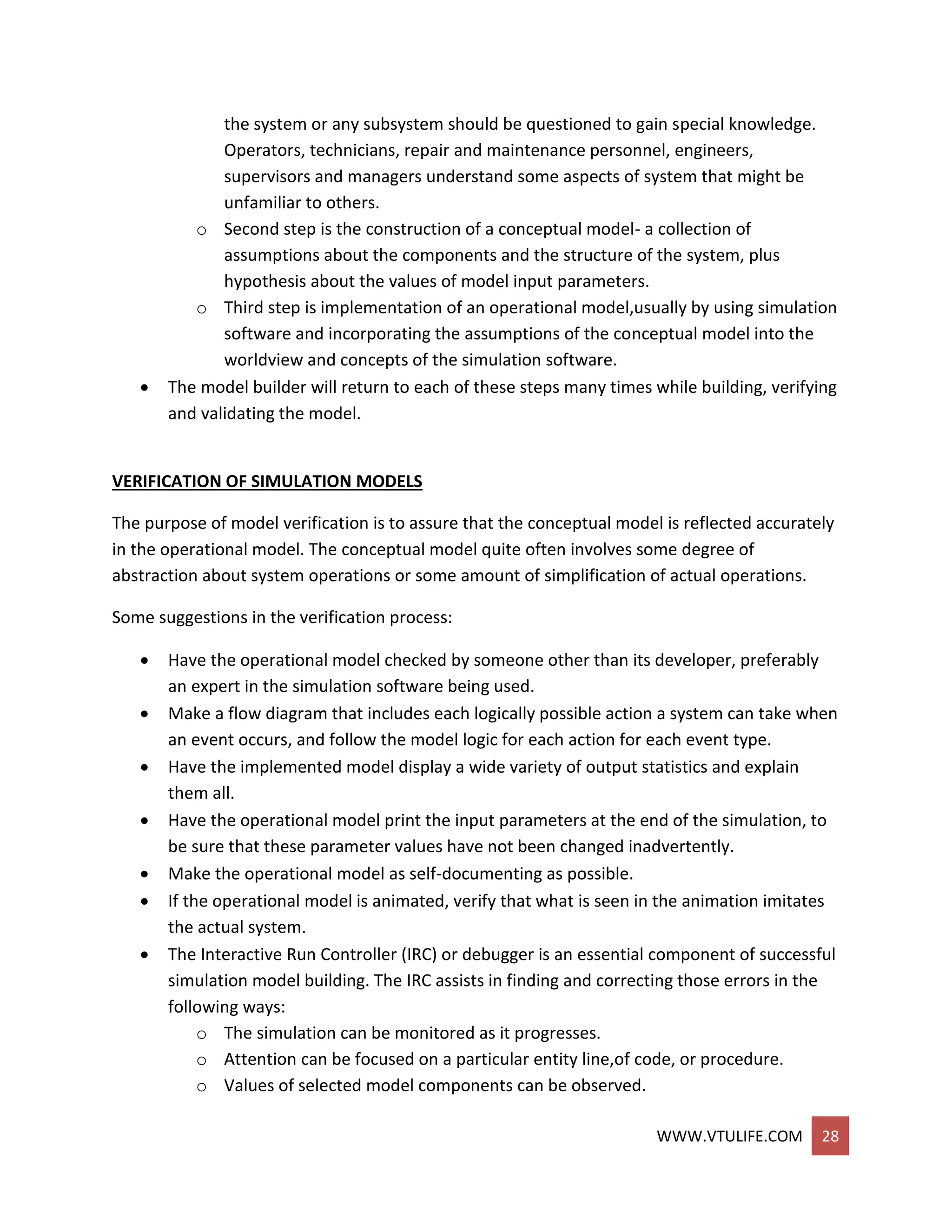
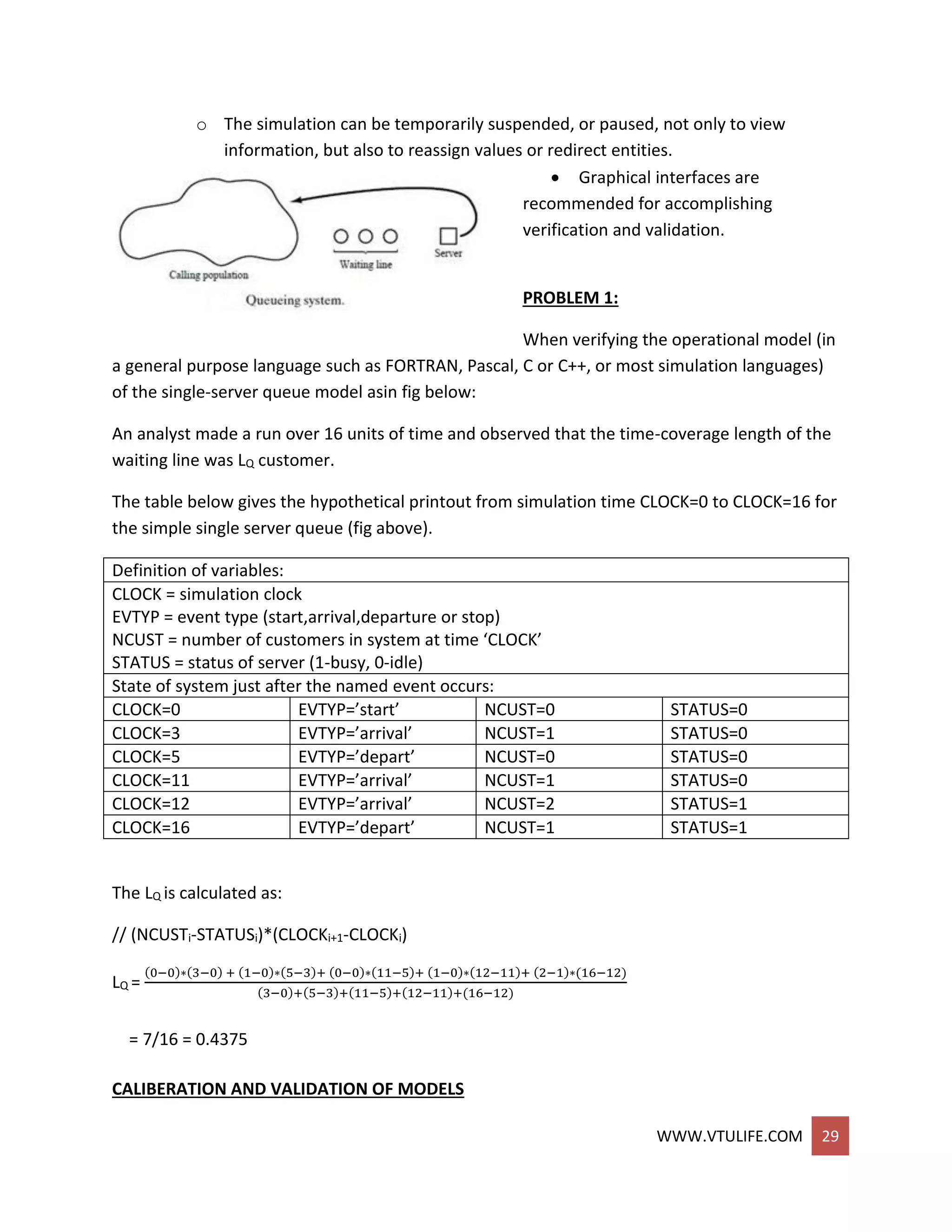
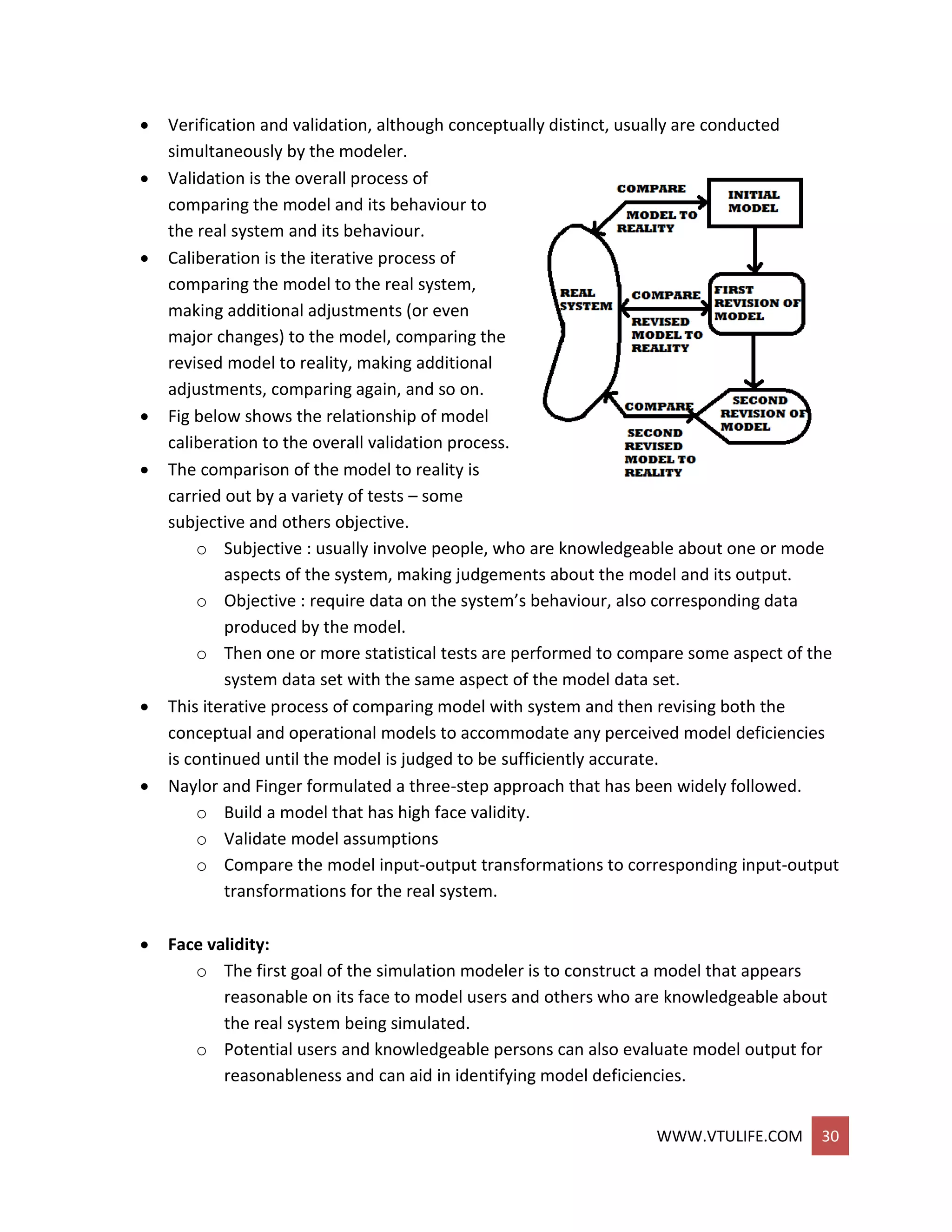
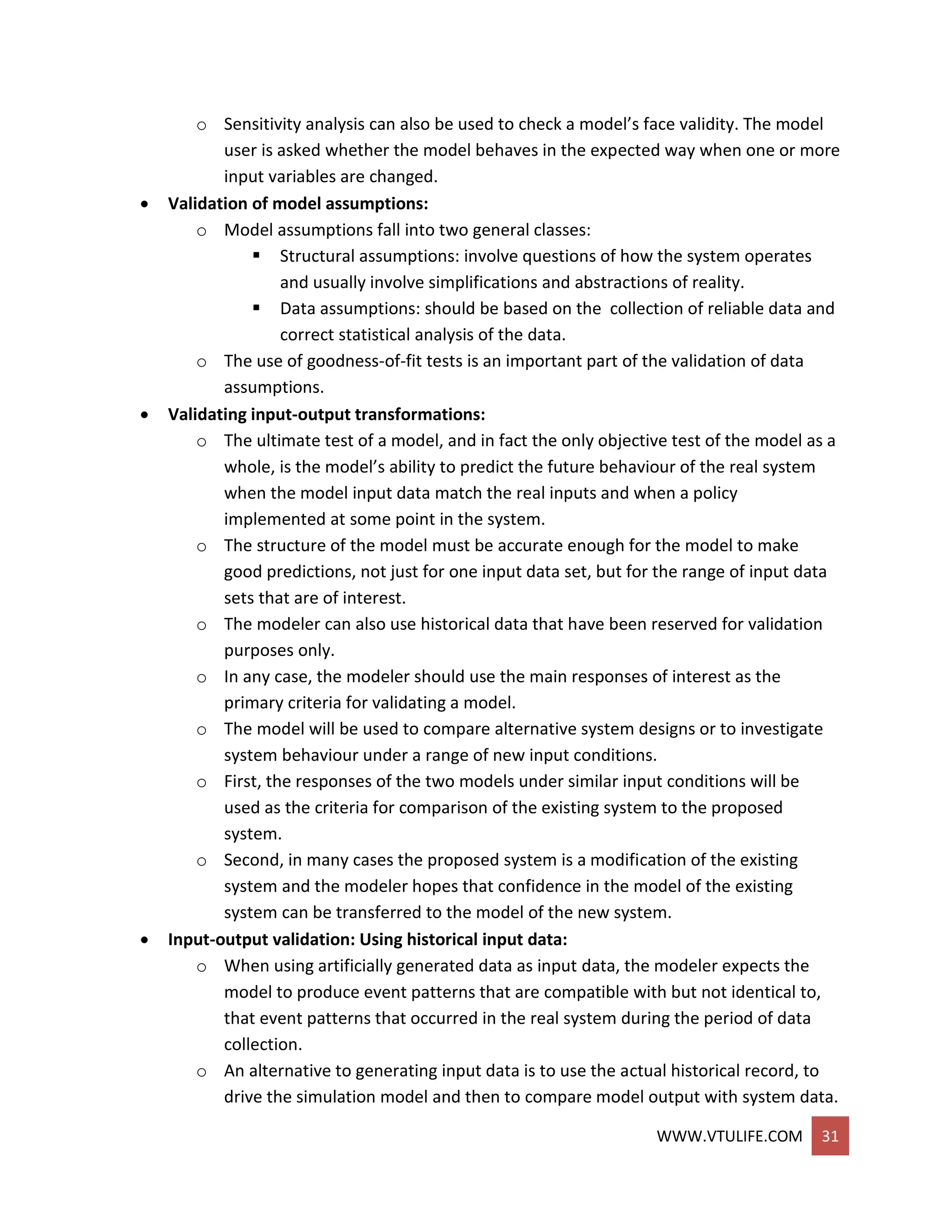
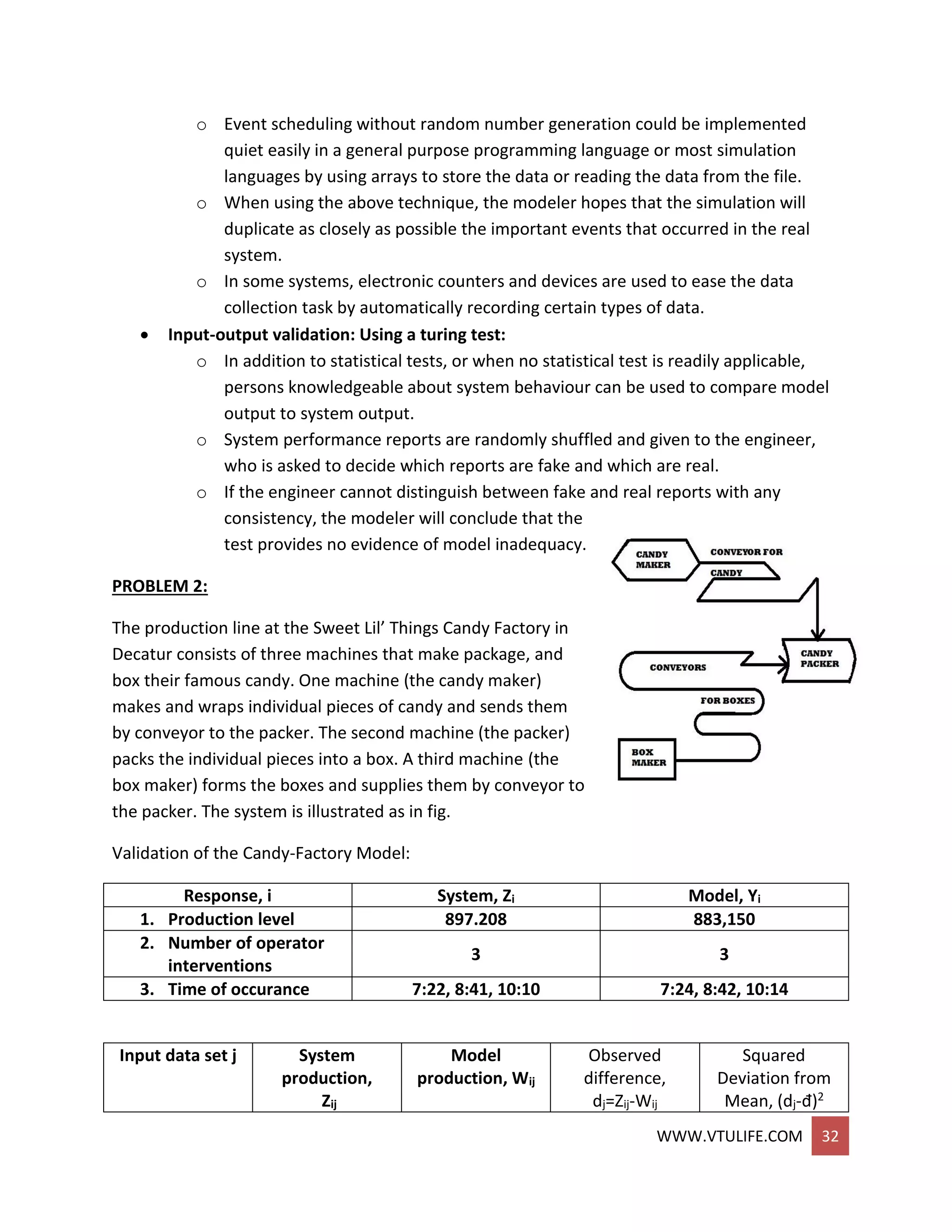
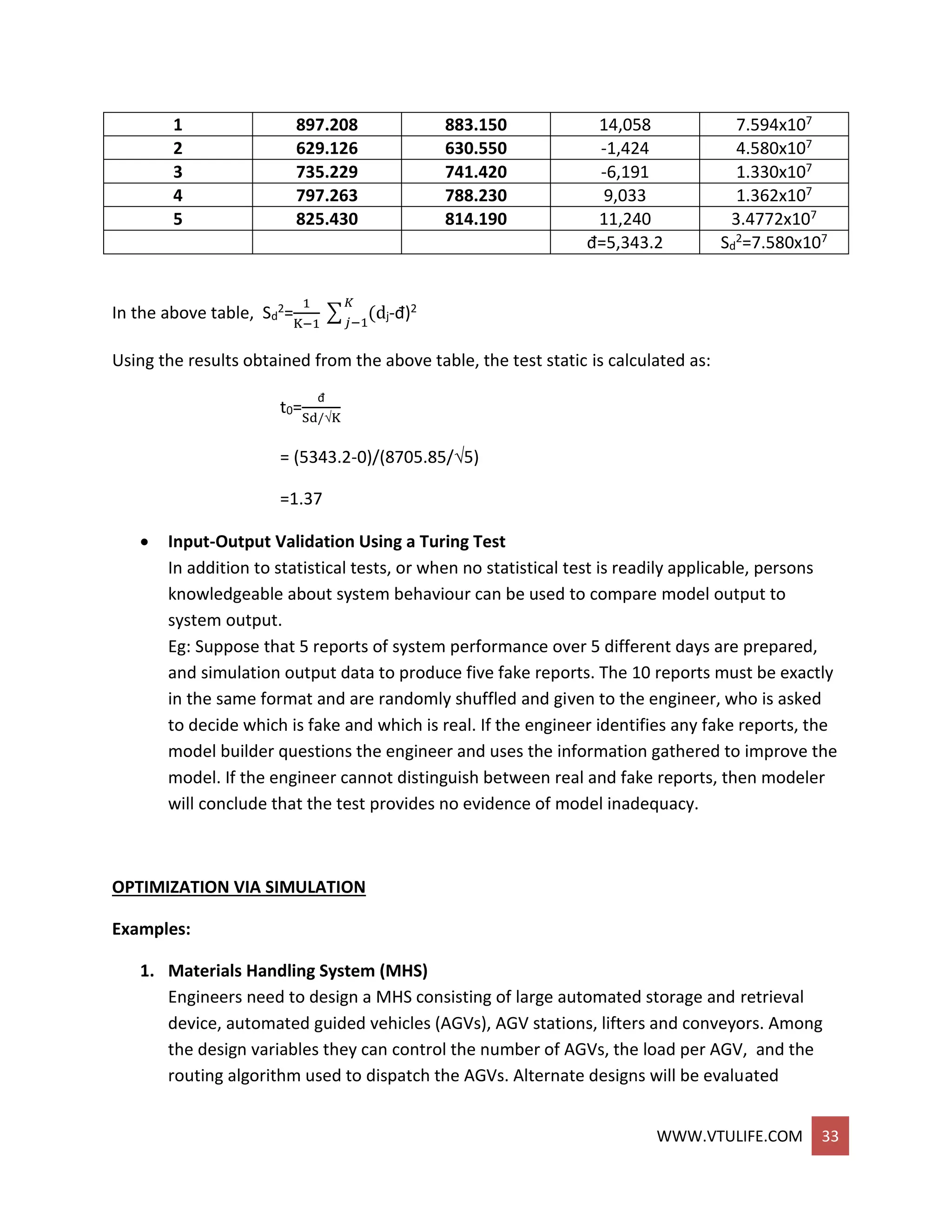

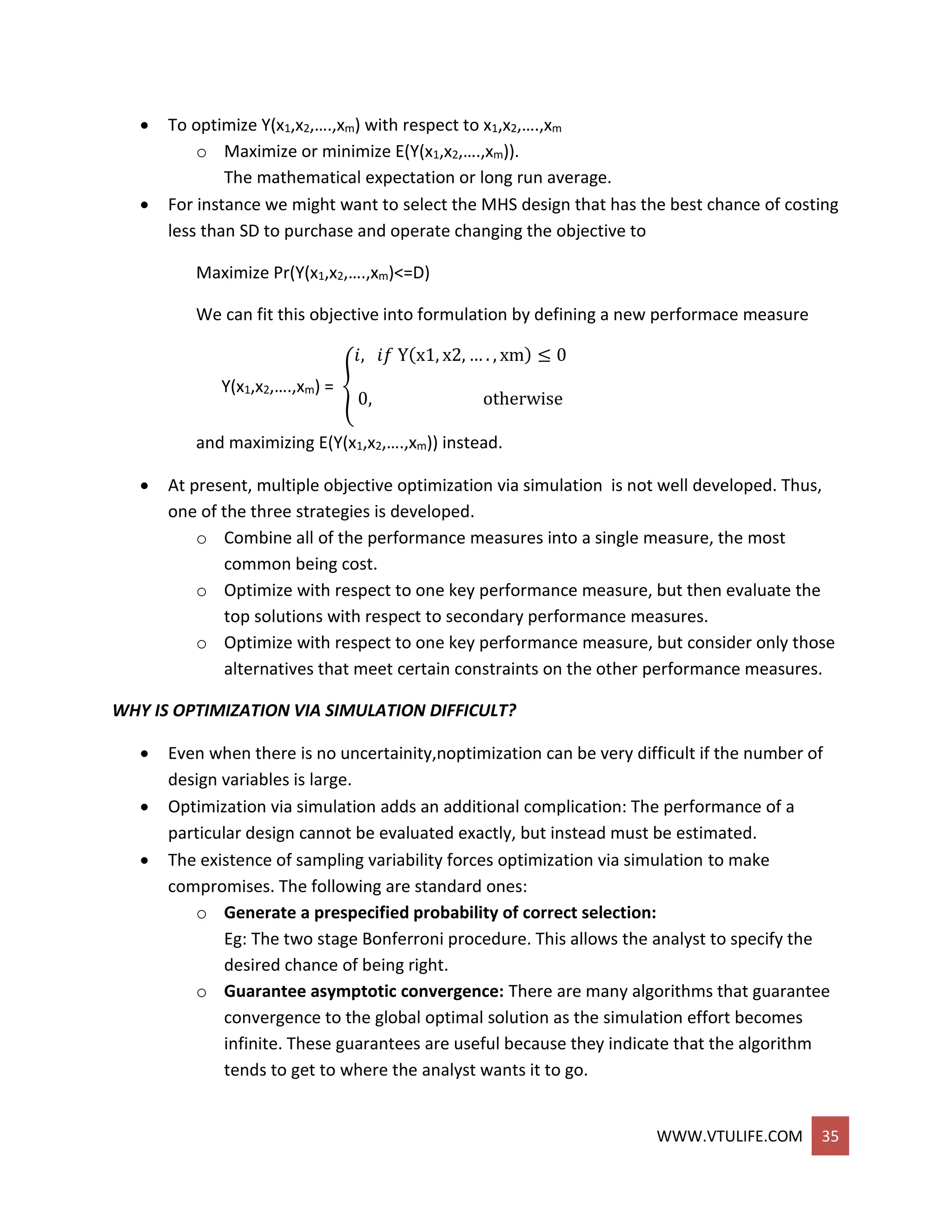
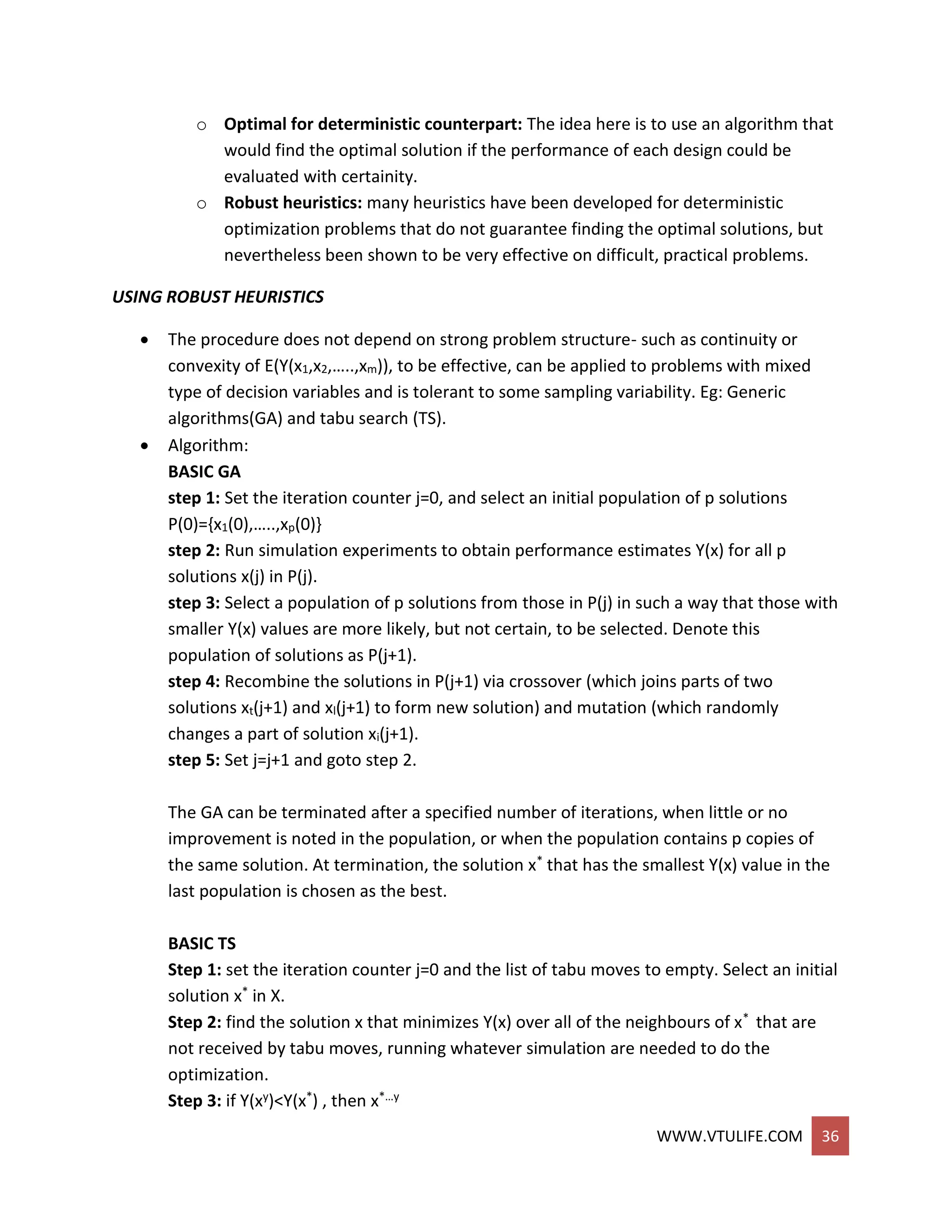
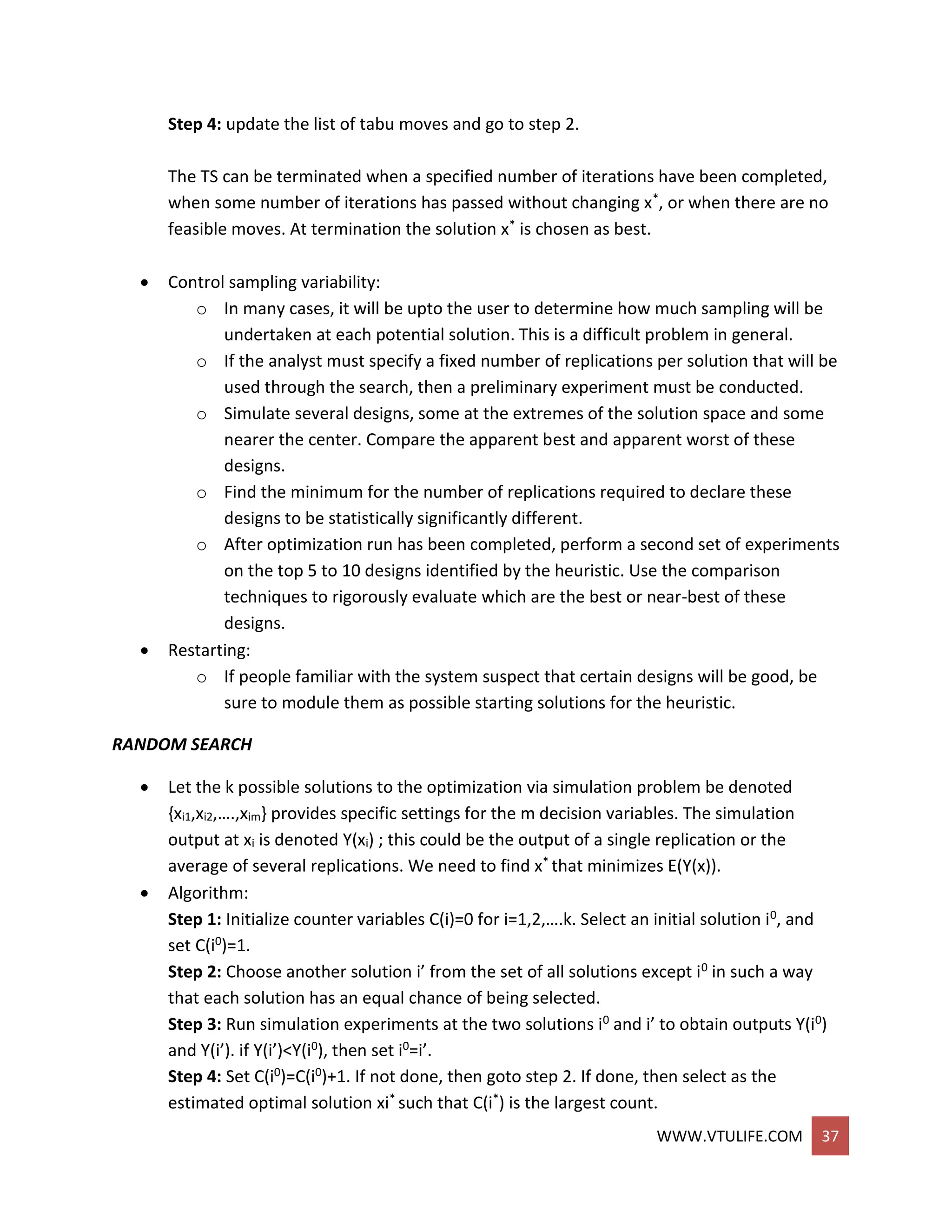
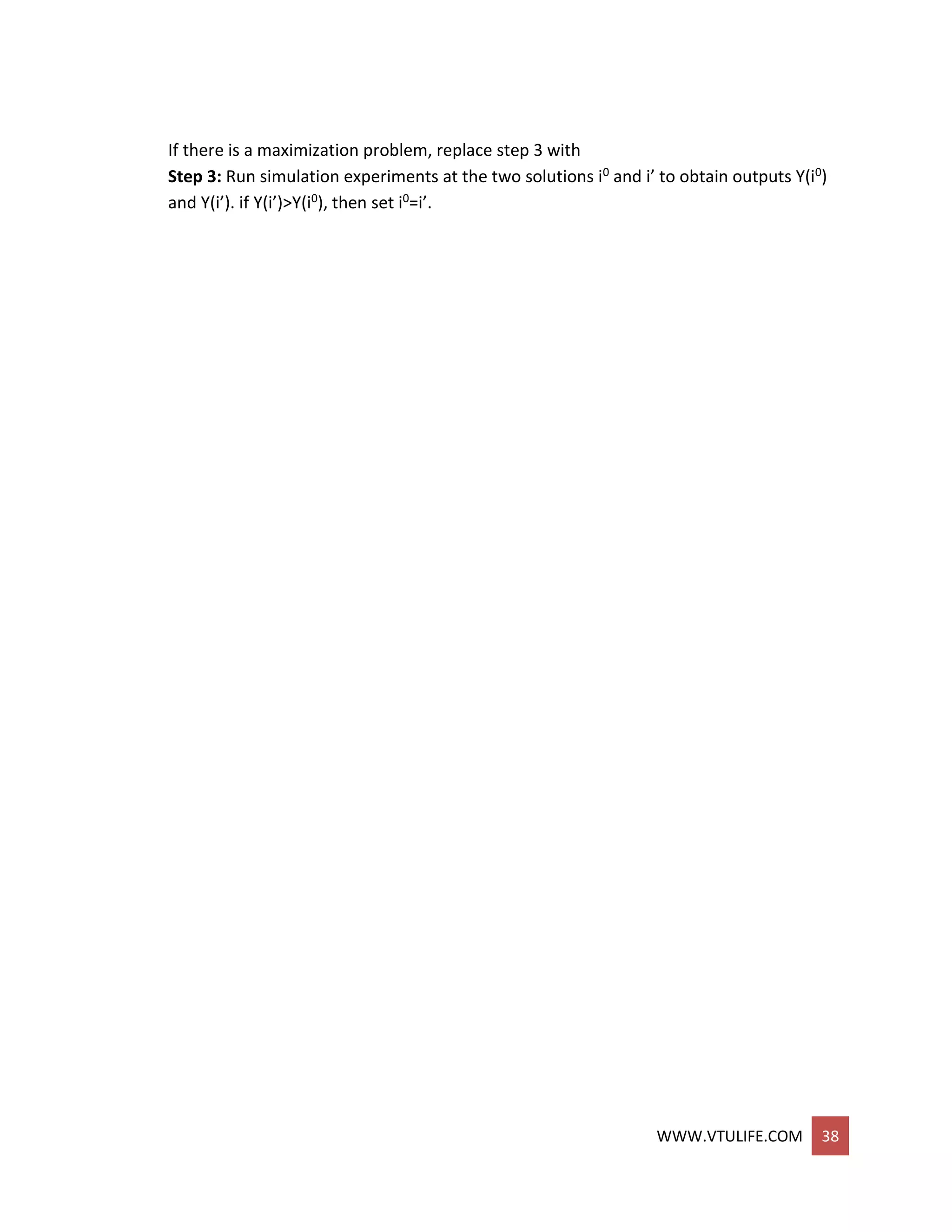
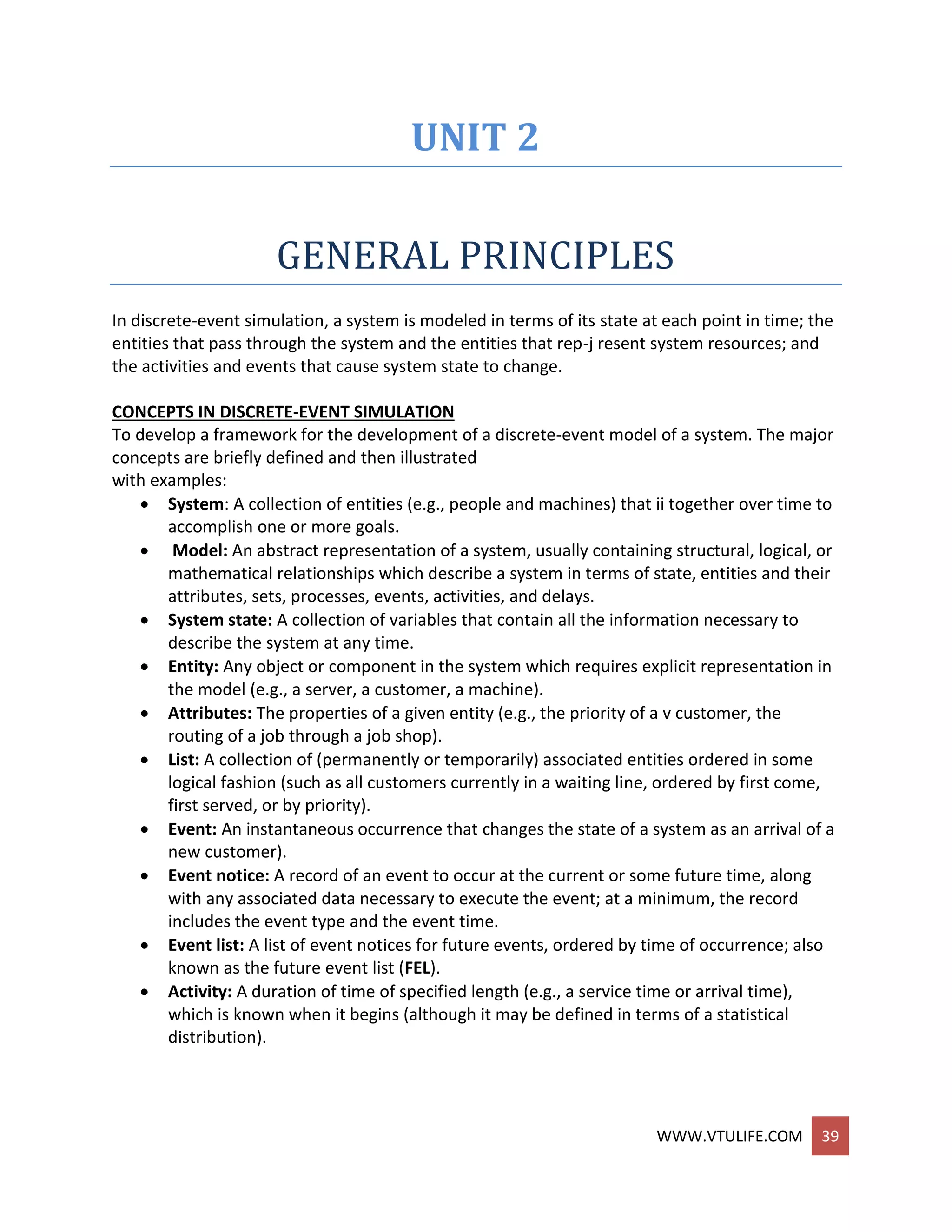
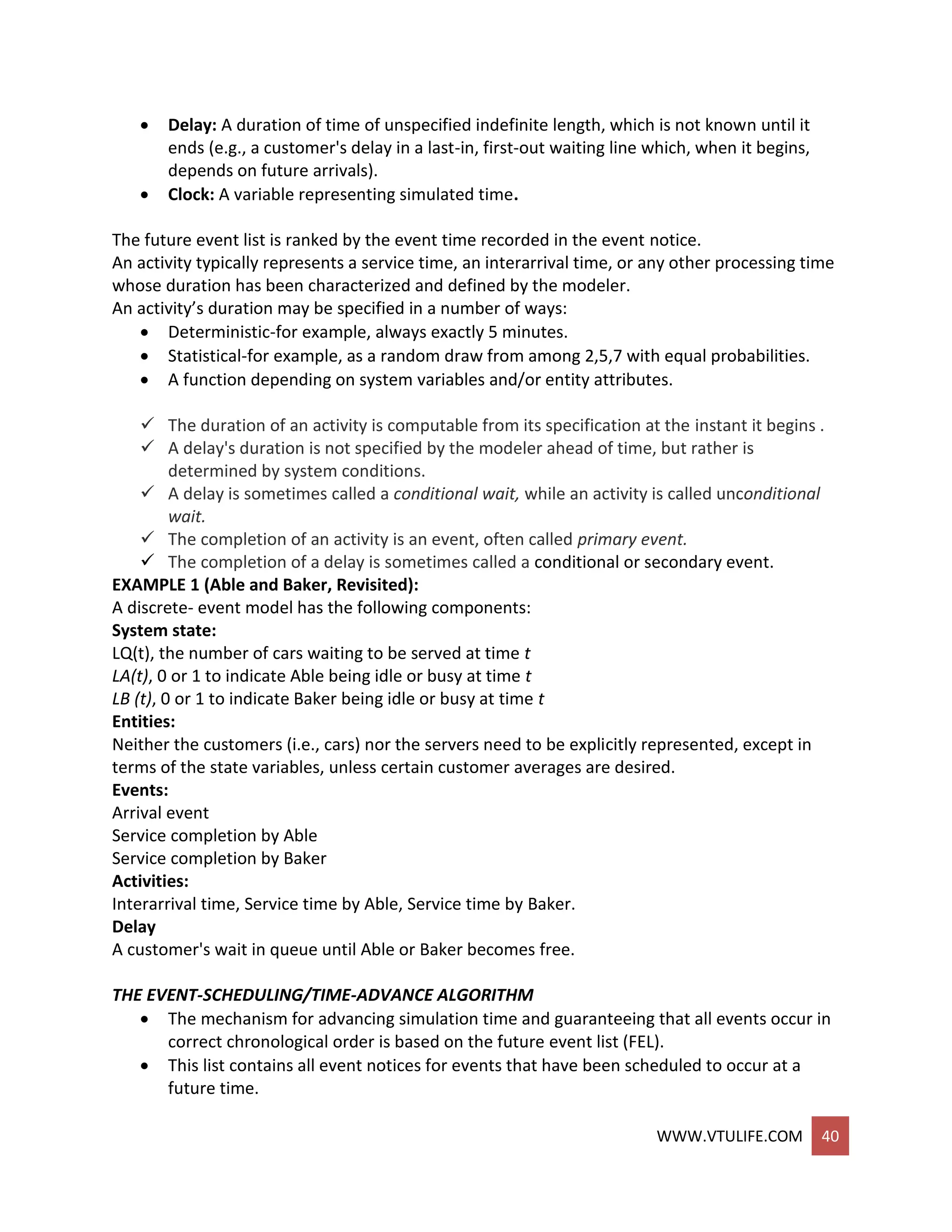
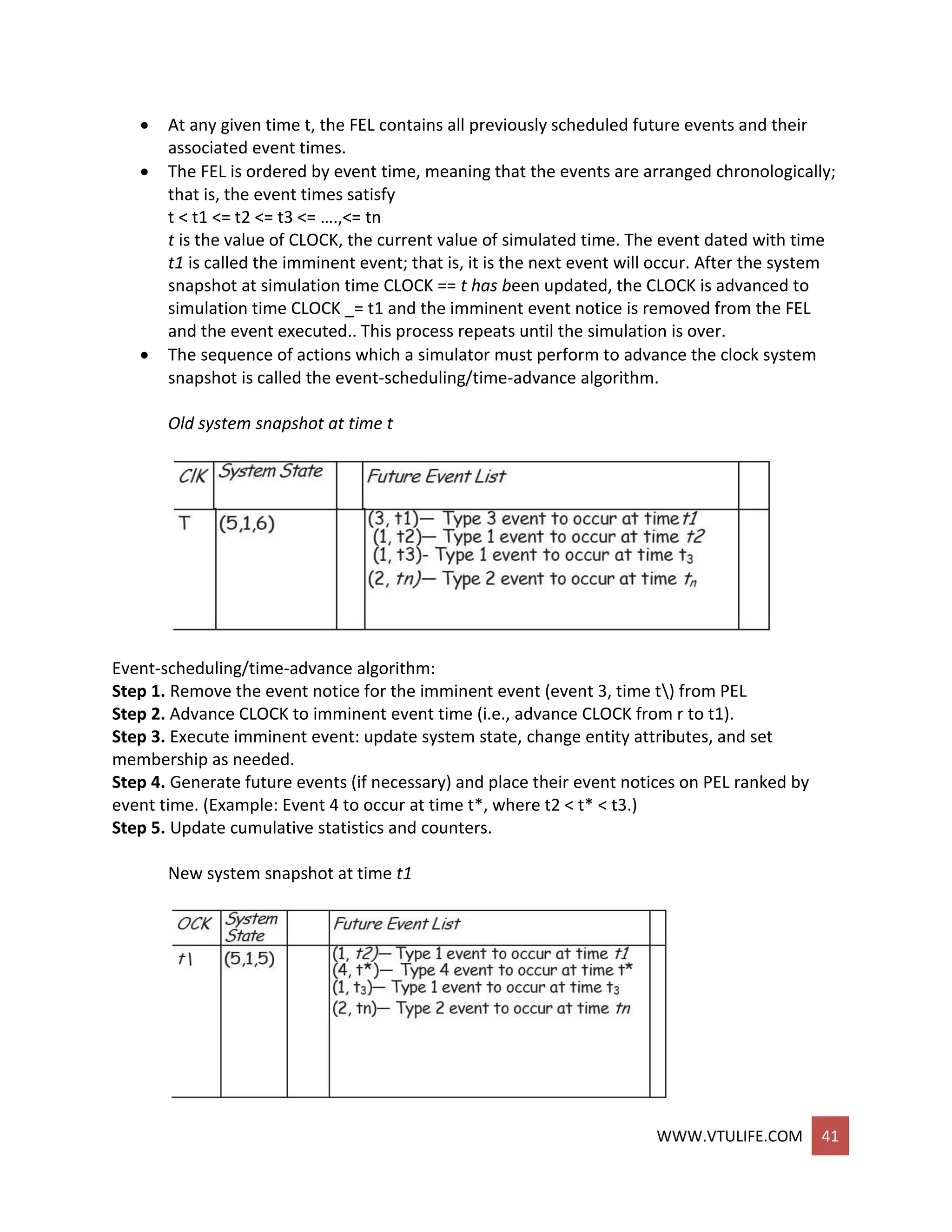
![WWW.VTULIFE.COM 42
Advancing simulation time and updating system image
The management of a list is called list processing.
The major list processing operations performed on a FEL are removal of the imminent
event, addition of a new event to the list, and occasionally removal of some event
(called cancellation of an event).
As the imminent event is usually at the top of the list, its removal is as efficient as
possible. Addition of a new event (and cancellation of an old event) requires a search of
the list.
The removal and addition of events from the PEL is illustrated in figure above.
o When event 4 (say, an arrival event) with event time t* is generated at step 4,
one possible way to determine its correct position on the FEL is to conduct a top-
down search:
If t* < t2, place event 4 at the top of the FEL.
If t2 < t* < t3, place event 4 second on the list.
If t3, < t* < t4, place event 4 third on the list.
If tn < t*, event 4 last on the list.
o Another way is to conduct a bottom-up search.
The system snapshot at time 0 is defined by the initial conditions and the generation of
the so-called exogenous events.
The method of generating an external arrival stream, called bootstrapping.
Every simulation must have a stopping event, here called E, which defines how long the
simulation will run. There are generally two ways to stop a simulation:
o At time 0, schedule a stop simulation event at a specified future time TE. Thus,
before simulating, it is known that the simulation will run over the time interval
[0, TE].
Example: Simulate a job shop for TE = 40 hours.
o Run length TE is determined by the simulation itself. Generally, TE is the time of
occurrence of some specified event E.
Examples: TE is the time of the 100th service completion at a certain service
center. TE is the time of breakdown of a complex system.
WORLD VIEWS
When using a simulation package or even when using a manual simulation, a modeler
adopts a world view or orientation for developing a model.
Those most prevalent are the event scheduling world view, the process-interaction
worldview, and the activity-scanning world view.
When using a package that supports the process-interaction approach, a simulation
analyst thinks in terms of processes .
When using the event-scheduling approach, a simulation analyst concentrates on events
and their effect on system state.](https://image.slidesharecdn.com/systemmodelingandsimulationfullnotesbysushmashettywww-190706073931/75/System-modeling-and-simulation-full-notes-by-sushma-shetty-www-vtulife-com-42-2048.jpg)
![WWW.VTULIFE.COM 43
The process-interaction approach is popular because of its intuitive appeal, and because
the simulation packages that implement it allow an analyst to describe the process flow
in terms of high-level block or network constructs.
Both the event-scheduling and the process-interaction approaches use a / variable time
advance.
The activity-scanning approach uses a fixed time increment and a rule-based approach
to decide whether any activities can begin at each point in simulated time.
The pure activity scanning approach has been modified by what is called the three-
phase approach.
In the three-phase approach, events are considered to be activity duration-zero time
units. With this definition, activities are divided into two categories called B and C.
o B activities: Activities bound to occur; all primary events and unconditional
activities.
o C activities: Activities or events that are conditional upon certain conditions
being true.
With the. three-phase approach the simulation proceeds with repeated execution of the
three phases until it is completed:
o Phase A: Remove the imminent event from the FEL and advance the clock to its
event time. Remove any other events from the FEL that have the event time.
o Phase B: Execute all B-type events that were removed from the FEL.
o Phase C: Scan the conditions that trigger each C-type activity and activate any
whose conditions are met. Rescan until no additional C-type activities can begin
or events occur.
The three-phase approach improves the execution efficiency of the activity scanning
method.
EXAMPLE: (Able and Baker, Back Again)
Using the three-phase approach, the conditions for beginning each activity in Phase C are:
Activity Condition
Service time by Able: A customer is in queue and Able is idle,
Service time by Baker: A customer is in queue, Baker is idle, and Able is busy.
MANUAL SIMULATION USING EVENT SCHEDULING
In an event-scheduling simulation, a simulation table is used to record the successive system
snapshots as time advances. Lets consider the example of a grocery shop which has only one
checkout counter.
Example: (Single-Channel Queue)
The system consists of those customers in the waiting line plus the one (if any) checking out.
The model has the following components:
System state (LQ(i), Z,S(r)), where LQ((] is the number of customers in the waiting line, and LS(t)
is the number being served (0 or 1) at time t.
Entities The server and customers are not explicitly modeled, except in terms of the
state variables above.](https://image.slidesharecdn.com/systemmodelingandsimulationfullnotesbysushmashettywww-190706073931/75/System-modeling-and-simulation-full-notes-by-sushma-shetty-www-vtulife-com-43-2048.jpg)

![WWW.VTULIFE.COM 45
Two statistics, server utilization and maximum queue length, will be collected.
Server utilization is defined by total server busy time .(B) divided by total time(Te).
Total busy time, B, and maximum queue length MQ, will be accumulated as the
simulation progresses.
As soon as the system snapshot at time CLOCK = 0 is complete, the simulation begins.
At time 0, the imminent event is (D, 4).
The CLOCK is advanced to time 4, and (D, 4) is removed from the FEL.
Since LS(t) = 1 for 0 <= t <= 4 (i.e., the server was busy for 4 minutes), the cumulative
busy time is Increased from B = 0 to B = 4.
By the event logic in Figure 1(B), set LS (4) = 0 (the server becomes idle).
The FEL is left with only two future events, (A, 8) and (E, 0).
The simulation CLOCK is next advanced to time 8 and an arrival event is executed.
The simulation table covers interval [0,9].
Simulation table for checkout counter:
Example: (The Checkout-Counter Simulation,
Continued)
Suppose the system analyst desires to estimate the mean response time and mean proportion
of customers who spend 4 or more minutes in the system the above mentioned model has to
be modified.
Entities (Ci, t), representing customer Ci who arrived at time t.
Event notices (A, t, Ci ), the arrival of customer Ci at future time t (D, f, Cj), the
departure of customer Cj at future time t.](https://image.slidesharecdn.com/systemmodelingandsimulationfullnotesbysushmashettywww-190706073931/75/System-modeling-and-simulation-full-notes-by-sushma-shetty-www-vtulife-com-45-2048.jpg)
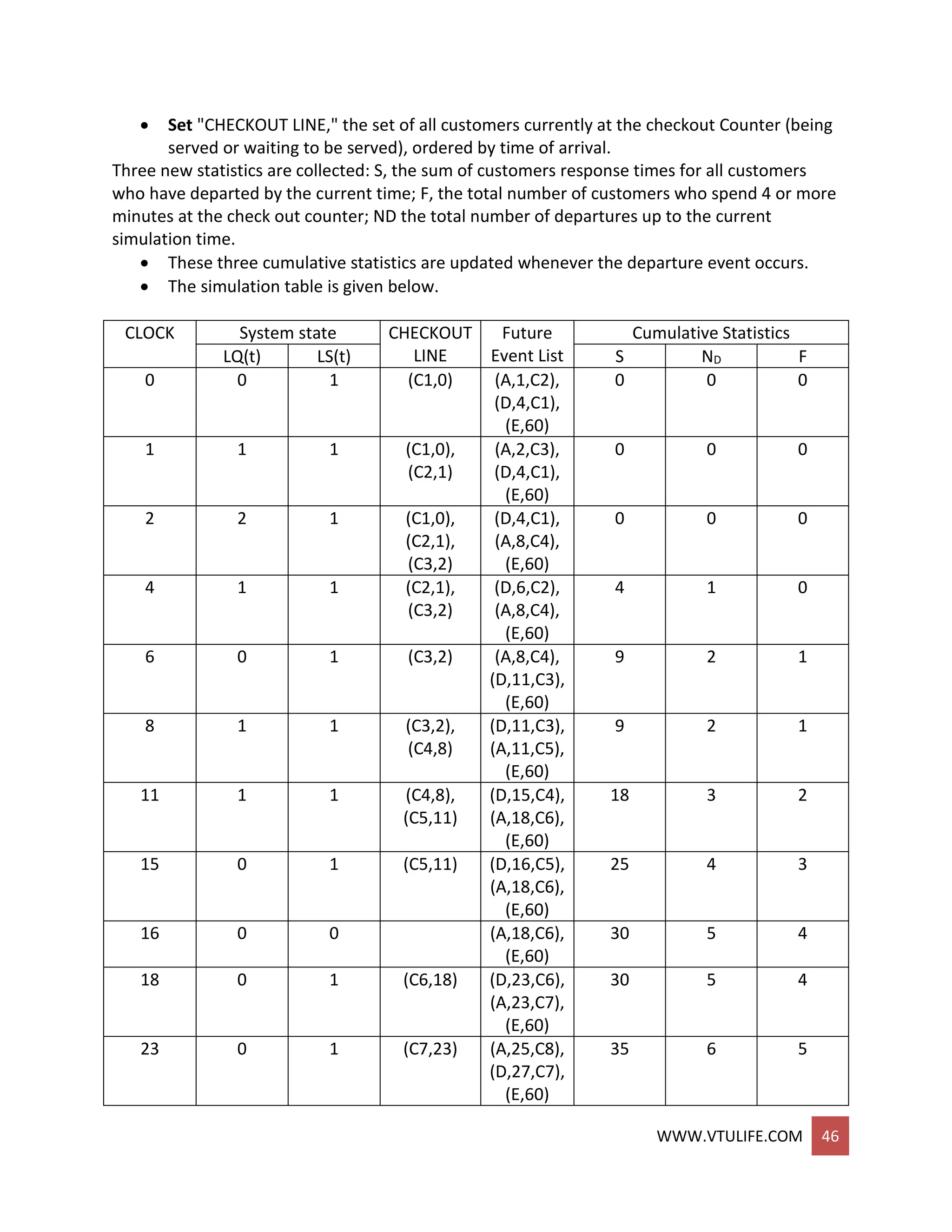
![WWW.VTULIFE.COM 47
EXAMPLE: (THE DUMP TRUCK PROBLEM)
Six dump truck are used to haul coal from the entrance of a small mine to the railroad.
Each truck is loaded by one of two loaders.
After loading, a truck immediately moves to scale, to be weighted as soon as possible.
Both the loaders and the scale have a first come, first serve waiting line(or queue) for
trucks.
The time taken to travel from loader to scale is considered negligible.
After being weighted, a truck begins a travel time and then afterward returns to the
loader queue.
The model has the following components:
o System state
[LQ(0, L(f), WQ(r), W(r)], where
LQ(f) = number of trucks in loader queue.
L(t) = number of trucks (0,1, or 2)being loaded.
WQ(t)= number of trucks in weigh queue.
W(t) = number of trucks (0 or 1) being weighed, all at simulation time t.
o Event notices
(ALQ,, t, DTi), dump truck arrives at loader queue
(ALQ) at time t
(EL, t, DTi), dump truck i ends loading (EL) at time t
(EW, t, DTi), dump truck i ends weighing (EW) at time t
o Entities The six dump trucks (DTI,..., DT6)
o Lists
Loader queue, all trucks waiting to begin loading, ordered on a first-
come, first-served basis Weigh queue, all trucks waiting to be weighed,
ordered on a first-come, first-serve basis.
o Activities Loading time, weighing time, and travel time.
o Delays Delay at loader queue, and delay at scale. Distribution of Loading for the
Dump Truck.
Distribution of loading time for the dump trucks:
Loading time probability Cumulative Random digit](https://image.slidesharecdn.com/systemmodelingandsimulationfullnotesbysushmashettywww-190706073931/75/System-modeling-and-simulation-full-notes-by-sushma-shetty-www-vtulife-com-47-2048.jpg)


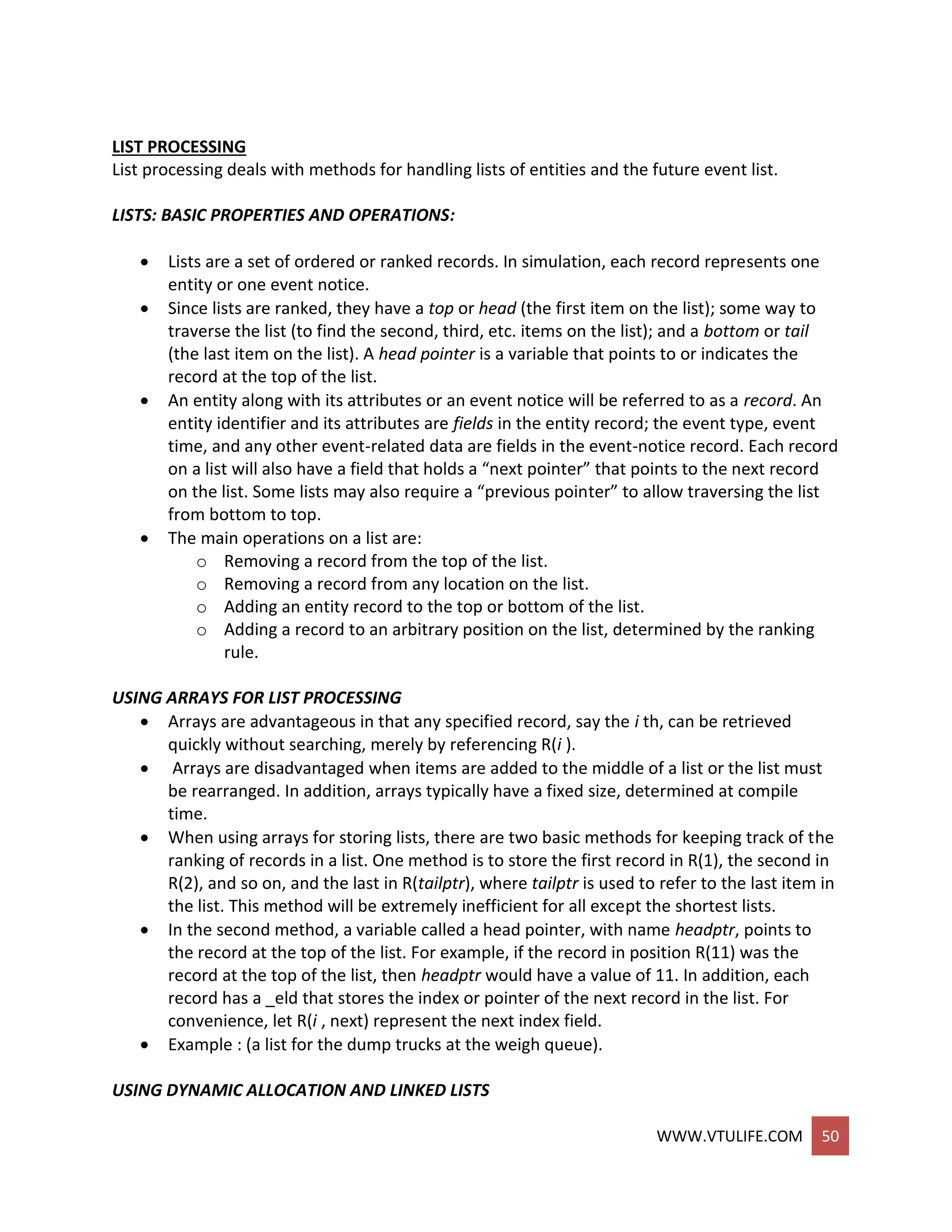

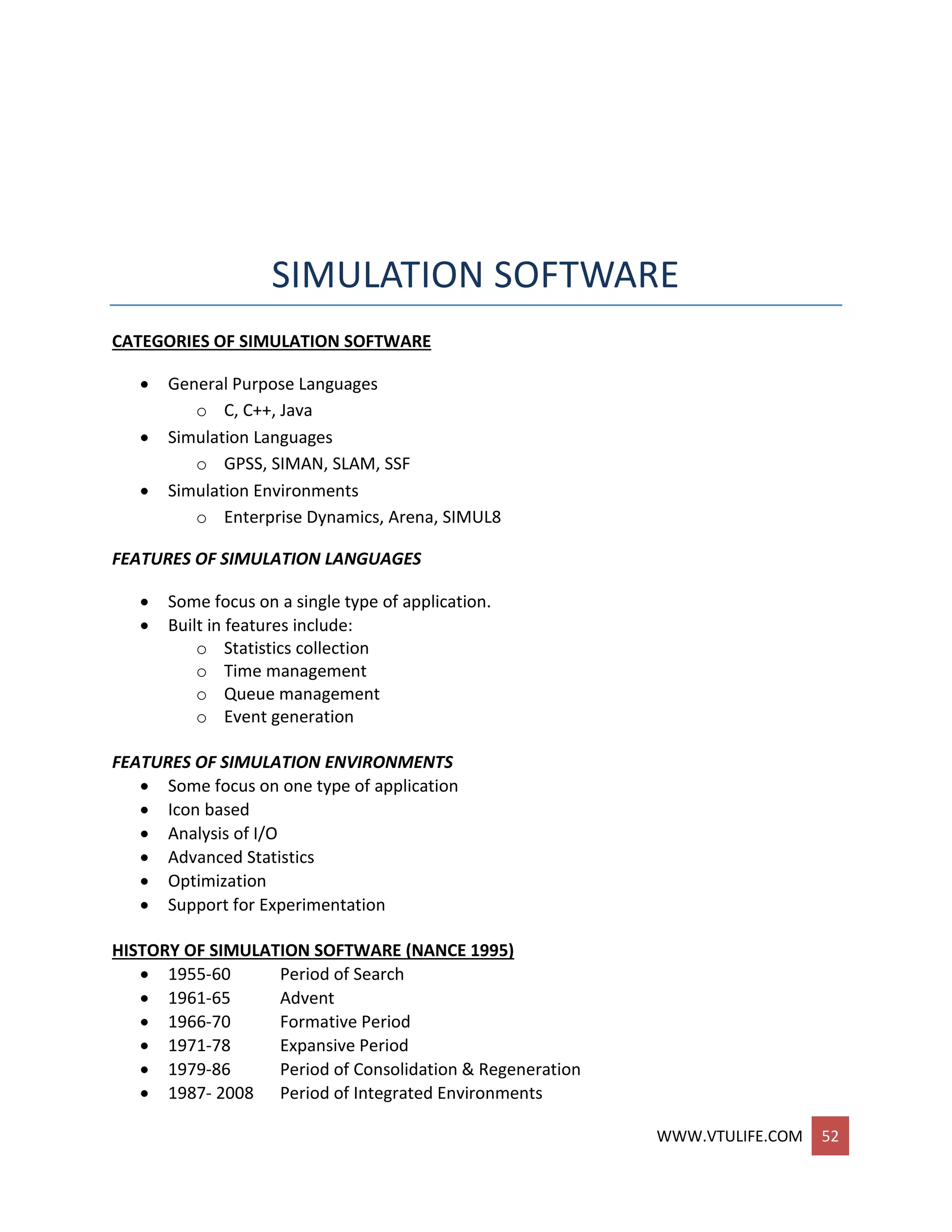
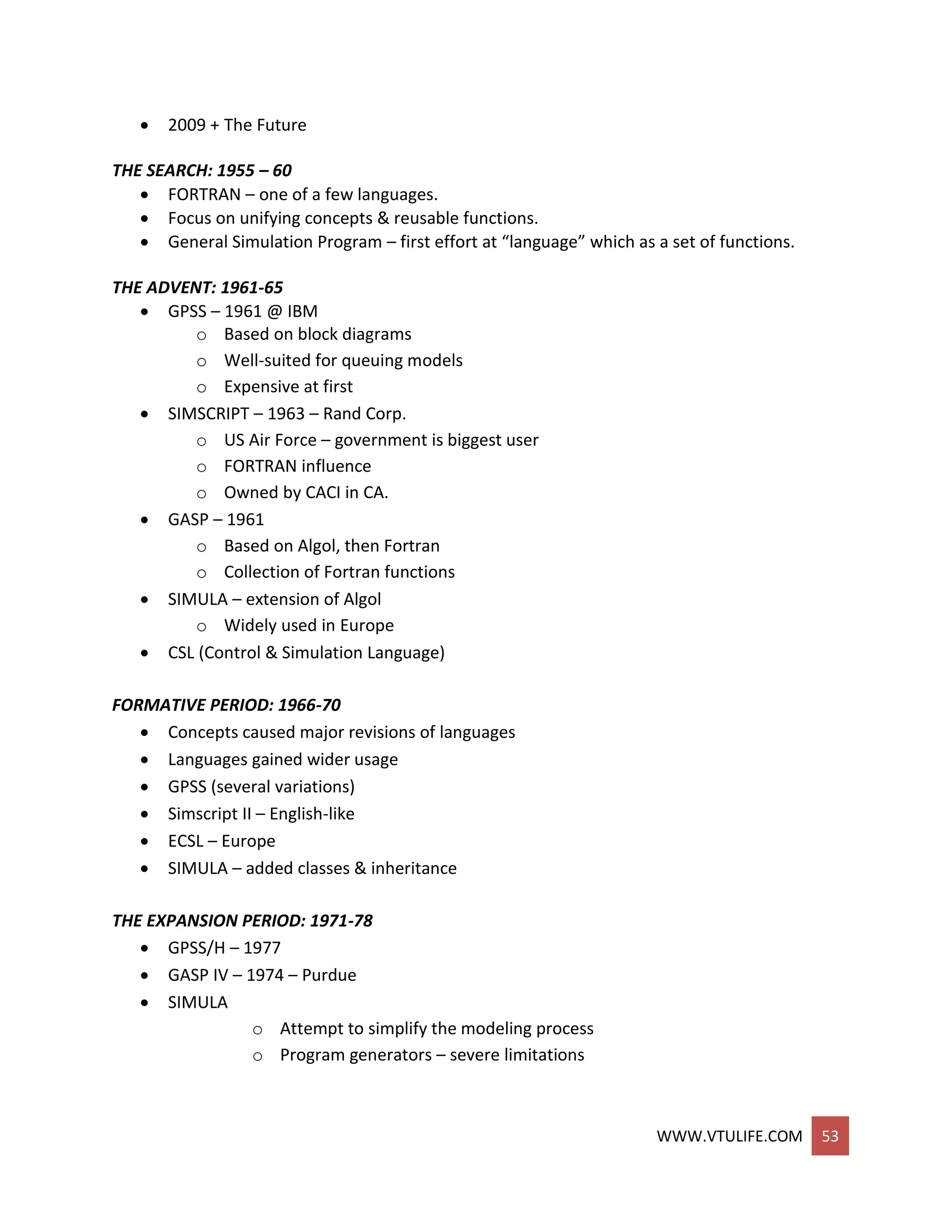
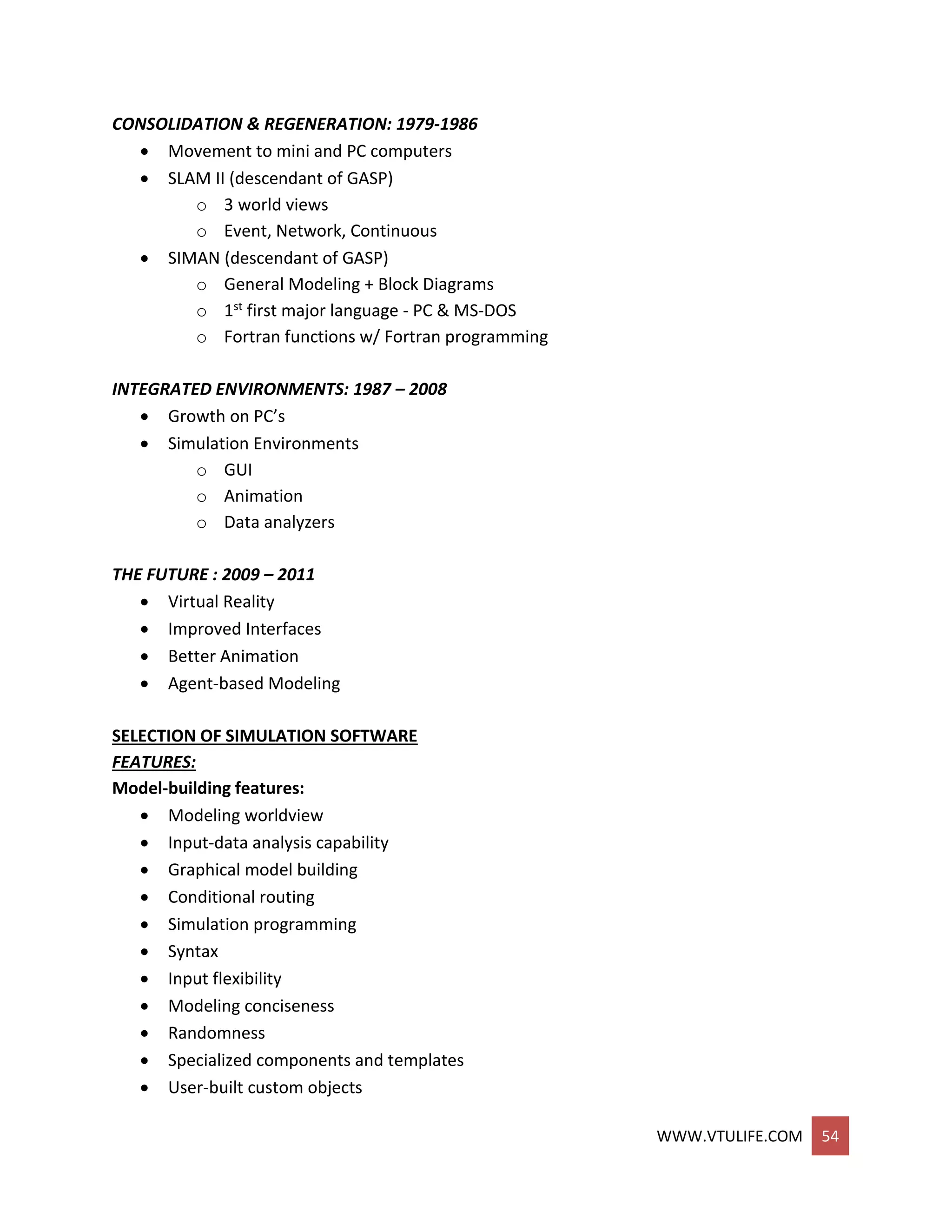

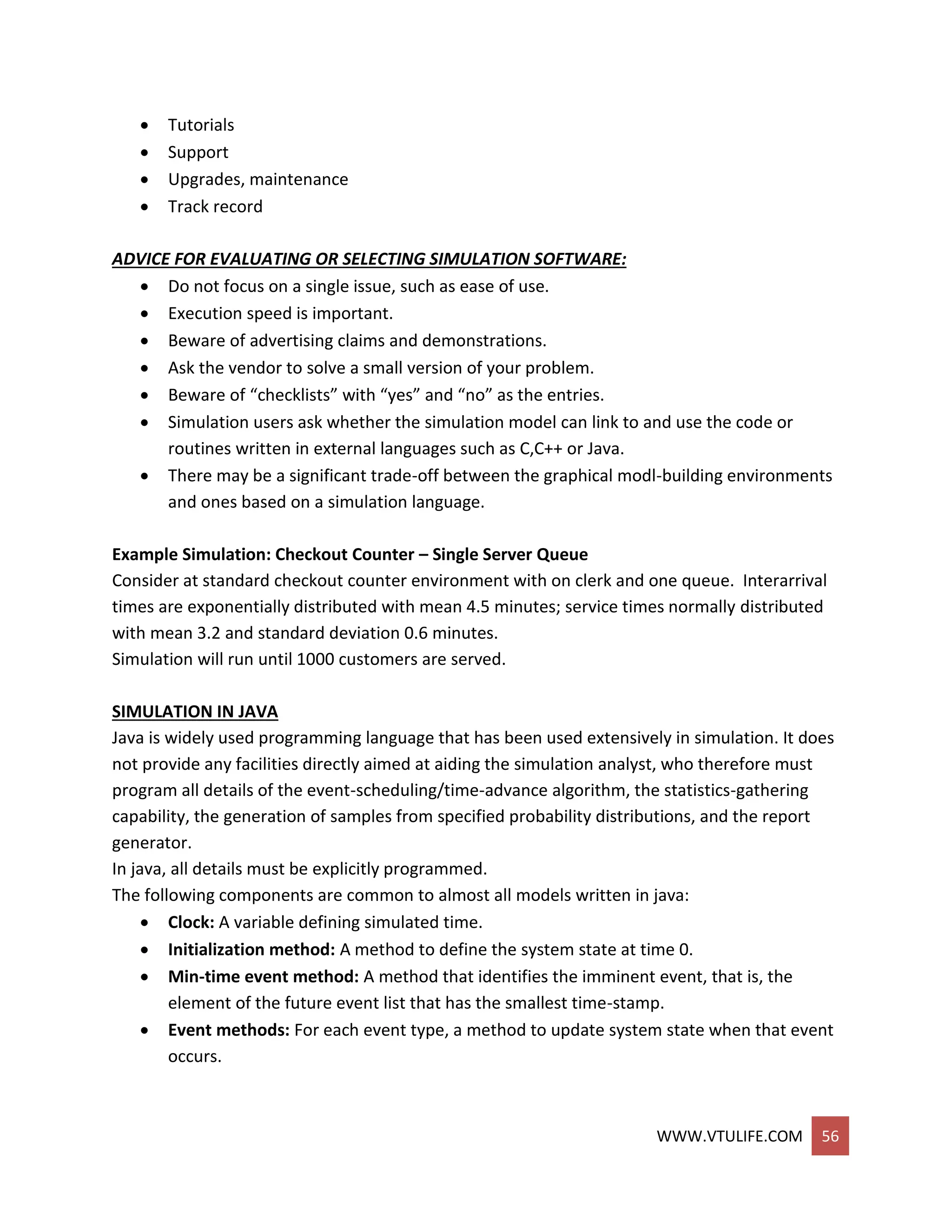
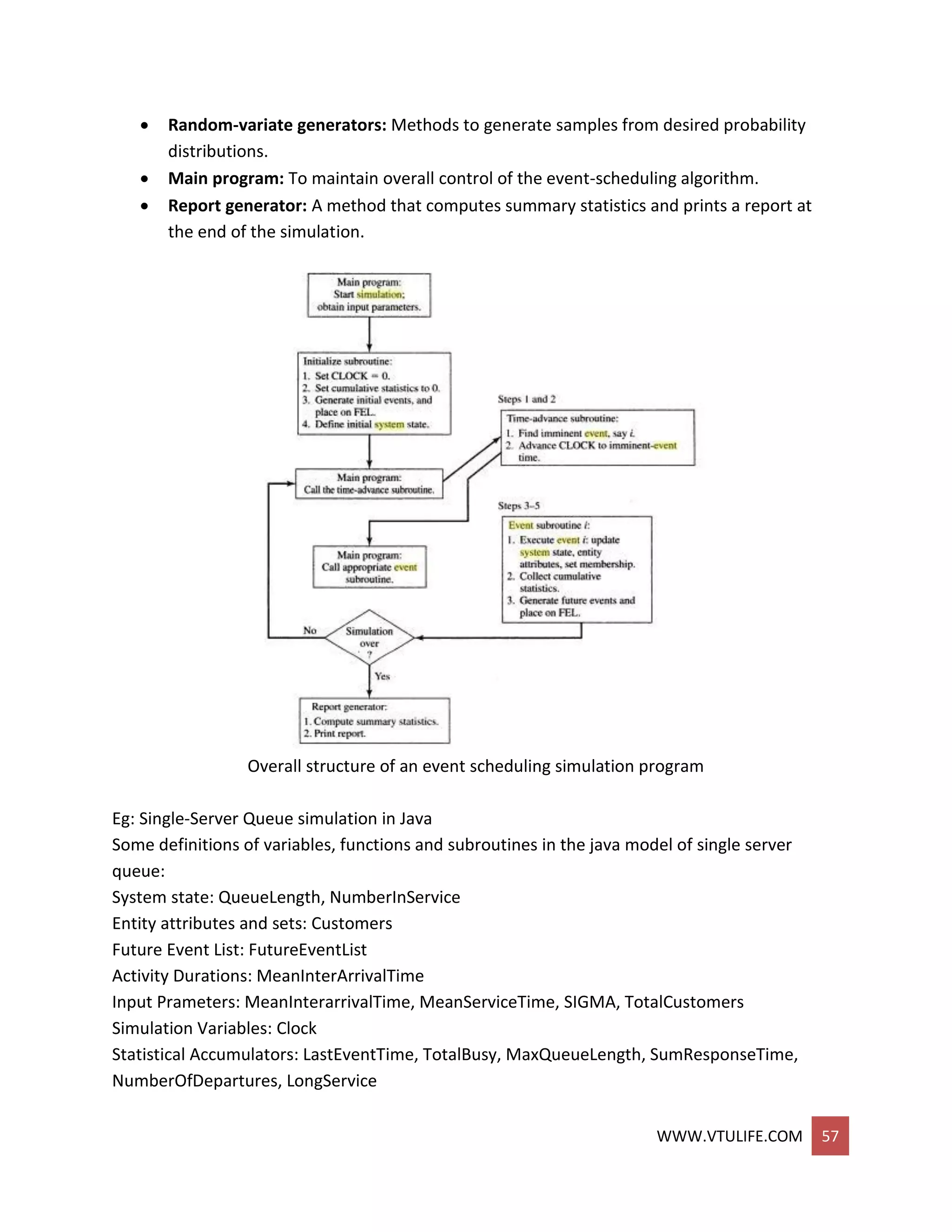
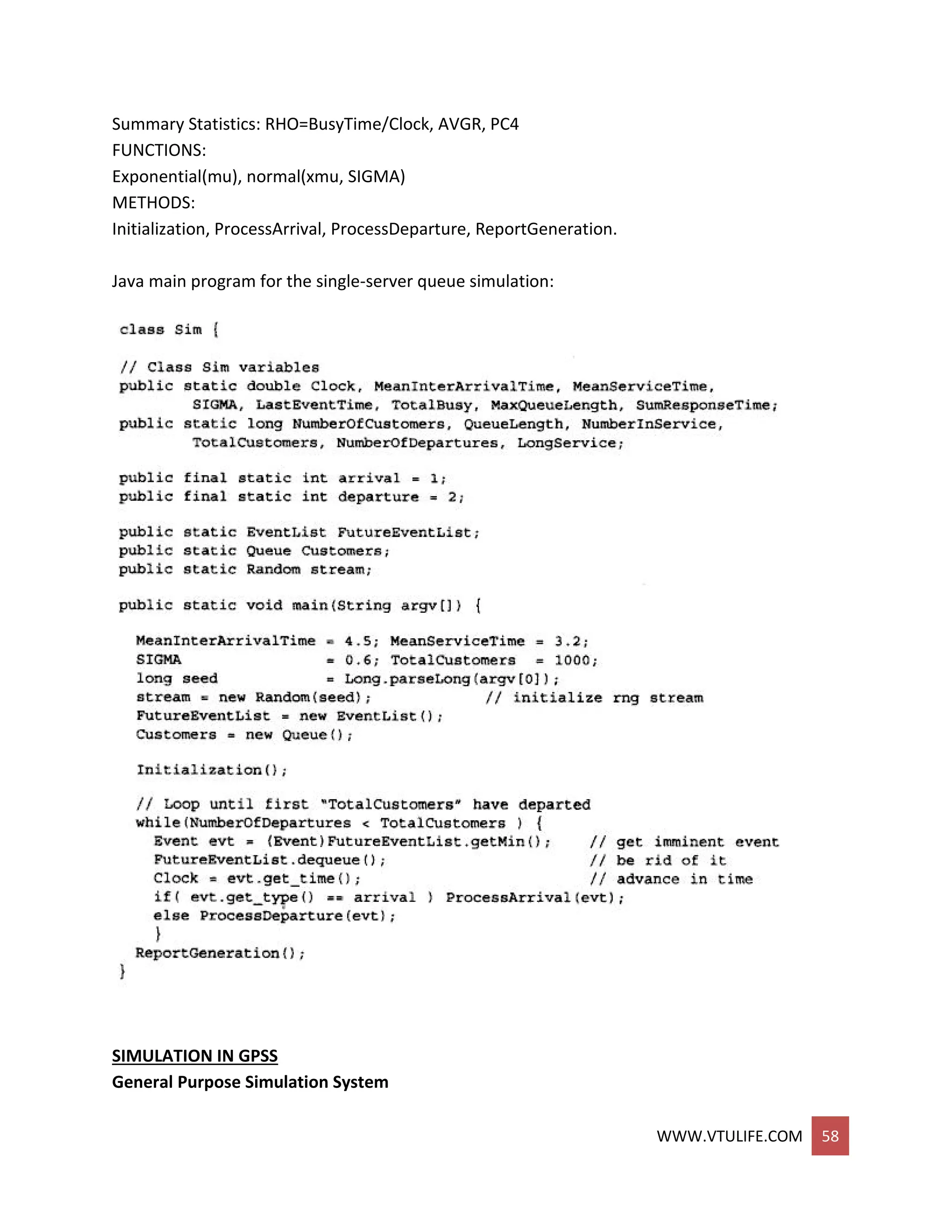
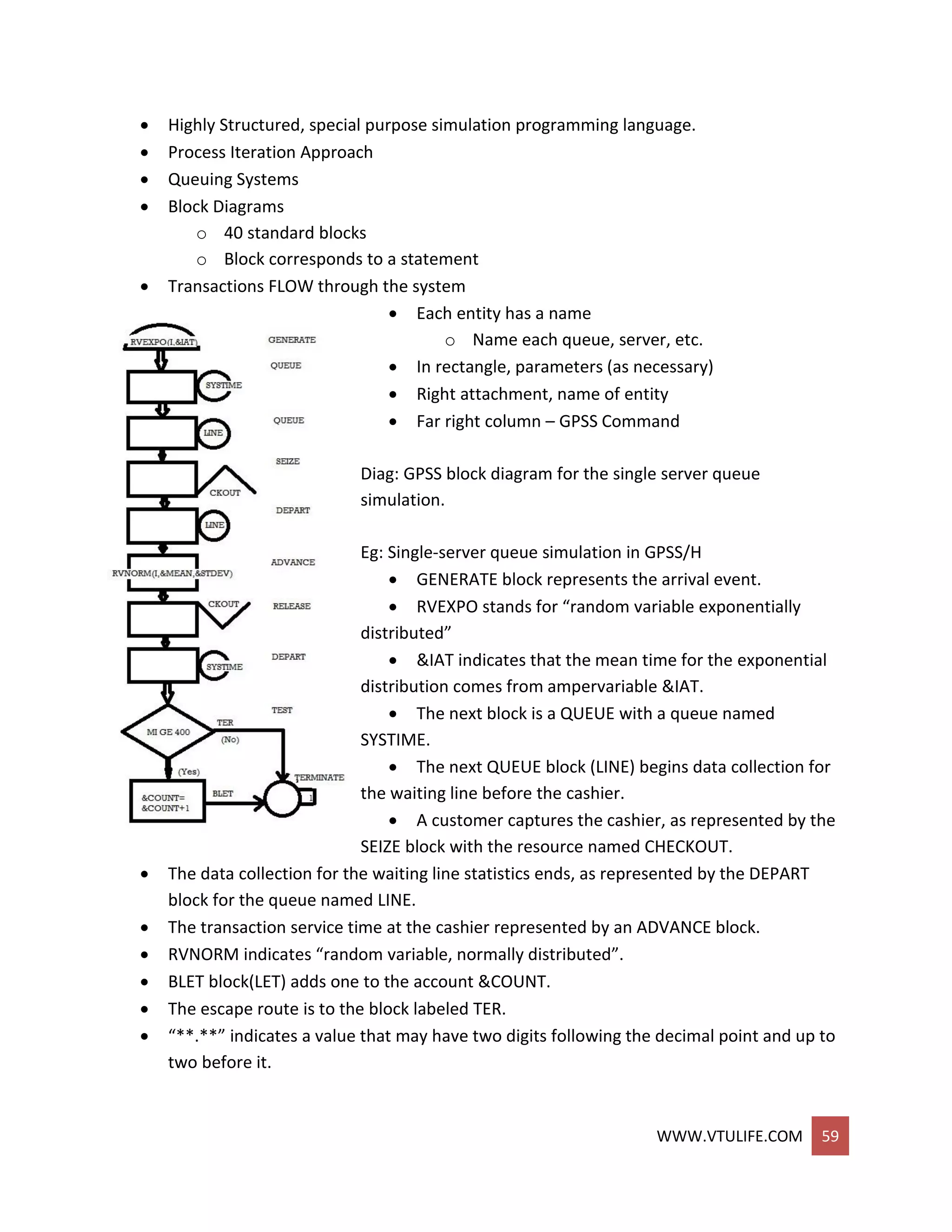
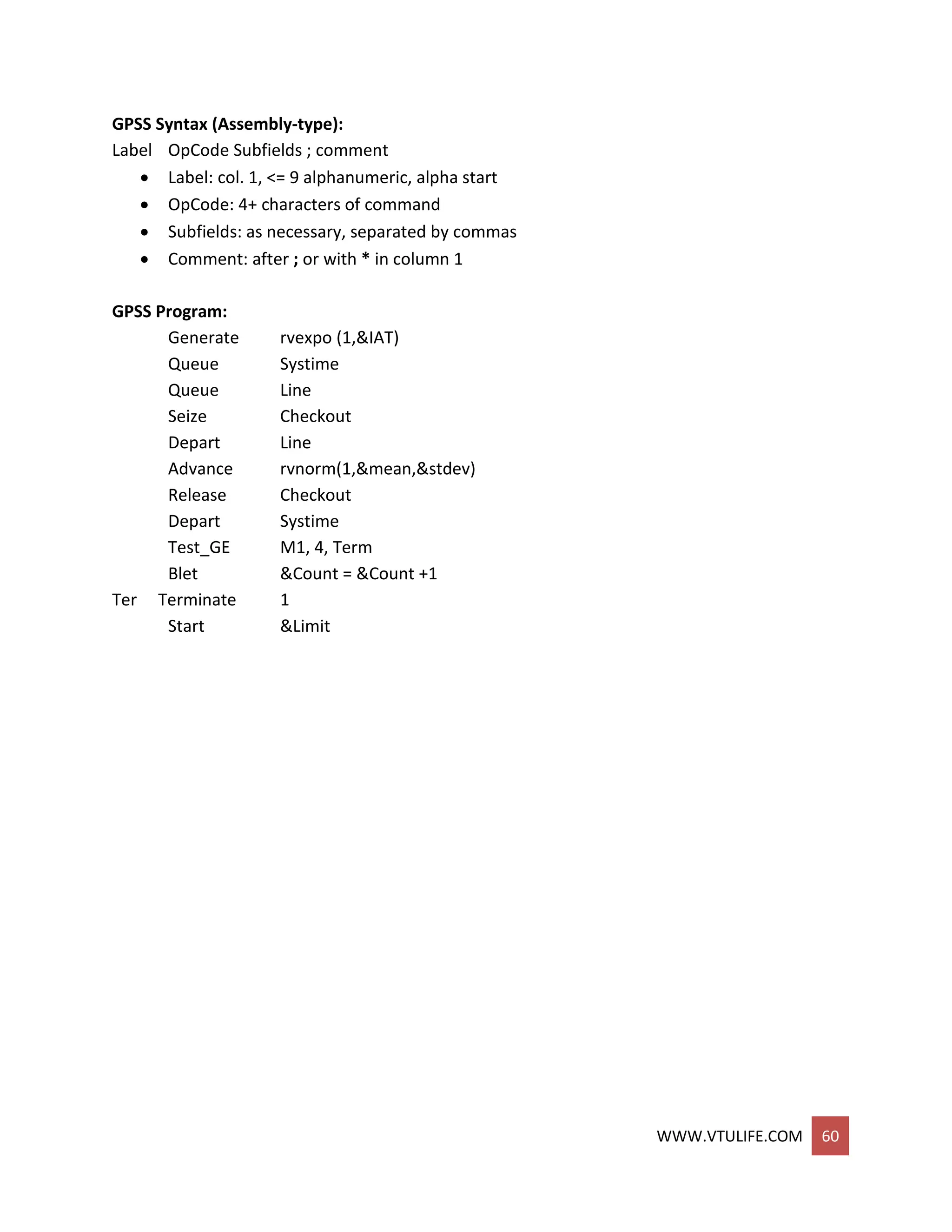
![WWW.VTULIFE.COM 61
UNIT 3
STATISTICAL MODELS IN SIMULATION
The world the model-builder sees is probabilistic rather than deterministic.
Some statistical model might well describe the variations. The world the model-builder
sees is probabilistic rather than deterministic.
Some statistical model might well describe the variations.
An appropriate model can be developed by sampling the phenomenon of interest:
Select a known distribution through educated guesses
Make estimate of the parameter(s)
Test for goodness of fit
REVIEW OF TERMINOLOGY AND CONCEPTS
DISCRETE RANDOM VARIABLES:
X is a discrete random variable if the number of possible values of X is finite, or countably
infinite.
Example: Consider jobs arriving at a job shop.
Let X be the number of jobs arriving each week at a job shop.
Rx = possible values of X (range space of X) = {0,1,2,…}
p(xi) = probability the random variable is xi = P(X = xi)
p(xi), i = 1,2, … must satisfy:
The collection of pairs [xi, p(xi)], i = 1,2,…, is called the probability distribution of X, and p(xi) is
called the probability mass function (pmf) of X.
CONTINUOUS RANDOM VARIABLES:
X is a continuous random variable if its range space Rx is an interval or a collection of intervals.](https://image.slidesharecdn.com/systemmodelingandsimulationfullnotesbysushmashettywww-190706073931/75/System-modeling-and-simulation-full-notes-by-sushma-shetty-www-vtulife-com-61-2048.jpg)
![WWW.VTULIFE.COM 62
The probability that X lies in the interval [a,b] is given by:
f(x), denoted as the pdf of X, satisfies:
Properties:
Example: Life of an inspection device is given by X, a continuous random variable with
pdf:
X has an exponential distribution with mean 2 years
Probability that the device’s life is between 2 and 3 years is:
CUMULATIVE DISTRIBUTION FUNCTION:
Cumulative Distribution Function (cdf) is denoted by F(x), where F(x)= P(X <= x)](https://image.slidesharecdn.com/systemmodelingandsimulationfullnotesbysushmashettywww-190706073931/75/System-modeling-and-simulation-full-notes-by-sushma-shetty-www-vtulife-com-62-2048.jpg)
![WWW.VTULIFE.COM 63
Properties
o All probability question about X can be answered in terms of the cdf,
Eg:
Example: An inspection device has cdf:
The probability that the device lasts for less than 2 years:
The probability that it lasts between 2 and 3 years:
EXPECTATION:
The expected value of X is denoted by E(X). The mean, m, or the 1st moment of X
A measure of the central tendency
The variance of X is denoted by V(X) or var(X) or σ2
The variance of X is denoted by V(X) or var(X) or σ2
Definition: V(X) = E[(X – E[X]2]
Also, V(X) = E(X2) – [E(x)]2
A measure of the spread or variation of the possible values of X around the mean
The standard deviation of X is denoted by σ
Definition: square root of V(X)
Expressed in the same units as the mean
Example: The mean of life of the previous inspection device is:
To compute variance of X, we first compute E(X2):
Hence, the variance and standard deviation of the device’s life are:
USEFUL STATISTICAL MODELS](https://image.slidesharecdn.com/systemmodelingandsimulationfullnotesbysushmashettywww-190706073931/75/System-modeling-and-simulation-full-notes-by-sushma-shetty-www-vtulife-com-63-2048.jpg)
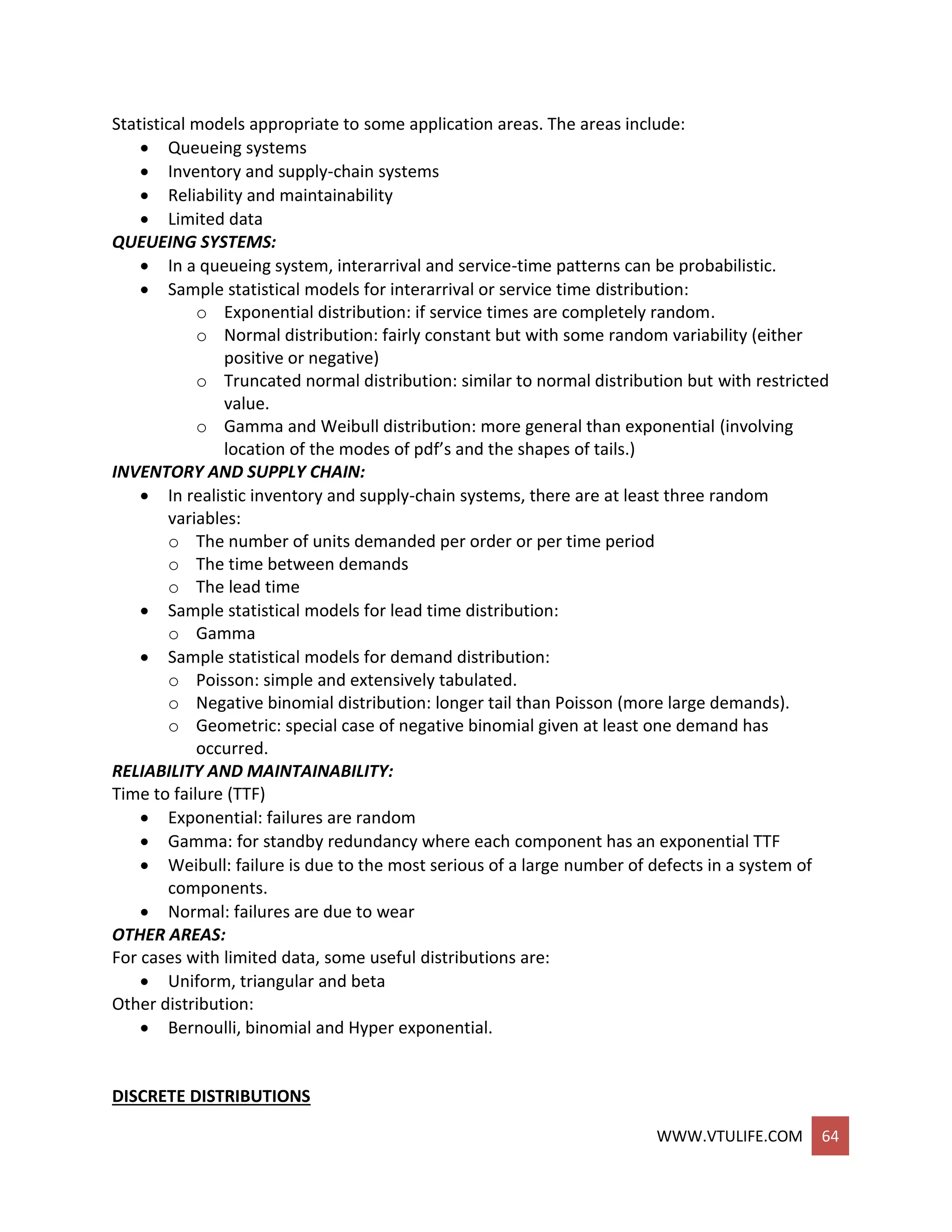
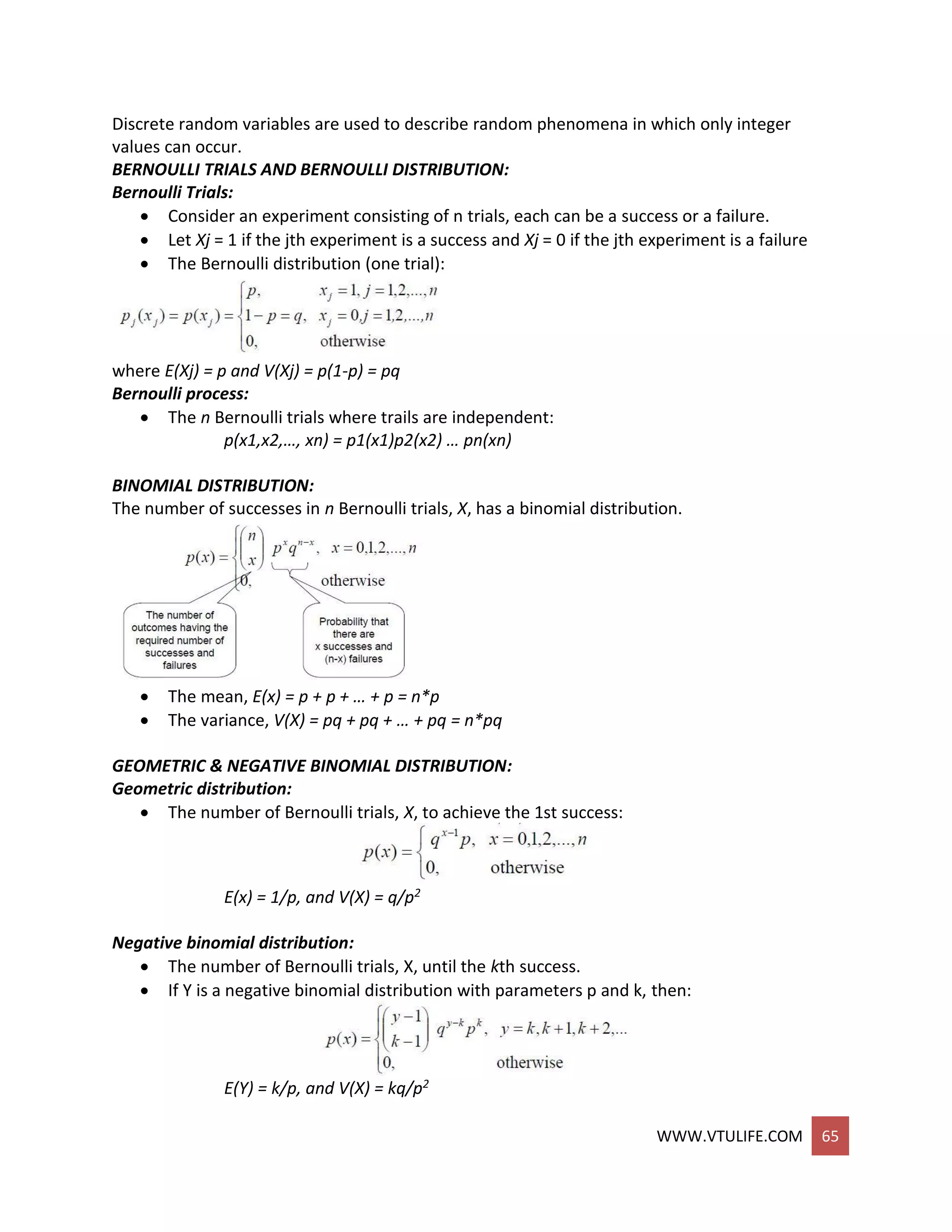
![WWW.VTULIFE.COM 66
POISSON DISTRIBUTION:
Poisson distribution describes many random processes quite well and is mathematically quite
simple where α > 0, pdf and cdf are:
E(X) = α = V(X)
Example: A computer repair person is “beeped” each time there is a call for service. The
number of beeps per hour ~ Poisson(α = 2 per hour).
The probability of three beeps in the next hour:
p(3) = e-2 23 /3! = 0.18
also, p(3) = F(3) – F(2) = 0.857-0.677=0.18
The probability of two or more beeps in a 1-hour period:
p(2 or more) = 1 – p(0) – p(1)
= 1 – F(1)
= 0.594
CONTINUOUS DISTRIBUTIONS
Continuous random variables can be used to describe random phenomena in which the variable
can take on any value in some interval.
UNIFORM DISTRIBUTION:
A random variable X is uniformly distributed on the interval (a,b), U(a,b), if its pdf and cdf are:
Properties:
P(x1 < X < x2) is proportional to the length of the interval [F(x2) – F(x1) = (x2-x1)/(b-a)]
E(X) = (a+b)/2 V(X) = (b-a)2/12](https://image.slidesharecdn.com/systemmodelingandsimulationfullnotesbysushmashettywww-190706073931/75/System-modeling-and-simulation-full-notes-by-sushma-shetty-www-vtulife-com-66-2048.jpg)


![WWW.VTULIFE.COM 69
LOGNORMAL DISTRIBUTION:
A random variable X has a lognormal distribution if its pdf has the form:
Mean E(X) = eμ+σ2 /2
Variance V(X) = e2+2 (e2-1)
Relationship with normal distribution
When Y ~ N(μ, σ2 ), then X = eY ~ lognormal(μ, σ2)
Parameters μ and σ2 are not the mean and variance of the Lognormal.
POISSON DISTRIBUTION
Definition: N(t) is a
counting function that
represents the number
of events occurred in
[0,t].
A counting process {N(t),
t>=0} is a Poisson](https://image.slidesharecdn.com/systemmodelingandsimulationfullnotesbysushmashettywww-190706073931/75/System-modeling-and-simulation-full-notes-by-sushma-shetty-www-vtulife-com-69-2048.jpg)
![WWW.VTULIFE.COM 70
process with mean rate λ if:
Arrivals occur one at a time
{N(t), t>=0} has stationary increments
{N(t), t>=0} has independent increments
Properties:
Equal mean and variance: E[N(t)] = V[N(t)] = λt
Stationary increment: The number of arrivals in time s to t is also Poisson-distributed
with mean λ(t-s)
INTERARRIVAL TIMES:
Consider the interarrival times of a Possion process (A1, A2, …), where Ai is the elapsed time
between arrival i and arrival i+1
The 1st arrival occurs after time t iff there are no arrivals in the interval [0,t], hence:
P{A1 > t} = P{N(t) = 0} = e-t
P{A1 <= t} = 1 – e-t [cdf of exp(λ)]
Interarrival times, A1, A2, …, are exponentially distributed and independent with mean 1/λ.
SPLITTING AND POOLING:
Splitting:
Suppose each event of a Poisson process can be classified as Type I, with probability p
and Type II, with probability 1-p.
N(t) = N1(t) + N2(t), where N1(t) and N2(t) are both Poisson processes with rates λ p and
λ (1-p).
Pooling:
Suppose two Poisson processes are pooled together
N1(t) + N2(t) = N(t), where N(t) is a Poisson processes with rates λ1 + λ2
NONSTATIONARY POISSON PROCESS (NSPP):
Poisson Process without the stationary increments, characterized by λ(t), the arrival rate at
time t.](https://image.slidesharecdn.com/systemmodelingandsimulationfullnotesbysushmashettywww-190706073931/75/System-modeling-and-simulation-full-notes-by-sushma-shetty-www-vtulife-com-70-2048.jpg)
![WWW.VTULIFE.COM 71
The expected number of arrivals by time t, Λ(t):
Relating stationary Poisson process n(t) with rate λ=1 and NSPP N(t) with rate λ(t):
Let arrival times of a stationary process with rate λ = 1 be t1, t2, …, and arrival times of a
NSPP with rate λ(t) be T1, T2, …, we know:
ti = Λ(Ti)
Ti = Λ−1(ti)
Example: Suppose arrivals to a Post Office have rates 2 per minute from 8 am until 12 pm, and
then 0.5 per minute until 4 pm.
Let t = 0 correspond to 8 am, NSPP N(t) has rate function:
Expected number of arrivals by time t:
Hence, the probability distribution of the number of arrivals between 11 am and 2 pm.
P[N(6) – N(3) = k] = P[N(Λ(6)) – N(Λ(3)) = k]
= P[N(9) – N(6) = k]
= e(9-6) (9-6)k /k! = e3 (3)k /k!
EMPIRICAL DISTRIBUTIONS:
A distribution whose parameters are the observed values in a sample of data.
May be used when it is impossible or unnecessary to establish that a random variable
has any particular parametric distribution.
Advantage: no assumption beyond the observed values in the sample.
Disadvantage: sample might not cover the entire range of possible values.
PROBLEMS
1. A recent survey indicated that 82% of single women aged 25 years old will be married
in their lifetime. Using the binomial distribution, find the probability that two or three
women in a sample of twenty will never get married.
Solution:
Let X be defined as the number of women in the sample never married
P(2 <= X <= 3) = p(2) + p(3)
=20C2 * (.82)(20-2) * (1-.82)2 + 20C3 * (.18)3 * (.82)20-3
=
20!
(20−2)!2!
* (0.82)18 * (0.18)2 +
20!
(20−3)!3!
* (0.82)17 * (0.18)3
=0.173 + 0.228 = 0.401
=40.1%](https://image.slidesharecdn.com/systemmodelingandsimulationfullnotesbysushmashettywww-190706073931/75/System-modeling-and-simulation-full-notes-by-sushma-shetty-www-vtulife-com-71-2048.jpg)
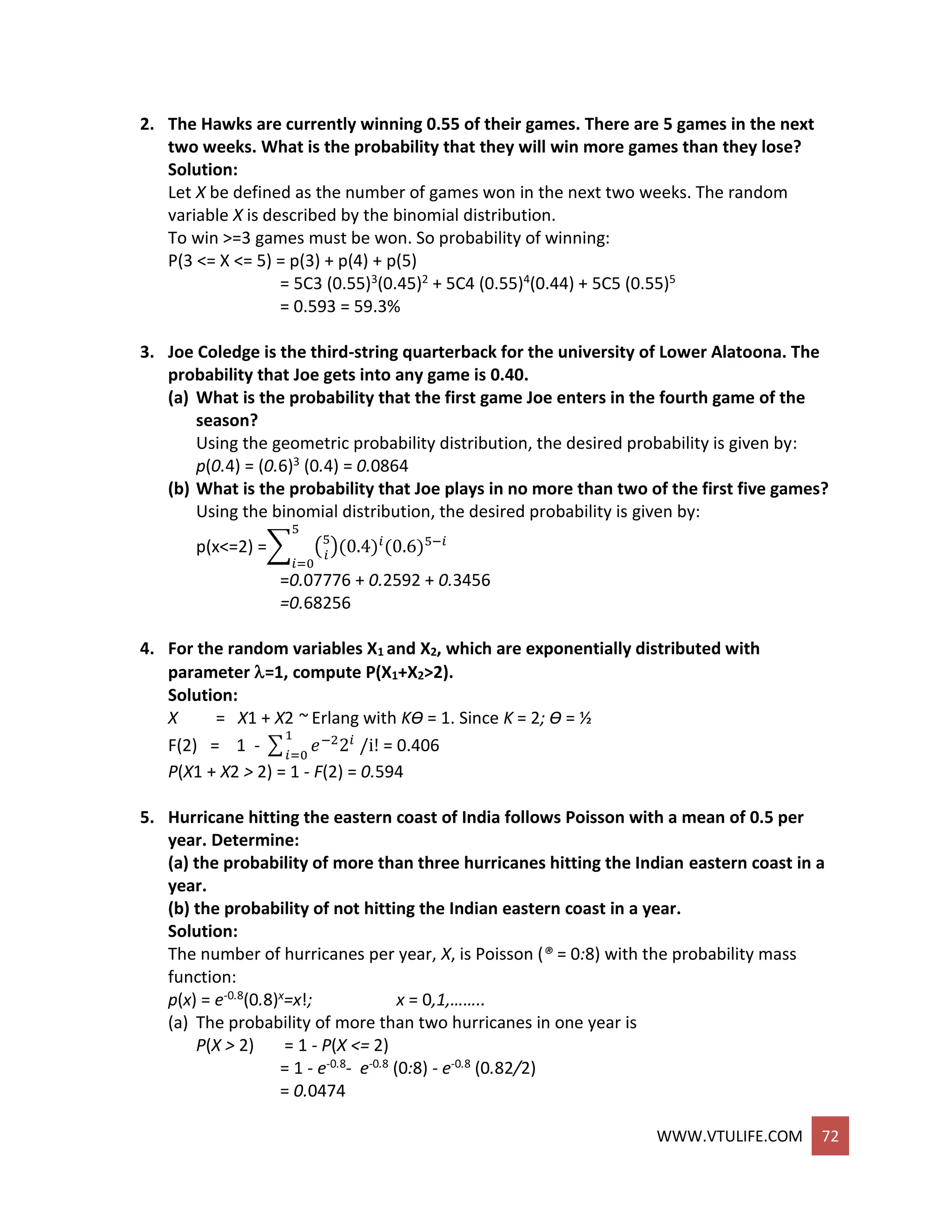
![WWW.VTULIFE.COM 73
(b) The probability of exactly one hurricane in one year is
p(1) = 0.3595
6. Records indicate that 1.8% of the entering students at a large state university drop out
of school by midterm. What is the probability that three or fewer students will drop
out of a random group of 200 entering students?
solution:
Using the Poisson approximation with the mean , given by
= np = 200(0.018) = 3.6
The probability that 0 <= x <= 3 students will drop out of school is given by
F(3)= ∑3
𝑥=0 (ex)/x! = 0.5148
7. A random variable X that has pmf given by p(x)=1/(n+1) over the range Rx= {0,1,2,…,n}
is said to have a discrete uniform distribution.
(a) Find the mean and variance of this distribution. Hint:
∑ 𝐢𝒏
𝒊=𝟎 = n(n+1)/2 and ∑ 𝒊 𝟐𝒏
𝒊=𝟎
= n(n+1)(2n+1)/6
(b) If Rx = {a,a+1,a+2,….,b} , compute the mean and variance of X.
Solution:
A random variable, X, has a discrete uniform distribution if its probability mass function
is
p(x) = 1=(n + 1) RX = {0, 1, 2, …., n}
(a) The mean and variance are found by using
(b) If RX = {a, a + 1, a + 2, …., b}, the mean and variance are
E(X) = a + (b - a)/2 = (a + b)/2
V (X) = [(b - a)2 + 2(b - a)]/12](https://image.slidesharecdn.com/systemmodelingandsimulationfullnotesbysushmashettywww-190706073931/75/System-modeling-and-simulation-full-notes-by-sushma-shetty-www-vtulife-com-73-2048.jpg)
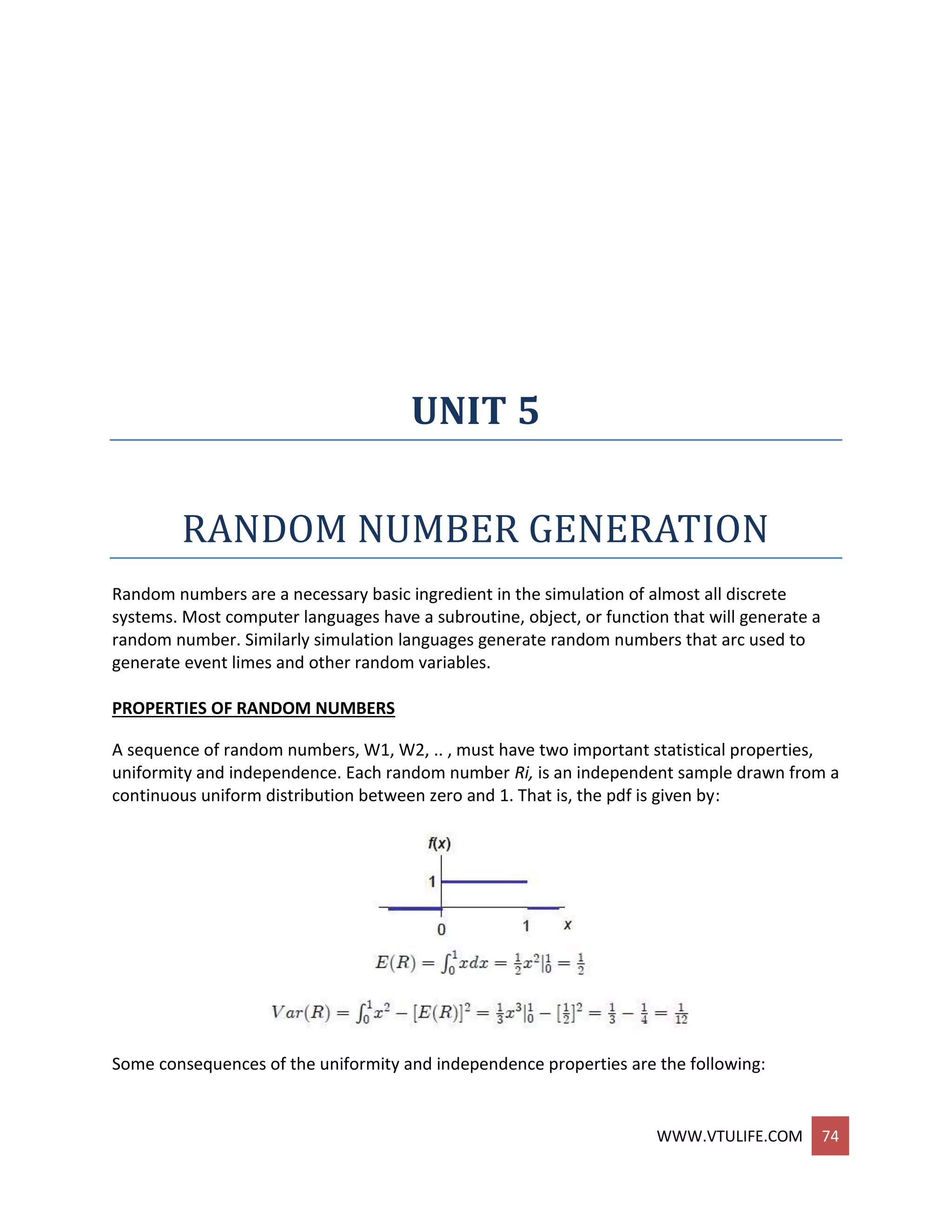
![WWW.VTULIFE.COM 75
If the interval [0,1] is divided into 8 subinterval of equal length, the expected number of
observations in each interval is N/n where N is the total number of observations.
The probability of observing a value in a particular interval is independent of the
previous values drawn.
GENERATION OF PSEUDO-RANDOM NUMBERS
Pseudo means false,so false random numbers are being generated. The goal of any generation
scheme, is to produce a sequence of numbers belween zero and 1 which simulates, or
initates, the ideal properties of uniform distribution and independence as closely as possible.
When generating pseudo-random numbers, certain problems or errors can occur. These
errors, or departures from ideal randomness, are all related to the properties stated previously.
Some examples include the following:
The generated numbers may not be uniformly distributed.
The generated numbers may be discrete -valued instead continuous valued.
The mean of the generated numbers may be too high or too low.
The variance of the generated numbers may be too high or low.
There may be dependence. The following are examples:
o Autocorrelation between numbers.
o Numbers successively higher or lower than adjacent numbers.
o Several numbers above the mean followed by several numbers below the mean.
Usually, pseudo-random numbers are generated by a computer as part of the simulation.
Numerous methods are available. In selecting a routine, there are a number of important
considerations.
The routine should be fast.
The routine should be platform independent and portable between different
programming languages.
The routine should have a sufficiently long cycle (much longer than the required number
of samples).
The random numbers should be replicable. Usefull for debugging and variance reduction
techniques.
Most importantly, the routine should closely approximate the ideal statistical
properties.
TECHNIQUES FOR GENERATING RANDOM NUMBERS
The linear congruential method is most widely known. Will also report an extension that yield
sequences with a longer period.
LINEAR CONGRUENTIAL METHOD:
Produces a sequence of integers, X1, X2,... between zero and m — 1 according to the
following recursive relationship:
Xi+1 = (a Xi + c) mod m i = 0,1, 2,...](https://image.slidesharecdn.com/systemmodelingandsimulationfullnotesbysushmashettywww-190706073931/75/System-modeling-and-simulation-full-notes-by-sushma-shetty-www-vtulife-com-75-2048.jpg)
![WWW.VTULIFE.COM 76
The initial value X0 is called the seed, a is called the constant multiplier, c is the
increment, and m is the modulus.
If c ≠ 0 in above equation, the form is called the mixed congruential method.
When c = 0, the form is known as the multiplicative congruential method. The selection
of the values for a, c, m and Xo drastically affects the statistical properties and the cycle
length.
Eg 1:
X0=27, a=17, c=43 and m=100
Here integer values will be between 0 and 99 because of the modulus m. Note that random
integers are being generated rather than random numbers. These integers should be uniformly
distributed. Convert to numbers in [0,1] by normalizing with modulus m:
Ri=Xi/m
The sequence of Xi and subsequent Ri values is computed as follows:
Of primary importance is uniformity and statistical independence. Of secondary importance is
maximum density and maximum period within the sequence:
Ri,i=1,2,….
Note that, the sequence can only take values in:
{0,1/m,2/m,(m-1)/m,1}
Thus Ri is discrete rather than continuous.
This is easy to fix by choosing large modulus m. Values such as m=231-1 and m=248 are in
common use in generators appearing in many simulation languages). Maximum Density and
Maximum period can be achieved by the proper choice of a,c,m and X0.
For m a power of 2, say m =2b and c ≠ 0, the longest possible period is P = m = 2b, which
is achieved provided that c is relatively prime to m (that is, the greatest common factor
of c and m i s l ), and =a = l+4k, where k is an integer.
For m a power of 2, say m =2b and c = 0, the longest possible period is P = m⁄4 = 2b-2,
which is achieved provided that the seed X0 is odd and the multiplier ,a, is given by
a=3+8K , for some K=0,1,..
For m a prime number and c=0, the longest possible period is P=m-1, which is achieved
provided that the multiplier , a, has the property that the smallest integer k such that
ak-1is divisible by m is k= m-1.
Eg 2:
Let m = 102 = 100, a = 19, c = 0, and X0 = 63, and generate a sequence c random integers using
Equation.](https://image.slidesharecdn.com/systemmodelingandsimulationfullnotesbysushmashettywww-190706073931/75/System-modeling-and-simulation-full-notes-by-sushma-shetty-www-vtulife-com-76-2048.jpg)
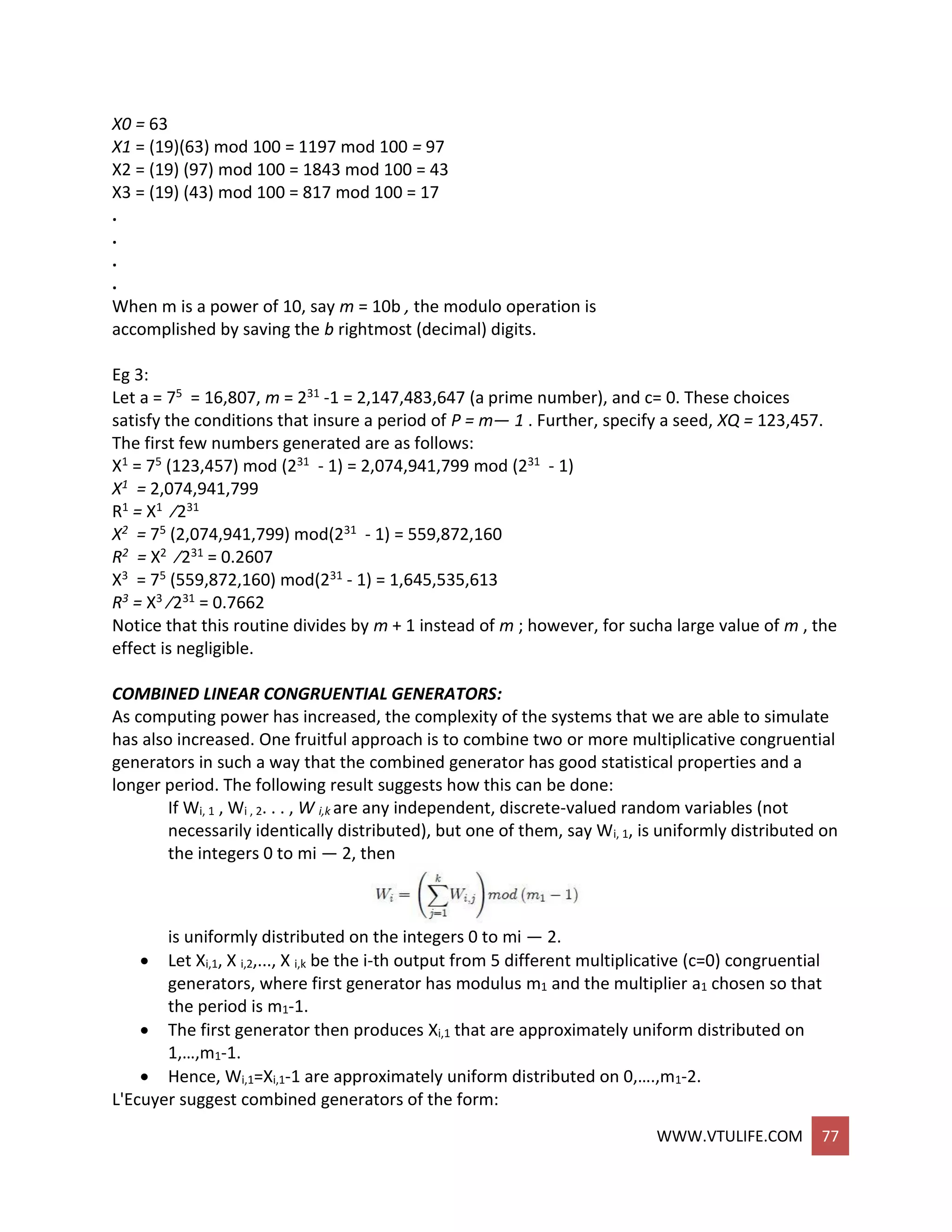
![WWW.VTULIFE.COM 78
Notice that the " (-1)j-1 "coefficient implicitly performs the subtraction X i,1-1; for example,
if k = 2, then (-1)°(Xi 1 - 1) - ( - l ) l ( X i 2 - 1)=Σ2 j=1( -1)
j-1 X i,j
The maximum possible period for such a generator is
(m1 − 1)(m2 − l ) … . . (mk − 1)
2^(k − 1)
which is achieved by the following generator.
Eg 1:
For 32-bit computers, L'Ecuyer [1988] suggests combining k = 2 generators with m1 =
2147483563, a1= 40014, m2 = 2147483399, and a2 =40692. This leads to the following
algorithm:
Select seed X1,0 in the range [1, 2147483562] for the first generator, and seed X2.o in the
range [1, 2147483398]. Set j =0.
Evaluate each individual generator.
X 1, j+1 = 40014X 1,j mod 2147483563
X2,j+i = 40692X2,j mod 2147483399
Set
Xj+1 = ( X 1, j+1 - X 2, j+1) mod 2147483562
Return
Rj+1 = Xj+1 ⁄ 2147483563 , X j+1 > 0
2147483563 / 2147483563. X j +1= 0
Set j = j + 1 and go to step 2.
TESTS FOR RANDOM NUMBERS
The desirable properties of random numbers — uniformity and independence.
To insure that these desirable properties are achieved, a number of tests can be performed (the
appropriate tests have already been conducted for most commercial simulation software).
The tests can be placed in two categories according to the properties of interest, the first entry
in the list below concerns testing for uniformity. The second through fifth entries concern
testing for independence.
The five types of tests:
Frequency Test: Uses the Kolmogorov-Smirnic or the Chi-Square Test to compare the
distribution of the set of numbers to a uniform distribution.](https://image.slidesharecdn.com/systemmodelingandsimulationfullnotesbysushmashettywww-190706073931/75/System-modeling-and-simulation-full-notes-by-sushma-shetty-www-vtulife-com-78-2048.jpg)
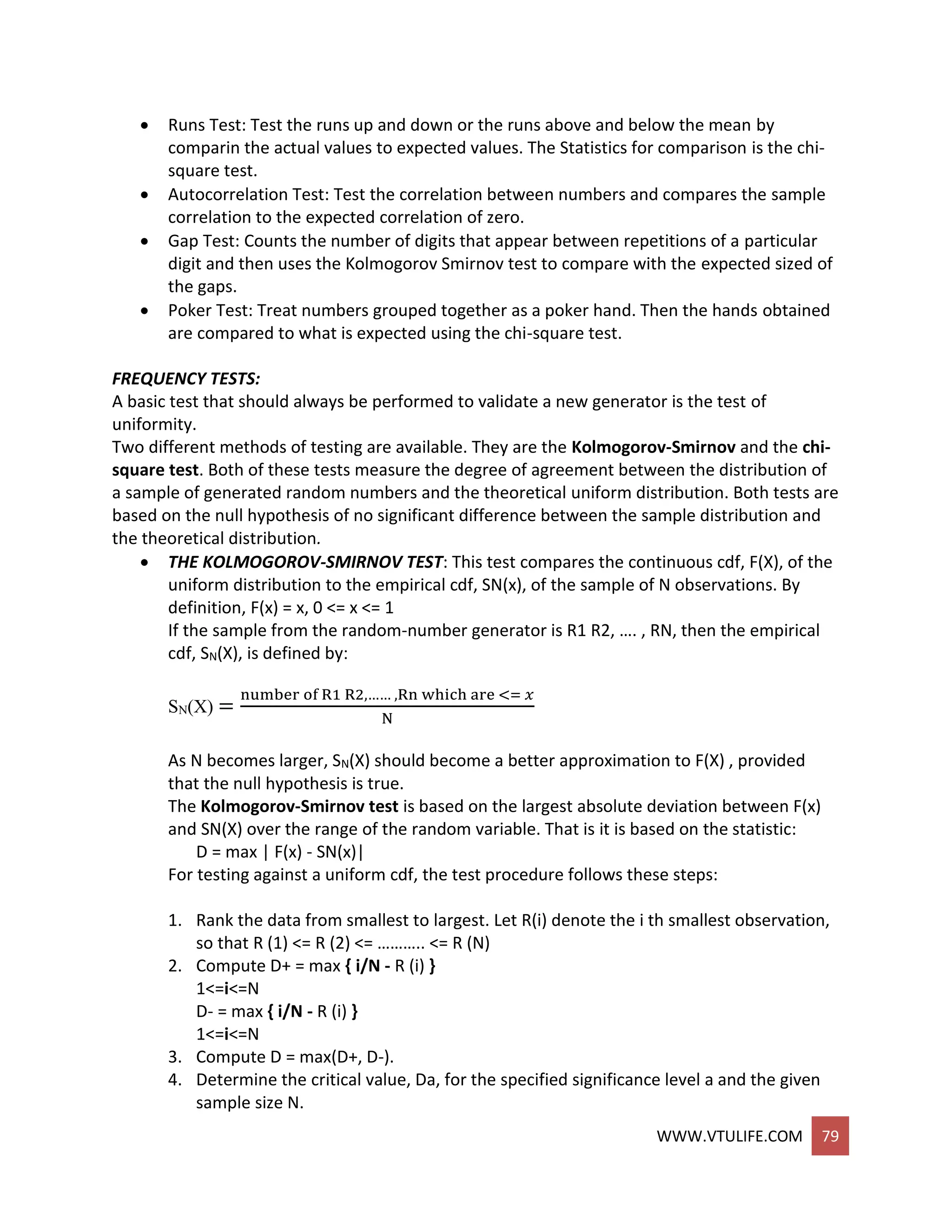
![WWW.VTULIFE.COM 80
5. If the sample statistic D is greater than the critical value, Da, the null hypothesis that
the data are a sample from a uniform distribution is rejected.
If D <= Da, conclude that no difference has been detected between the true distribution
of { R1 R2, ,…….., Rn } and the uniform distribution.
THE CHI-SQUARE TEST:
The chi-square test uses the sample statistic
Where Oi is the observed number in the i-th class, Ei is the expected number in the i-th
class, and n is the number of classes.
1. Determine Order Statistics
R(1)<=R(2)<=………<=R(N)
2. Divided Range R(N)-R(1) in n equidistant intervals [ai,bi], such that each interval
has at least 5 observations.
3. Calculate for i=1,…..,N.
4. Calculate
5. Determine for significant level , X2
,n-1
RUNS TESTS
RUNS UP AND RUNS DOWN:
Consider a generator that provided a set of 40 numbers in the following sequence:
0.08 0.09 0.23 0.29 0.42 0.55 0.58 0.72 0.89 0.91
0.11 0.16 0.18 0.31 0.41 0.53 0.71 0.73 0.74 0.84
0.02 0.09 0.30 0.32 0.45 0.47 0.69 0.74 0.91 0.95
0.12 0.13 0.29 0.36 0.38 0.54 0.68 0.86 0.88 0.91
Both the Kolmogorov-Smirnov test and the chi-square test would indicate that the numbers are
uniformly distributed. However, a glance at the ordering shows that the numbers are
successively larger in blocks of 10 values. If these numbers are rearranged as follows, there is
far less reason to doubt their independence:
0.41 0.68 0.89 0.84 0.74 0.91 0.55 0.71 0.36 0.30
0.09 0.72 0.86 0.08 0.54 0.02 0.11 0.29 0.16 0.18
0.88 0.91 0.95 0.69 0.09 0.38 0.23 0.32 0.91 0.53
0.31 0.42 0.73 0.12 0.74 0.45 0.13 0.47 0.58 0.29
The runs test examines the arrangement of numbers in a sequence to test the hypothesis of
independence.](https://image.slidesharecdn.com/systemmodelingandsimulationfullnotesbysushmashettywww-190706073931/75/System-modeling-and-simulation-full-notes-by-sushma-shetty-www-vtulife-com-80-2048.jpg)
![WWW.VTULIFE.COM 81
EXAMPLE 1: Series of coin Tosses
HTTHHTTTHT
Run 1 has length 1. Run 2 has lenght 2, Run 3 has length 2,
Run 4 has length 3, Run 5 has length 1, Run 6 has length 1.
TWO CONCERNS in a Runs Test:
o The number of Runs
o The length of the Runs.
An up run is a sequence of numbers which is succeeded by a larger number. A down run
is a sequence of numbers each of which is succeeded by a smaller number.
If N is the number of numbers in a sequence, the maximum number of runs is N — I and the
minimum number of runs is one.
If a is the total number of runs in a truly random sequence, the mean and variance of a are
given by
μa = 2N – 1 / 3 ------------(1)
and
σa
2 = 16N – 29 / 90 ------------(2)
For N > 20, the distribution of a is reasonably approximated by a normal distribution, N( μa , σ
a2) This approximation can be used to test the independence of numbers from a generator. In
that case the standardized normal test statistic is developed by subtracting the mean from the
observed number of runs, a , and dividing by the standard deviation. That is, the test statistic is
Z0 = a – μa / σa
Substituting Equation (1) for μa and the square root of Equation (2) for σa yields
Z0 = a - [( 2N - 1)/3] / sqrt((16N – 29) / 90 )
where Zo ~ N(0 1). Failure to reject the hypothesis of independence occur when
— Za/2 <= Zo <= Za/2
where a is the level of significance. The critical values and rejection region are shown in Figure:](https://image.slidesharecdn.com/systemmodelingandsimulationfullnotesbysushmashettywww-190706073931/75/System-modeling-and-simulation-full-notes-by-sushma-shetty-www-vtulife-com-81-2048.jpg)
![WWW.VTULIFE.COM 82
RUNS ABOVE AND BELOW THE MEAN:
Acceptance of the indepence following the previous test is necessary but not sufficient
condition. An independent sequence should not contain long runs with observations above the
mean and below the mean.
Let , the total number of runs (above or below the mean) and n1 be the number of observations
above the mean and n2 be the number of observations below the mean. Note that, the
maximum number of runs is N=n1+n2 and the minimum number of runs is 1.
Given n1 and n2
and if n1>20 or n2>20 , b is approximately normal distributed.
1. Calculate number of runs b,
2. Calculate
3. Determine acceptence region [Z-a/2,Za/2] from a N(0,1) distribution
4.
PROBLEMS
1. Generate random numbers using linear congruential method with X0=27, a=8, c=47,
m=100.
solution:
X1 = (8 X 27 + 47)mod 100 = 63; R1 = 63/100 = 0.63
X2 = (8 X 63 + 47)mod 100 = 51; R2 = 51/100 = 0.51
X3 = (8 X 51 + 47)mod 100 = 55; R3 = 55/100 = 0.55](https://image.slidesharecdn.com/systemmodelingandsimulationfullnotesbysushmashettywww-190706073931/75/System-modeling-and-simulation-full-notes-by-sushma-shetty-www-vtulife-com-82-2048.jpg)
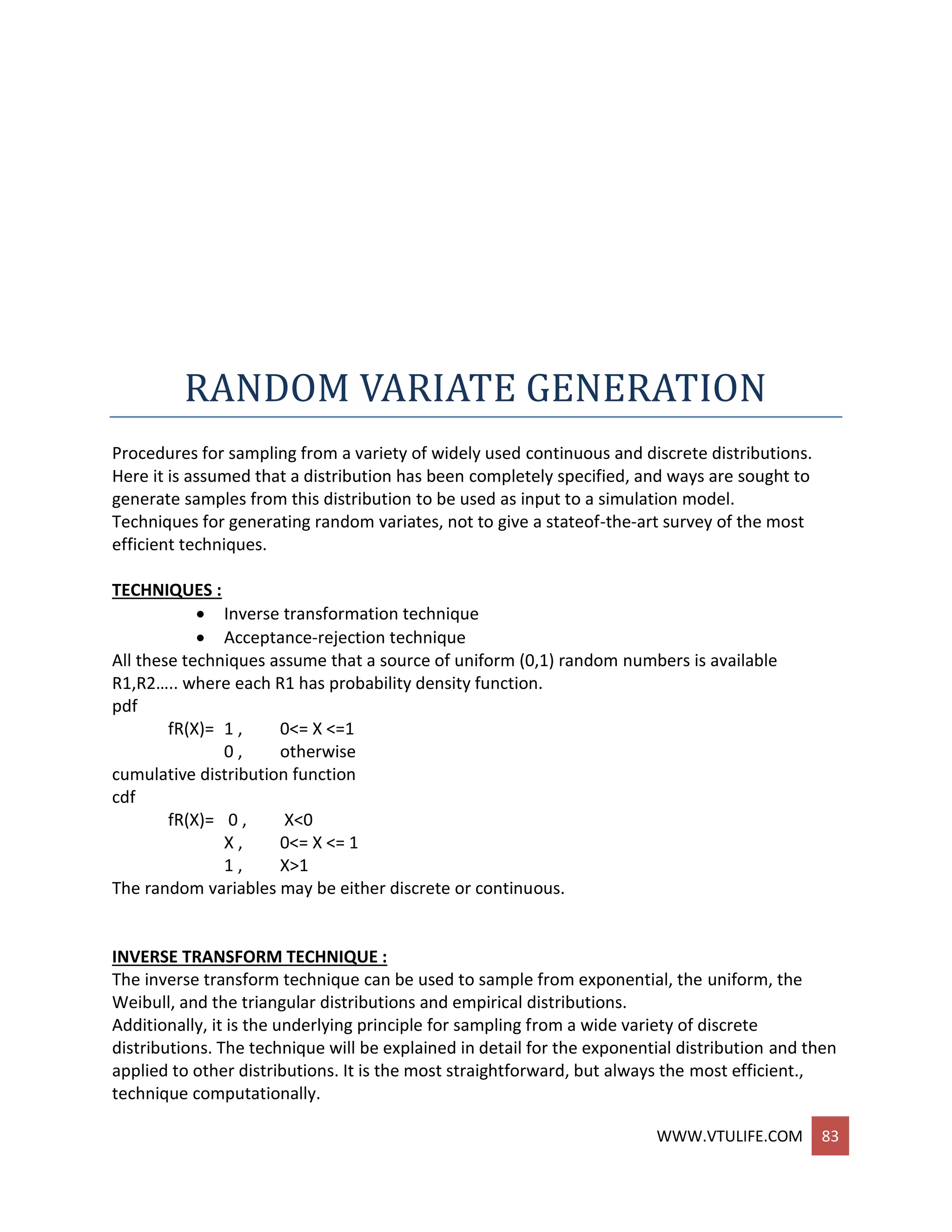

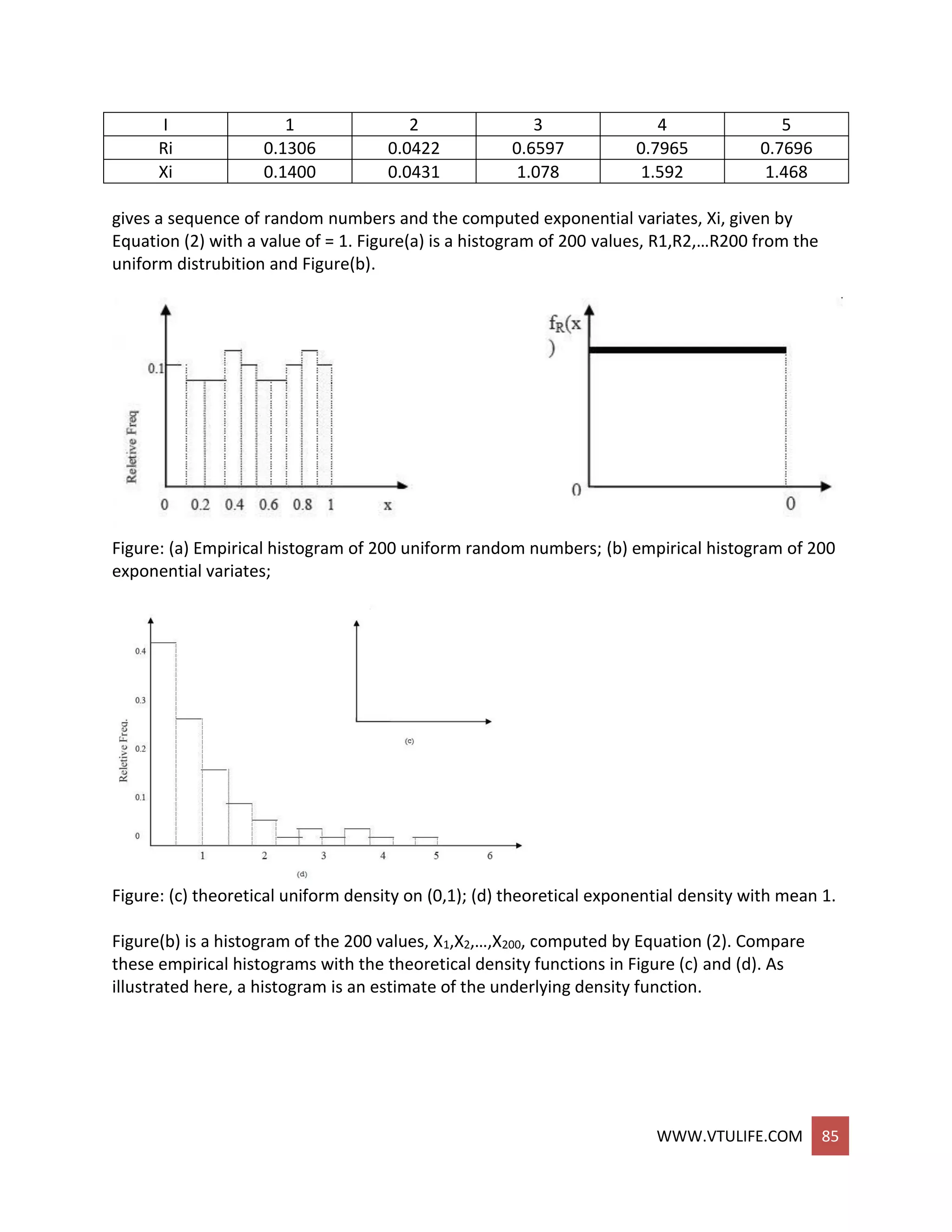
![WWW.VTULIFE.COM 86
Figure2. Graphical view of the inverse transform technique
Figure2 gives a graphical interpretation of the inverse transform technique. The cdf shown is
F(x) = 1- e an exponential distribution with rate . To generate a valueX1 with cdf F(X), first a
random number Ri between 0 and 1 is generated, a horizontal line is drawn from R1 to the
graph of the cdf, then a vertical line is dropped to the x -axis to obtain X1, the desired result.
Notice the inverse relation between R1 and X1, namely
Ri = 1 – e –X1
and
X1 = -ln ( 1 – R1 )
In general, the relation is written as
R1 = F ( X 1 )
and
X1 = F -1 ( R1)
Pick a value JCQ and compute the cumulative probability
P(X1 < x0) = P(R1 < F(x0)) = F(X0) ------------(4)
To see the first equality in Equation (4), refer to Figure 2, where the fixed numbers x0
and F(X0) are drawn on their respective axes. It can be seen that X1 < xo when and only
when R1 < F(X0). Since 0 < F(xo) < 1, the second equality in Equation (4) follows
immediately from the fact that R is uniformly distributed on (0,1). Equation (4)
shows that the cdf of X1 is F; hence, X1 has the desired distribution.
UNIFORM DISTRIBUTION :
Consider a random variable X that is uniformly distributed on the interval [a, b]. A reasonable
guess for generating X is given by
X = a + (b - a)R -----------------(5)
R is always a random number on (0,1). The pdf of X is given by
f (x) = 1/ ( b-a ), a ≤ x ≤ b
0, otherwise
The derivation of Equation (5) follows steps 1 through 3 of Exponential Distribution:
1. The cdf is given by
F(x) = 0, x < a](https://image.slidesharecdn.com/systemmodelingandsimulationfullnotesbysushmashettywww-190706073931/75/System-modeling-and-simulation-full-notes-by-sushma-shetty-www-vtulife-com-86-2048.jpg)
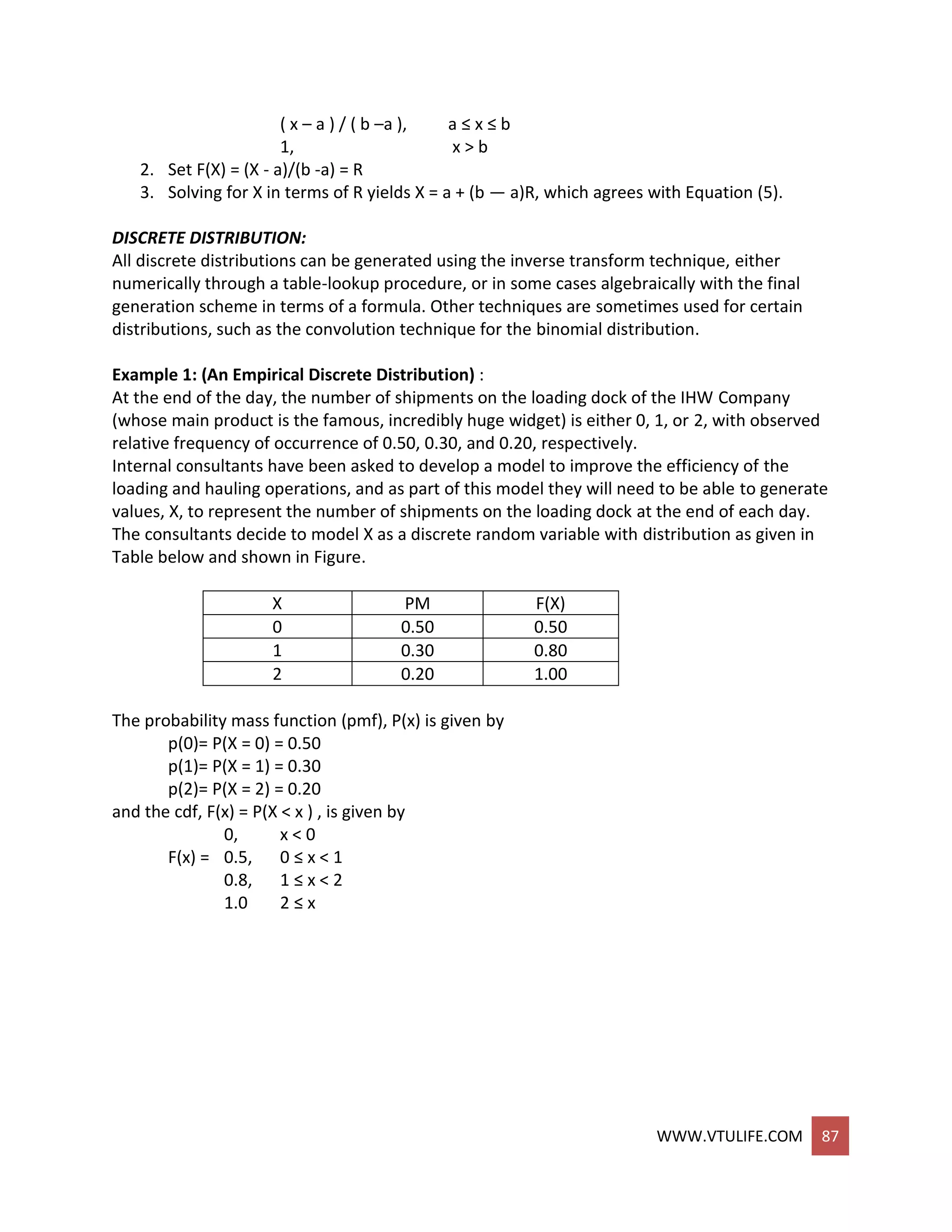
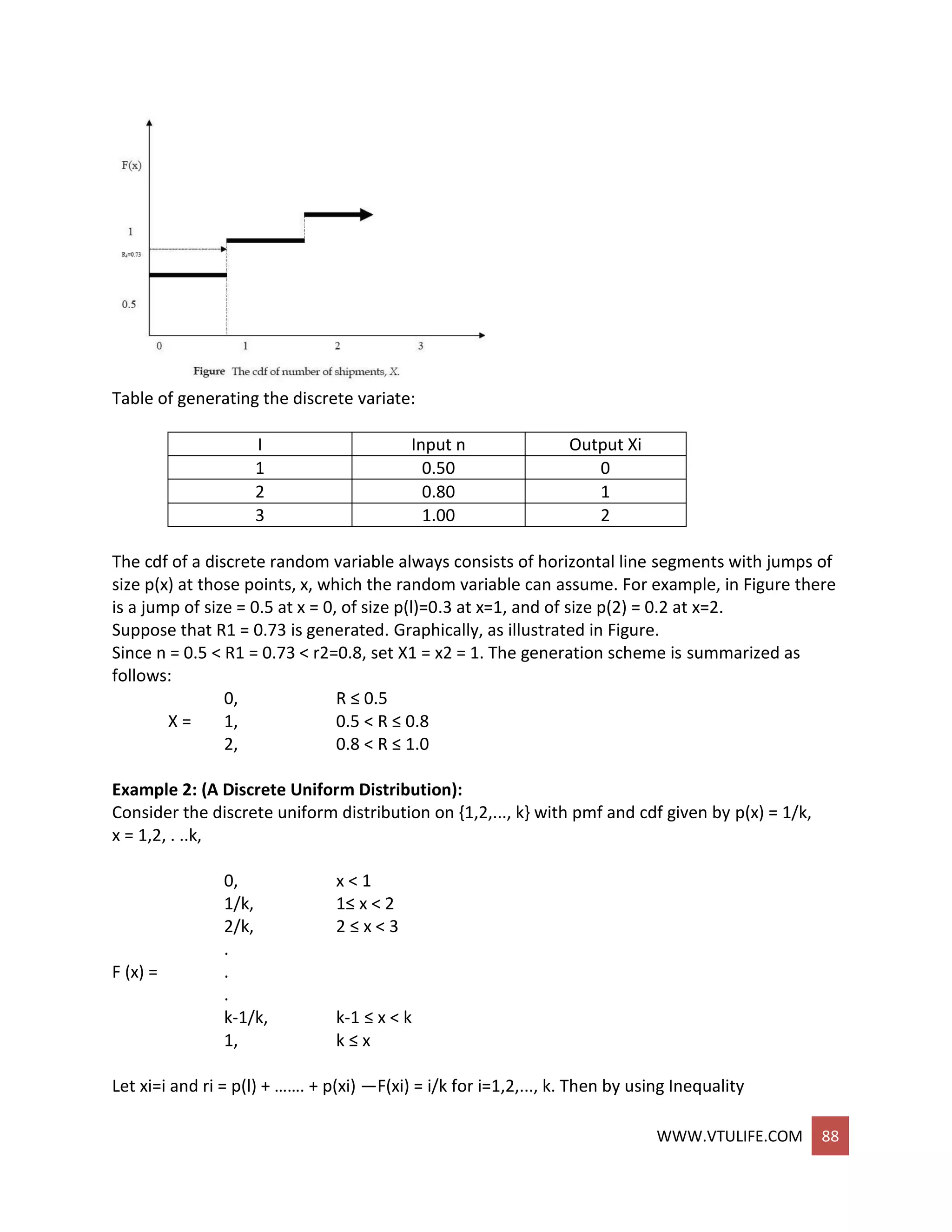
![WWW.VTULIFE.COM 89
F (xi-1) = ri-1 < R ≤ ri = F(xi) ------------(1)
it can be seen that if the generated random number R satisfies
R i-1 = i-1 / k < R ≤ ri = i/k ------------(2)
then X is generated by setting X = i . Now, Inequality (2) can be solved for j:
i – 1 < Rk ≤ i
Rk ≤ i < Rk +1 -----------(3)
Let [y] denote the smallest integer > y. For example, [7.82] = 8, [5.13] = 6 and [-1,32] = -1.
For y>0, [y] is a function that rounds up. This notation and Inequality (3) yield a formula for
generating X, namely
X = ┌ R k┐ -----------(4)
For example, consider generating a random variate X, uniformly distributed on {1,2,..., 10}. The
variate, X, might represent the number of pallets to be loaded onto a truck. Using Table A.I as a
source of random numbers, R, and Equation (4) with k = 10 yields This procedure can be
modified to generate a discrete uniform random variate with any range consisting of
consecutive integers. Exercise 13 asks the student to devise a procedure for one such case.
Example 3: (The Geometric Distribution):
Consider the geometric distribution with pmf
p(x) = p ( l - p ) x , x = 0,1,2,...
where 0 < p < 1. Its cdf is given by
F(x) = Σx
j=0 p(1 – p)j
= p{1- (1- p)x+1 } / 1 – (1 – p)
= 1 – ( 1 – p)x+1
for x = 0, 1, 2, ... Using the inverse transform technique, a geometric random variable X will
assume the value x whenever
F(x - 1) = 1 - (1 –p)x < R < 1 - (1 – p) x+1 = F(x) -----------(1)
where R is a generated random number assumed 0 < R <1. Solving Inequality (1) for x
proceeds as follows:
(1-p)x+1 ≤ 1 – R < ( 1 – p )x
( x + 1)ln (1 – p) ≤ ln (1 – R ) < x ln(1 – p)
But 1 – p < 1 implies that ln(1-p) < 0. so that
Ln ( 1 –R ) / ln ( 1 –p ) -1 ≤ x < ln(1 – R) / ln (1 – p) ------------(2)
Thus, X=x for that integer value of x satisfying Inequality (2) or in brief using the round-up
function ┌ .┐
X = ln (1 – R ) / ln (1 – p ) – 1 ------------(3)
Since p is a fixed parameter, let = —l/ln(l — p). Then > 0 and, by Equation (3), X = [-]. It is an
exponentially distributed random variable with mean , so that one way of generating a
geometric variate with parameter p is to generate (by any method) an exponential variate with
parameter, subtract one, and round up.Occasionally, a geometric variate X is needed which can
assume values {q, q + 1, q + 2,...} with pmf p(x) = p(1 - p) (x = q, q+1,...). Such a variate, X can be
generated, using Equation (3), by X = q + ln (1-R)/ ln(1 – p) -1
One of the most common cases is q = 1.
ACCEPTANCE-REJECTION TECHNIQUE :](https://image.slidesharecdn.com/systemmodelingandsimulationfullnotesbysushmashettywww-190706073931/75/System-modeling-and-simulation-full-notes-by-sushma-shetty-www-vtulife-com-89-2048.jpg)
![WWW.VTULIFE.COM 90
Suppose that an analyst needed to devise a method for generating random variates, X,
uniformly distributed between 1/4 and 1. One way to proceed would be to follow these steps:
1. Generate a random number R.
2. (a) If R > 1/4, accept X = /?, then go to step 3.
(b) If R < 1/4, reject /?, and return to step 1.
3. If another uniform random variate on [1/4,1] is needed, repeat the procedure beginning
at step 1. If not, stop.
Each time step 1 is executed, a new random number R must be generated. Step 2a is an
“acceptance” and step 2b is a "rejection" in this acceptancerejection technique. To summarize
the technique, random variates (R) with some distribution (here uniform on [0,1]) are
generated until some condition (R > 1/4) is satisfied. When the condition is finally satisfied, the
desired random variate, X (here uniform on [1/4,1]), can be computed (X = R). This procedure
can be shown to be correct by recognizing that the accepted values of R are conditioned values;
that is, R itself does not have the desired distribution, but R conditioned on the event {R > 1/4}
does have the desired distribution. To show this, take 1/4 < a < b < 1; then
P ( a < R ≤ b | . ≤ R ≤ 1 ) = P (a < R ≤ b ) / P ( . ≤ R ≤ 1 ) = b – a / 3/4 ----------(1)
which is the correct probability for a uniform distribution on [1/4, 1]. Equation (1) says that the
probability distribution of /?, given that R is between 1/4 and 1 (all other values of R are thrown
out), is the desired distribution. Therefore, if 1/4 < R < 1, set X = R.
POISSON DISTRIBUTION :
A Poisson random variable, N, with mean a > 0 has pmf
p(n) = P(N = n) = e-α αn/ n! , n = 0,1,2,…….
but more important, N can be interpreted as the number of arrivals from a Poisson arrival
process in one unit of time. Recall that the inter- arrival times, A1, A2,... of successive
customers are exponentially distributed with rate a (i.e., a is the mean number of arrivals per
unit time); in addition, an exponential variate can be generated. There is a relationship between
the (discrete) Poisson distribution and the (continuous) exponential distribution, namely
N = n ----------------------(1)
if and only if
A1 + A2 + …………+ An ≤ 1 < A1 + ….. + An + An+1 ----------------------(2)
Equation (1)/N = n,
says there were exactly n arrivals during one unit of time; but relation (2) says that the nth
arrival occurred before time 1 while the (n + l)st arrival occurred after time l) Clearly, these two
statements are equivalent. Proceed now by generating exponential interarrival times until
some arrival, say n + 1, occurs after time 1; then set N = n.
For efficient generation purposes, relation (2) is simplified.
Ai= (—1/ α )ln Ri, to obtain
Σ i=1n – 1/α ln Ri ≤ 1 < Σn+1i=1 -1/α ln Ri
Next multiply through by reverses the sign of the inequality, and use the fact that a sum of
logarithms is the logarithm of a product, to get
ln Πni=1 Ri = Σni=1 ln Ri ≥ - α > Σn+1i=1 ln Ri = ln Πn+1i=1 Ri
Finally, use the relation elnx=x for any number x to obtain
Πn i=1 Ri ≥ e-α > Πn+1 i=1 Ri ------------------------(3)](https://image.slidesharecdn.com/systemmodelingandsimulationfullnotesbysushmashettywww-190706073931/75/System-modeling-and-simulation-full-notes-by-sushma-shetty-www-vtulife-com-90-2048.jpg)
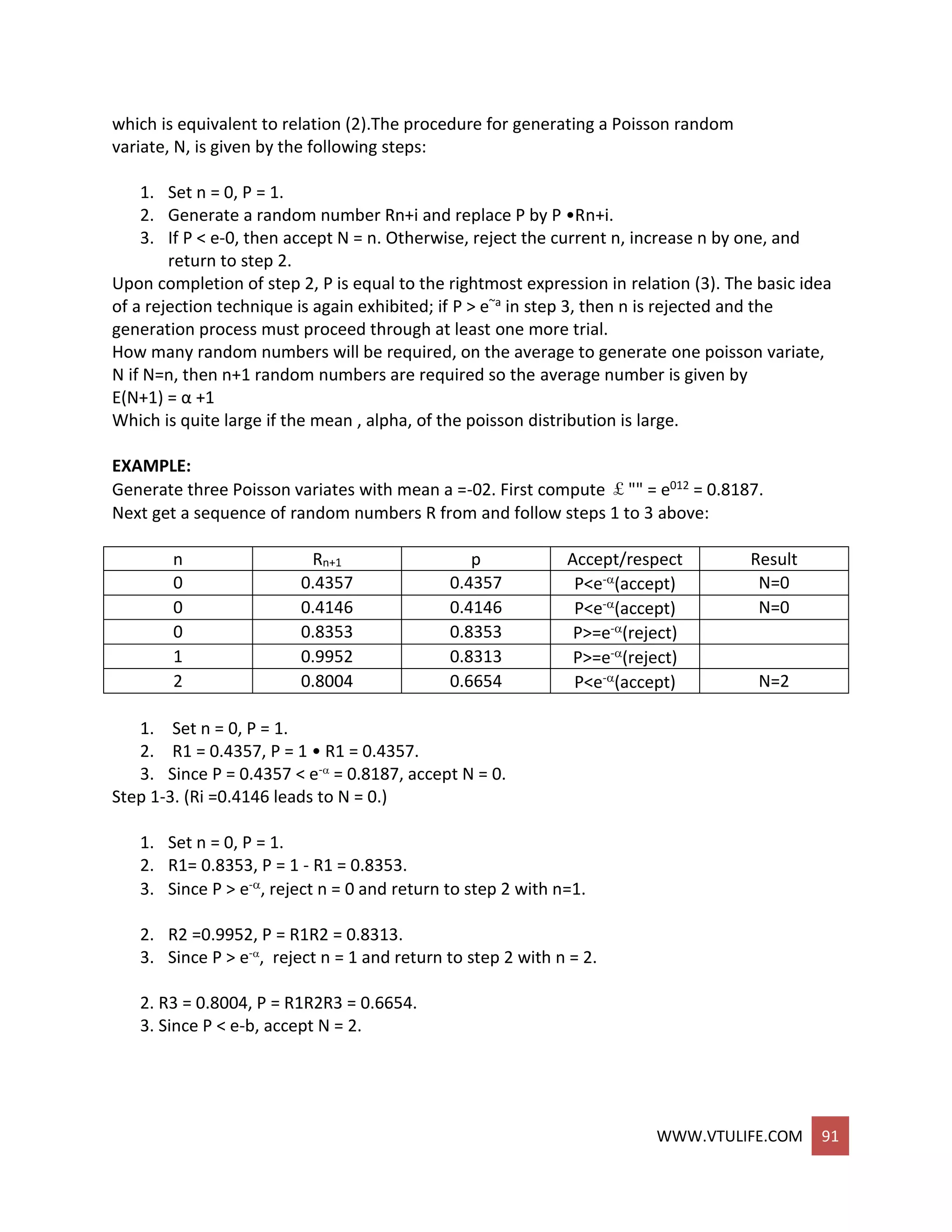
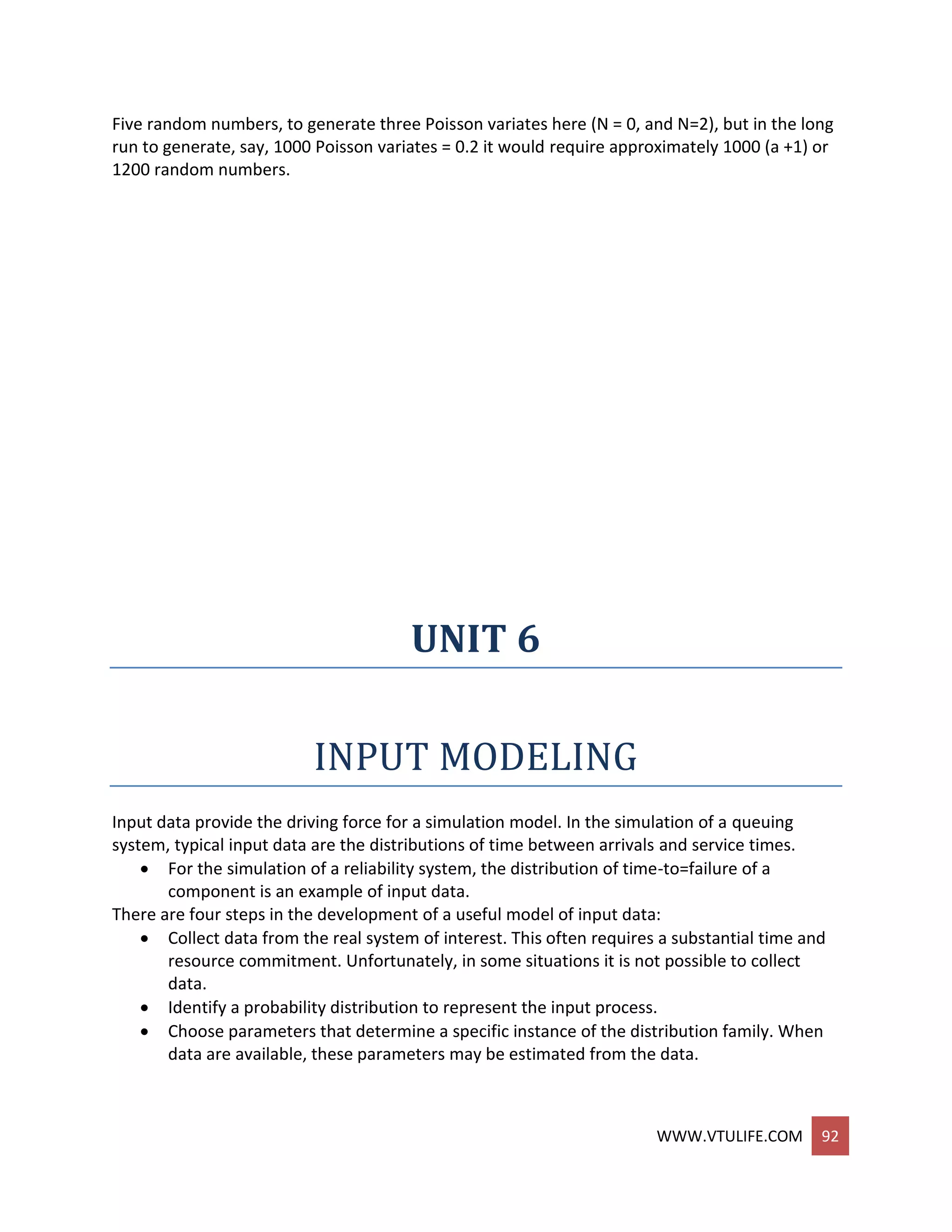
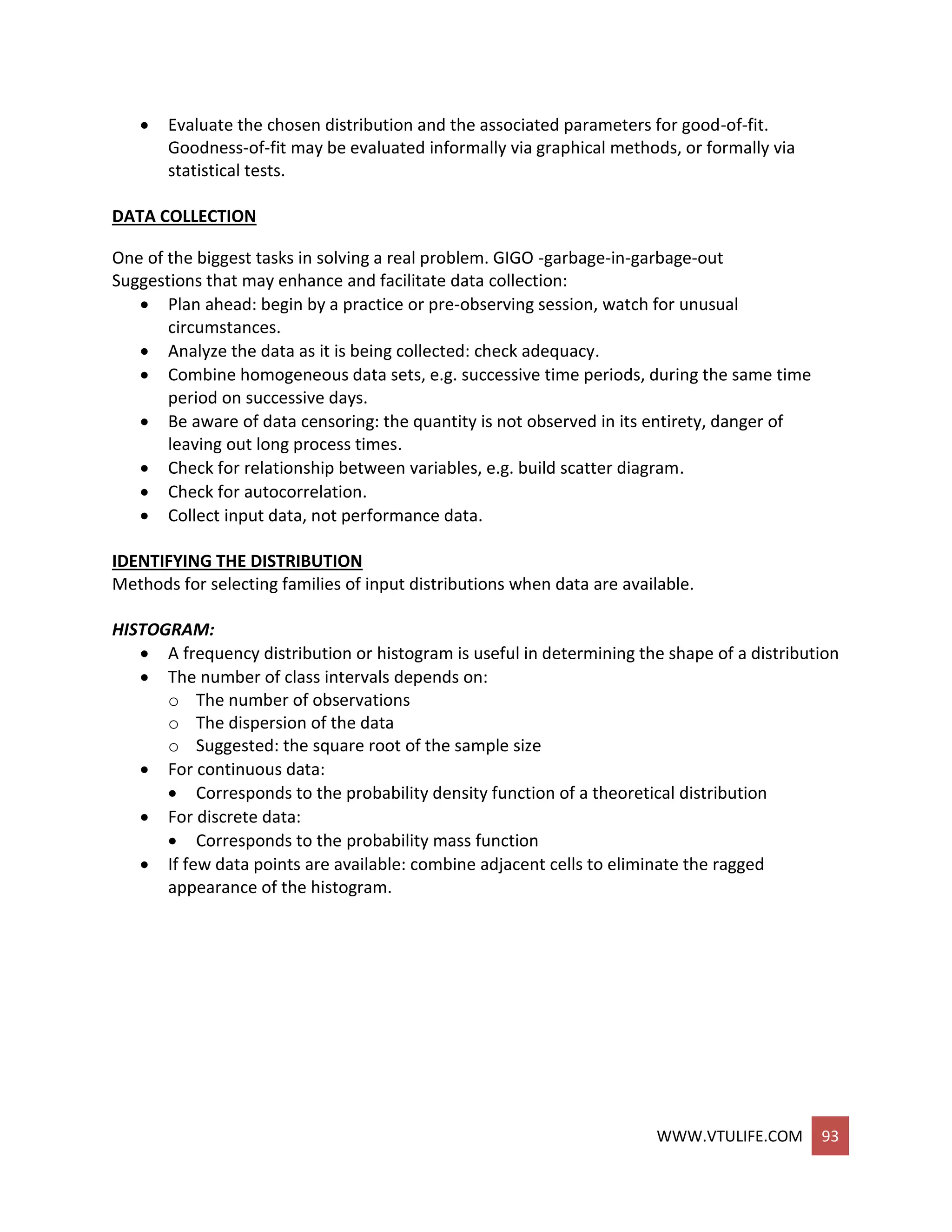
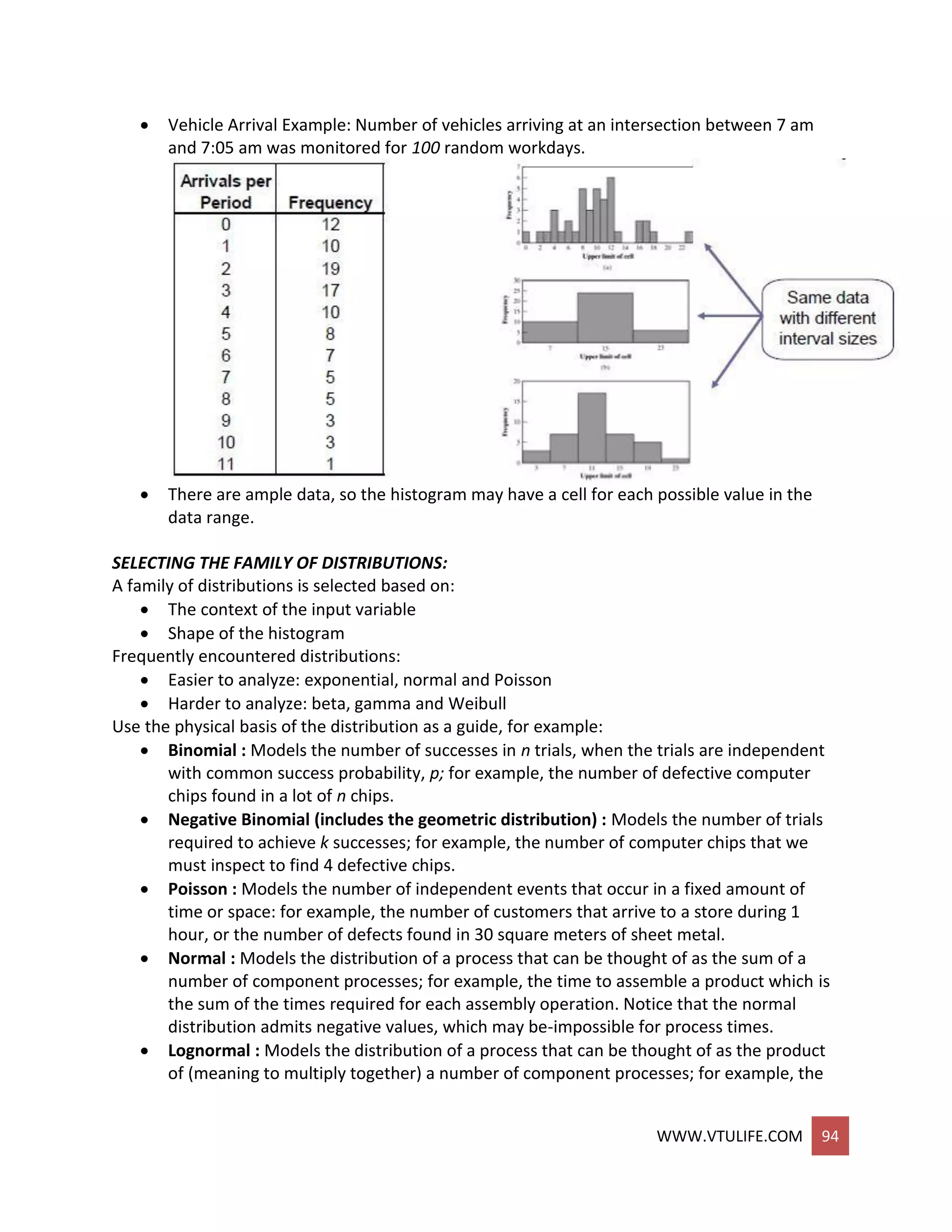
![WWW.VTULIFE.COM 95
rate of return on an investment, when interest is compounded, is the product of the
returns for a number of periods.
Exponential : Models the time between independent events, or a process time which is
memoryless (knowing how much time has passed gives no information about how much
additional time will pass before the process is complete); for example, the times
between the arrivals of a large number of customers who act independently of each
other.
Gamma : An extremely flexible distribution used to model nonnegative random
variables. The gamma can be shifted away from 0 by adding a constant.
Beta : An extremely flexible distribution used to model bounded (fixed upper and lower
limits) random variables. The beta can be shifted away from 0 by adding a constant and
can have a larger range than [0,1] by multiplying by a constant.
Erlang : Models processes that can be viewed as the sum of several exponentially
distributed processes; for example, a computer network fails when a computer and two
backup computers fail, and each has a time to failure that is exponentially distributed.
The Erlang is a special case of the gamma.
Weibull : Models the time to failure for components; for example, the time to failure for
a disk drive. The exponential is a special case of the Weibull.
Discrete or Continuous Uniform Models complete uncertainty , since all outcomes are
equally likely. This distribution is often overused when there are no data.
Triangular Models a process when only the rninimum, most-likely, and maximum values
of the distribution are known; for example, the minimum, most- likely, and maximum
time required to test a product.
Empirical Resamples from the actual data collected; often used when no theoretical
distribution seems appropriate.
QUANTILE-QUANTILE PLOTS:
Q-Q plot is a useful tool for evaluating distribution fit.
If X is a random variable with cdf F, then the q-quantile of X is the γ such that
F(γ ) = P(X ≤ γ ) = q, for 0 < q < 1
When F has an inverse, γ = F-1(q)
Let {xi, i = 1,2, …., n} be a sample of data from X and {yj, j = 1,2,…, n} be the observations
in ascending order:
Yj is approximately F-1
((j-0.5)/n).
where j is the ranking or order number.
The plot of Yj versus F-1 is
o Approximately a straight line if F is a member of an appropriate family of
distributions.
o The line has slope 1 if F is a member of an appropriate family of distributions with
appropriate parameter values.
Example: Check whether the door installation times follows a normal distribution.
The observations are now ordered from smallest to largest:](https://image.slidesharecdn.com/systemmodelingandsimulationfullnotesbysushmashettywww-190706073931/75/System-modeling-and-simulation-full-notes-by-sushma-shetty-www-vtulife-com-95-2048.jpg)
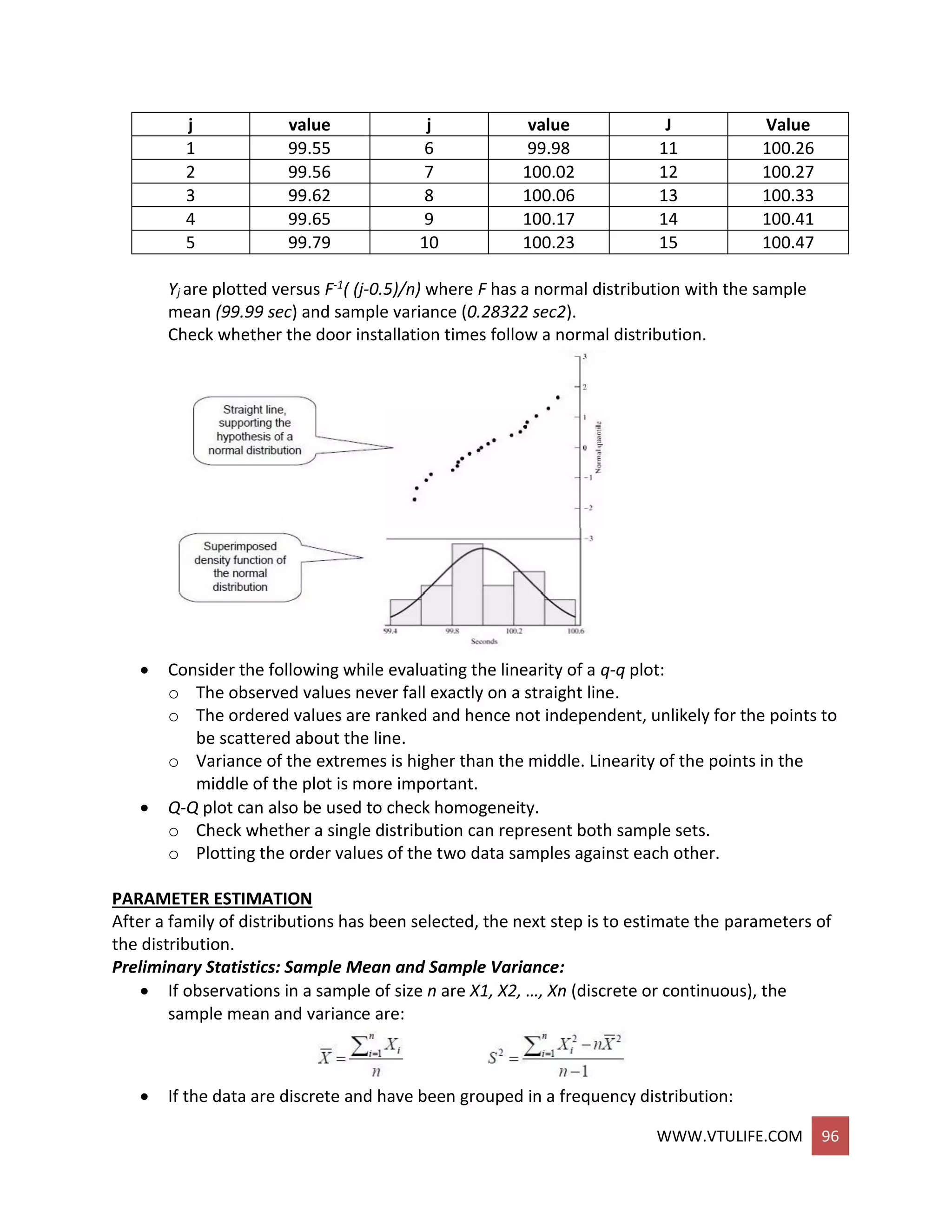
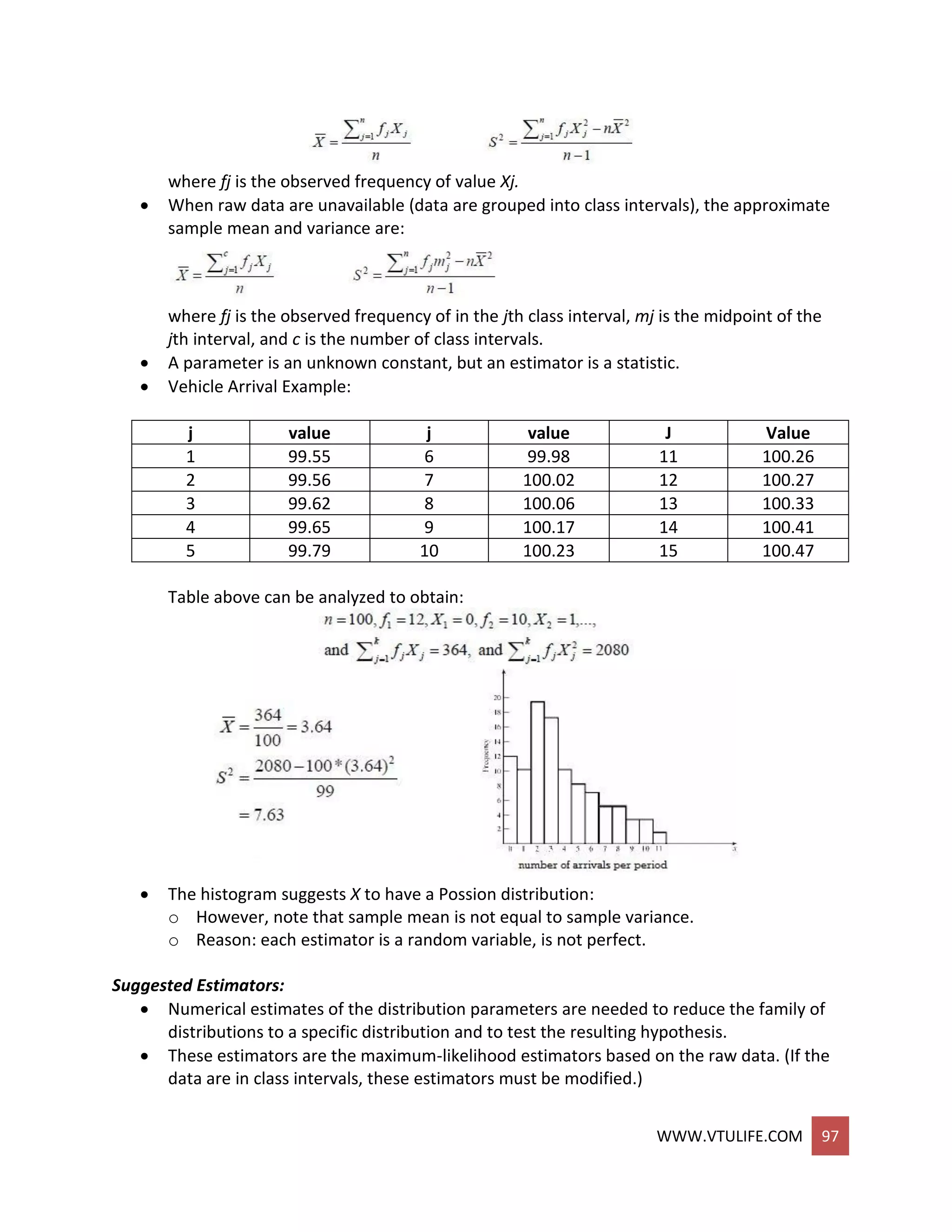

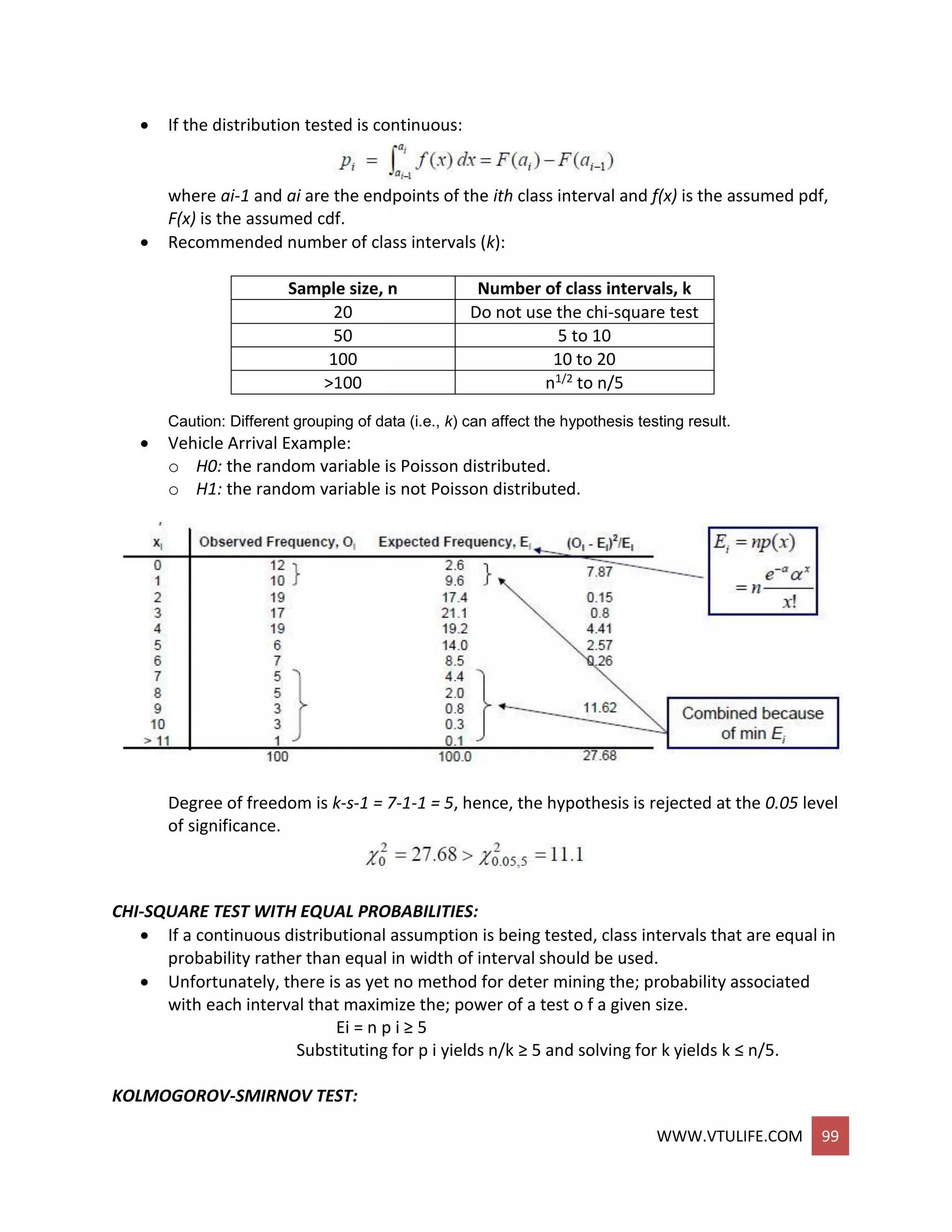
![WWW.VTULIFE.COM
10
0
Formalize the idea behind examining a q-q plot.
The test compares the continuous cdf, F(x), of the hypothesized distribution with the
empirical cdf, SN(x), of the N sample observations.
Based on the maximum difference statistics:
D = max| F(x) - SN(x)|
A more powerful test, particularly useful when:
o Sample sizes are small,
o No parameters have been estimated from the data.
When parameter estimates have been made:
o Critical values if biased, too large.
o More conservative, i.e., smaller Type I error than specified.
Suppose that 50 interarriaval times (in minutes) are collected over the following 100
minute interval (arranged in order of occurrence) :
0.44 0.53 2.04 2.74 2.00 0.30 2.54 0.52 2.02 1.89 1.53 0.21
2.80 0.04 1.35 8.32 2.34 1.95 0.10 1.42 0.46 0.07 1.09 0.76
5.55 3.93 1.07 2.26 2.88 0.67 1.12 0.26 4.57 5.37 0.12 3.19
1.63 1.46 1.08 2.06 0.85 0.83 2.44 2.11 3.15 2.90 6.58 0.64
Ho : the interarrival times are exponentially distributed
H1: the interarrival times are not exponentially distributed
The data were collected over the interval 0 to T = 100 min. It can be shown that if the
underlying distribution of interarrival times { T1, T2, … } is exponential, the arrival times
are uniformly distributed on the interval (0,T).
The arrival times T1, T1+T2, T1+T2+T3,…..,T1+…..+T50 are obtained by adding
interarrival times.
On a (0,1) interval, the points will be [T1/T, (T1+T2)/T,…..,(T1+….+T50)/T].
0.0044 O.0097 0.0301 0.0575 0.0775 0.0805 0.1059 0.1111 0.1313 0.1502
0.1655 0.1676 0.1956 0.1960 0.2095 0.2927 0.3161 0.3356 0.3366 0.3508
0.3553 0.3561 0.3670 0.3746 0.4300 0.4694 0.4796 0.5027 0.5315 0.5382
0.5494 0.5520 0.5977 0.6514 0.6526 0.6845 0.7008 0.7154 0.7262 0.7468
0.7553 0.7636 0.7880 0.7982 0.8206 0.8417 0.8732 0.9022 0.9680 0.9744
P-VALUES AND “BEST FITS”:
p-value for the test statistics
o The significance level at which one would just reject H0 for the given test statistic
value.
o A measure of fit, the larger the better
o Large p-value: good fit
o Small p-value: poor fit
Vehicle Arrival Example:
o H0: data is Possion](https://image.slidesharecdn.com/systemmodelingandsimulationfullnotesbysushmashettywww-190706073931/75/System-modeling-and-simulation-full-notes-by-sushma-shetty-www-vtulife-com-100-2048.jpg)
![WWW.VTULIFE.COM
10
1
o Test statistics: χ0
2=27.68 , with 5 degrees of freedom p-value = 0.00004, meaning
we would reject H0 with 0.00004 significance level, hence Poisson is a poor fit.
Many software use p-value as the ranking measure to automatically determine the
“best fit”. Things to be cautious about:
o Software may not know about the physical basis of the data, distribution families it
suggests may be inappropriate.
o Close conformance to the data does not always lead to the most appropriate input
model.
o p-value does not say much about where the lack of fit occurs.
Recommended: always inspect the automatic selection using graphical methods.
FITTING A NON-STATIONARY POISSON PROCESS:
Fitting a NSPP to arrival data is difficult, possible approaches:
Fit a very flexible model with lots of parameters or
Approximate constant arrival rate over some basic interval of time, but vary it from time
interval to time interval.
Suppose we need to model arrivals over time [0,T], our approach is the most appropriate when
we can:
Observe the time period repeatedly and
Count arrivals / record arrival times.
The estimated arrival rate during the ith time period is:
where n = number of observation periods, Δt = time interval length
Cij = number of arrivals during the ith time interval on the jth observation period
Example: Divide a 10-hour business day [8am,6pm] into equal intervals k = 20 whose length Δt =
½, and observe over n =3 days
SELECTING INPUT MODEL WITHOUT DATA:
If data is not available, some possible sources to obtain information about the process are:
Engineering data: often product or process has performance ratings provided by the
manufacturer or company rules specify time or production standards.](https://image.slidesharecdn.com/systemmodelingandsimulationfullnotesbysushmashettywww-190706073931/75/System-modeling-and-simulation-full-notes-by-sushma-shetty-www-vtulife-com-101-2048.jpg)
